— Welcome to — The Ultimate Guide to SEO Content Writing!
Open table of Contents
Whether you’re an experienced web writer or just starting out, SEO content writing is a must-have skill for anyone who writes for the web.
This guide will take you through the nuts and bolts of what SEO content writing is, the practical skills you’ll need to write SEO content, and how to build your career as an SEO copywriter.
We’ve compiled up-to-the-minute SEO tips and techniques that are being used in the web industry today. With this guide, you can learn the necessary skills to get started as a successful SEO copywriter without the trial and error of piecing it together yourself.
Let’s get started.

What Is SEO Content Writing?
SEO content writing is the process of creating high-quality content for websites that is relevant to readers and helps websites get found more easily by search engines.
The term “content” refers to any words, images, audio, or other elements you include on a webpage.
SEO content writing specifically deals with the words that are published on a webpage.
On the surface level, the goal of SEO content writing is to boost traffic to a company’s website that comes from Google or other search engines.
But it’s far more than that.
When it’s done well, SEO content writing can be used to create a website that’s truly an asset to a business. With effective SEO content, a company can build authority and influence in their field, as well as increase their visibility on the web.
SEO content writing can also help turn a website into a useful resource for visitors and potential customers. This can make a company’s site more “shareable” and respected by other websites and businesses.
In addition, all traffic to a website is not created equal. The use of core SEO principles will prevent “tire kickers” from visiting a site — in other words, visitors who have no real purpose on that site.
Content that has been SEO optimized will target a specific audience of people who are looking for what a company offers. A well-optimized website’s traffic may actually be low compared to some sites, but the visitors who do reach the site are high quality and much more likely to make a purchase.
What Is an SEO Content Writer?
An SEO content writer is someone who understands how to write website content that meets the needs of searchers, search engines, and businesses.
Like all good writing, SEO content writing starts with understanding your audience.
And this is where SEO content writers come in.
They intimately know the specific needs of each of the main players involved in the success of a website and how to cater to these needs. The main players include searchers, search engines, and businesses.
1. Searchers
Every time someone types a query into a search engine, they have a specific intent for that search. Their intent typically falls into one of four categories: general research, product comparison, wanting to make a purchase, or looking for support after a purchase.
An SEO content writer knows the best content to create based on each of these intents.
2. Search Engines
Like other websites, a search engine wants to attract as many visitors to their site as possible. The way they do this is by providing searchers with high-quality search results.
SEO content writers have the skills to make a webpage easy to find in the eyes of a search engine, which helps the search engines find quality sites to share with their users.
But this isn’t the end goal of a search engine. The main way they make money is through paid advertising. And the more visitors a search engine can get on their site, the more likely it is that someone will click on an ad.
In addition, search engines are finding ways to keep visitors on their sites longer, which will further increase the chances of someone clicking on an ad. One of the ways they do this is with featured snippets on search results pages, which SEO copywriters need to know how to target.
3. Businesses
As a copywriter, businesses are probably the players you’re most familiar with. These are the companies and marketers who will be hiring you as an SEO content writer.
Their basic need is obviously for the business to make a profit. But, as an SEO content writer, you can help them with many other areas of their business , such as establishing awareness of their products and brand, building trust with potential customers, generating more leads and sales, and encouraging repeat customers.
By the end of this guide, you’ll have a thorough understanding of all these players and how to meet their needs as an SEO content writer.
What’s the Difference Between an SEO Content Writer and an SEO Copywriter?
You may see or hear both of these titles used by potential clients and employers.
But, in essence, they mean the same thing.
The confusion may stem from the fact that content writing and copywriting are sometimes viewed as slightly different things.
American Writers and Artists Institute gives the following definition of copywriting :
Copywriting is any writing that offers a product or service for sale or persuades the reader to take action (learn more, buy now, register for a free trial, etc.).
Whereas, some sources suggest that content writing only refers to factual, editorial writing that does not include any element of persuasion.
This definition of content writing doesn’t apply to SEO content writers. Webpages naturally contain factual information, but they will also typically contain a call to action.
Depending on what type of webpage you’re writing, you may suggest a reader clicks on another page for further information, opts-in to receive an e-newsletter, shares the page on social media, or makes a purchase.
SEO content writers need to have a solid foundation in the fundamentals of copywriting to create compelling, engaging webpages. They also need the skills to make these pages SEO-friendly for search engines.
This is why the terms SEO content writer and SEO copywriter mean essentially the same thing.
So, whether a client or employer calls you an SEO content writer or an SEO copywriter, this guide is for you.
Why Does SEO Content Writing Matter Today?
The face of advertising on the web is changing rapidly.
For online businesses, Facebook and Google used to be the go-to sites for cheap advertising.
But their advertising rates have gone up exponentially in the past couple years.
Add to that the fact that governments throughout the world are starting to pass tighter legislation around how websites protect their users’ information. They’re also passing laws to restrict how much information sites like Facebook and Google can provide advertisers.
The legal scrutiny that sites like Facebook have been under came to a head in July 2019, when the U.S. Federal Trade Commission fined Facebook a $5 billion penalty for privacy breaches and mishandling user data.
Paid advertising is no longer the safe bet that it was.
Businesses are now looking for safer, cheaper, and more effective ways of driving traffic to their sites. SEO meets that demand perfectly.
Micro Moments are Changing the Landscape of the Web
As early as 2015, Google reported a fundamental change in the way people were consuming media.
Instead of longer sessions online, people were accessing the internet in fragmented moments throughout the day, largely on mobile devices. Google named these brief interactions “micro moments”.
This trend has intensified since Google named it in 2015. Today, the average smartphone user checks their device 63 times per day .
And the average time one person spends on a cell phone and tablet combined is over 4.5 hours per day. Although, Google reports that this is often broken up into short micro moments throughout the day, that often last only 70 seconds.
People take these micro moments to quickly find out things they want to know. Those things typically fall into one of the following four categories:
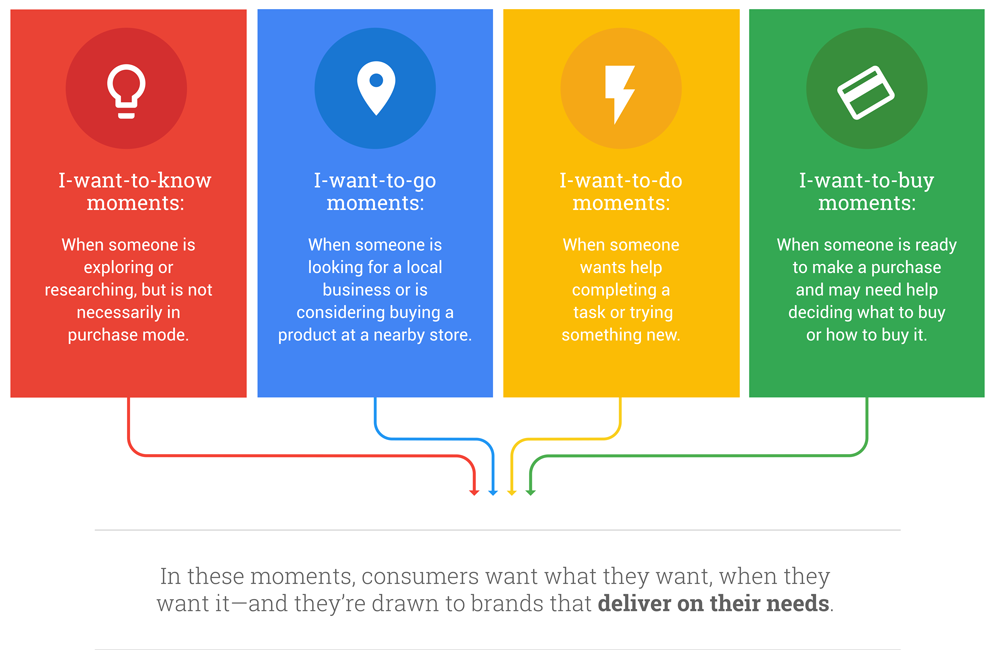
The following are examples of possible search engine queries for each type of micro-moment:
- I-want-to-know moment: “How much does it cost to paint a bathroom?”
- I-want-to-go moment: “Where is a good used car dealership near me?”
- I-want-to-do moment: “How do you write a resume?”
- I-want-to-buy moment: “Where can I buy running shoes online?”
Micro-moments are changing the way people access websites.
A site has an extremely short window of opportunity to catch a potential visitor’s attention, both on a search engine’s results page, and on the site itself.
Today, SEO content writers need to able to create web pages that answer these types of search queries, and do it quickly.
About The Ultimate Guide to SEO Content Writing
SEO content writing is a practical skill that anyone can learn. You don’t have to be a computer geek to be a good SEO writer. If you’re already familiar with the basics of good writing, SEO is simply another tool you can add to your writer’s toolkit.
The Ultimate Guide to SEO Content Writing will provide you with the core principles of SEO content writing that you will be able to use throughout your career.
What you won’t find here are flash-in-the-pan shortcuts to simply rank on Google.
But if you’re looking for the fundamental skills needed by SEO content writers today, you’re definitely in the right place.
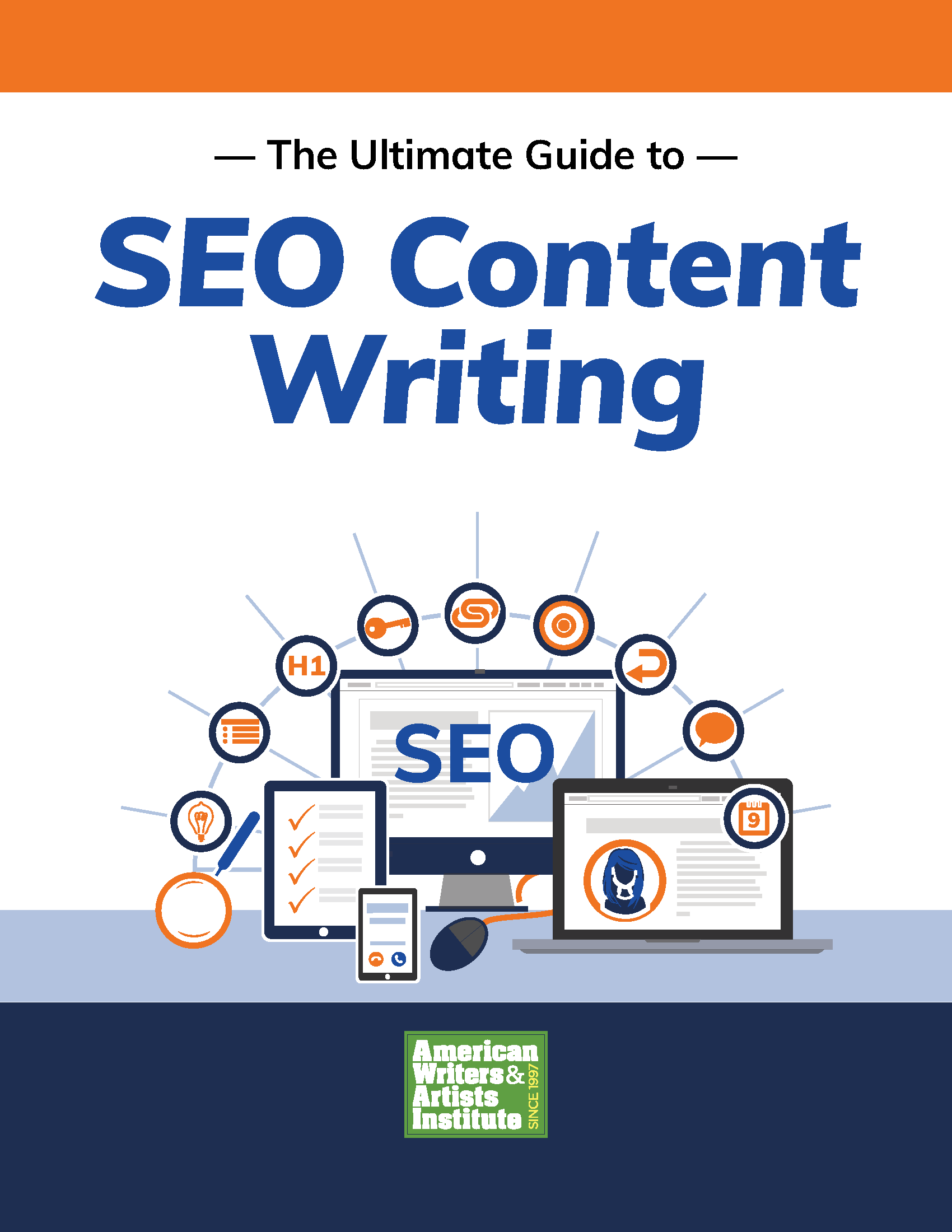
Want to download a free copy of this guide?
Simply click here to enter your email address, and we’ll send you a free PDF!
What You’ll Learn
The Ultimate Guide to SEO Content Writing has four chapters. Each chapter will take you through a specific aspect of SEO content writing and prepare you for your career as a well-paid SEO copywriter.
The chapters are organized in a logical progression to build on each other, but you can read them in whatever order you like.
What we really want is to hear your success story once you’ve completed this guide and put it into action.
So, work through the chapters and make sure you practice and apply what you’ve learned. We’ll be waiting to hear from you!
CHAPTER 1 — How to Use an On-Page SEO Checklist (With Download)
On-page SEO is the heart of SEO content writing. This chapter will take you through all the essential elements of on-page SEO and how to effectively optimize them.
These fundamental skills are perennial and can be applied to any webpage.
We’ve also provided an easy-to-follow On-Page SEO Checklist that you can download and use for all your SEO writing projects.
CHAPTER 2 — 9 Tips to Optimize a Blog Post or Article for SEO
Blog posts and articles are often some of the most popular and high-traffic pages on a website. It pays to know how to optimize these pages as thoroughly as possible.
In this chapter, you’ll learn a detailed process for making SEO-friendly blog posts and articles that are loved by both readers and search engines.
CHAPTER 3 — What’s the Job Description of an SEO Copywriter?
As you’ve learned so far in this guide, the core job of SEO content writers and copywriters is to write webpages that are optimized for SEO. But, beyond that, you can almost write your own job description.
This chapter will cover the types of SEO copywriting employment available, what your daily work might look like, and how your role as an SEO copywriter fits into a company’s larger business goals.
CHAPTER 4 — How to Make Good Money as an SEO Copywriter
How much money can you actually make as an SEO copywriter? And how can you make it a viable career?
This chapter will delve into these questions, and give you tips and strategies for finding and landing high-paying SEO copywriting work.
Share this Page:
Facebook Twitter Pinterest LinkedIn Email
GatherContent is becoming Content Workflow by Bynder. Read More
SEO content: How and why to develop an effective strategy

GatherContent Contributor, Writer
7 minute read.
Interviewed by:
Table of contents

Content Delivery
How to deliver high quality website content, on time and in budget.

Founder of Lagom Strategy
Creating SEO content is rarely a walk through the park. No wonder 90.63% of pages get no organic traffic .
Are your pages among them? And, if so, do you know why your SEO content isn’t performing as well as it could? A leading reason may be that you don’t have a well-defined SEO content strategy in place.
Sure, you’ve probably looked into ranking factors that can help you improve your SEO game. But you’re probably not taking the action needed to rank in the search engines.
Let’s walk through a 7-step framework for creating a high-performing SEO content strategy. We’ve also included our best SEO content writing tips for you as you create new content.
Let’s start.
What is SEO content?
SEO content is content meant to drive organic traffic from search engine results pages (SERPs). Content optimization is a big part of accomplishing that goal. It’s what helps your content rank on page one of Google and, preferably, within the first few organic slots. (That’s where it can be most easily found by our audience.)
However, the kind of content that deserves to rank well isn’t optimized for search engines alone. It also keeps the reader's experience in mind. It answers all audience questions about the target keyword or phrase.
“The kind of content that deserves to rank well isn’t optimized for search engines alone.
It also keeps the reader's experience in mind and answers all audience questions about the target keyword or phrase.”
But why worry about optimizing for your target audience? Isn't it easier to just optimize for a keyword?
In reality, SEO writing and writing for your audience are synonymous. Search engines like Google prioritize satisfying their users. So when your content does that, it ends up ranking well. A win-win.
For instance, when a searcher finds their answer on your page, they are likely to spend more time on your site. This increases your click-through rate and reduces your bounce rate. Both are leading ranking factors so improving them can improve your SEO results.
💡 Learn more: Why SEO is about people, not the search engine
Why is SEO content important?
The obvious answer is that high-ranking SEO content generates website traffic. But traffic is a secondary goal. It often leads to the bigger objective of converting customers or users.
So it’s more accurate to say that SEO content generates relevant, quality website traffic. It helps the people with the most potential of converting to find your website. And this visibility and accessibility boost also has benefits.
For example, say your website constantly shows up in search results for a topic your audience is researching. If your content is engaging and meets their needs, it can boost your credibility (and memorability). Your target audience will begin to see you as an authority, which means more chances to engage and build relationships. Both can lead to sales or other important outcomes in the future.
SEO content types you should consider creating
What types of SEO can you create to enjoy the benefits above? Here are some of the most common SEO-friendly content types:
- Lists. For example: “101 newsletter ideas to try today.”
- Guides. This is in-depth content on a topic that’s spread over multiple pages. Moz’s guide to SEO is a good example of this.
- Articles. These could be interviews, news, or features commonly published by news publications.
- Blog posts. These often target specific keywords or queries and either answer a target audience’s questions or explain processes.
- Infographics. These visualize data and help capture organic traffic of searchers looking for quick answers to their queries.
- Product pages. These offer product descriptions while also serving as landing pages for PPC campaigns.
- Images and slideshows. These could be anything from supplementary and explanatory graphics to a PowerPoint presentation.
- Videos. These could be bite-size clips or long-form videos explaining a topic comprehensively. YouTube is one of the most popular ways of making video content widely discoverable.
7 steps for creating an SEO content strategy
The worst thing you could do is pick one or more of the content types above and start creating. As with your overall marketing efforts, strategy is essential to enjoy the full benefits of SEO content. To make sure you’re doing SEO right, follow these steps.
1. Revisit your audience
To create a successful strategy, you must first know who it’s for.
Start with identifying your target audience. Then, look for common threads across:
- Their pain points, their impact, and their severity
- Their goals or the outcomes they’re after
- The way they speak about the pain points and goals they have
- The solutions they’ve looked into and how they feel about their options
These and other audience details will guide your keyword research and content creation.
2. Identify your goals
Write down your goals for creating SEO content. Do you want to drive organic traffic or do you want more conversions?
According to David Farkas, Founder of The Upper Ranks , your goals can include:
- Obtaining certain rankings for target keywords and especially those that are high priority
- Increasing organic traffic and conversions by a certain percentage within a certain timeframe
- Increasing average time on site and user engagement
As you set goals, though, be sure to look at the big picture. Wins like increased traffic and better rankings are great. But only if they lead to more meaningful outcomes that grow the business or further your cause.
3. Research keywords and validate ideas
Your audience research can be a goldmine of keywords, phrases, and frequently asked questions. Start there.
Jake Peterson, Senior SEO Manager at Go Fish Digital , advises researching variations and questions related to a seed keyword. From there:

Once you have a list of target and secondary keywords, brainstorm content topics. To choose the right topics, you must understand each keyword’s search intent . From there, there are many tools you can use for brainstorming. According to Adam Gingery of Majux Marketing , you can:

For each keyword, also decide the content type. Will it be a guide, a how-to piece, a short-form article, or something else?
4. Audit any existing content
At this point, you’ll have a clearer understanding of the topics you’ll need to cover. But don't start planning new content based only on your keyword research. Before you get ahead of yourself, audit your existing content. Have you already covered a topic surfaced in your recent research? If so, there are four buckets it might fall into.
- In need of minor updates: Especially for a high-priority keyword, is there a piece you could freshen up with new stats or info? Insightful quotes from subject matter experts? Or could you improve writing quality, formatting, or other details?
- In need of major updates: Large updates may include expanding a piece, optimizing for a different intent or audience, or updating your organization’s stance on a topic.
- Able to be merged: You may find that you have several pieces on a topic that overlap significantly. In that case, combine them into one in-depth post. This may make it easier to rank for the keyword with the best traffic and/or conversion potential.
- Able to be deleted: If a piece is too dated, no longer relevant or miles off from your current quality standards, scrap it. Whether you plan to rewrite it or not, it’s better—both for user experience and SEO—for it to be removed from your site.
Taking stock of the content you have helps you use your resources wisely and see results faster. (It’s usually easier and takes less time to update existing content than to create it from scratch). Plus, it keeps existing content from competing with any new pieces you create on the same topic.
5. Create an editorial calendar and content briefs
With your list of target keywords and topics ready, organize them in a publishing schedule. For each topic, add a due date and assign a content writer—whether in-house or freelance.

To ensure writers create high-quality content, provide high-quality content briefs . These should distill information such as:
- The focus keywords and secondary keywords
- The target audience
- Guidelines for search engine optimization
- How each piece of content will meet the audience’s needs and

6. Create a link-building plan
Link-building boosts your site’s domain authority and improves rankings. In fact, creating a comprehensive post on a target keyword and waiting for it to rank naturally is rarely enough—particularly if you have a new site.
The solution? Actively build backlinks to each piece of content. Identify relevant websites that link to others’ content on your target keywords. Then, reach out to them explaining that you offer a better resource that’s worth linking to.
7. Publish and track results
Once you hit publish, review the results.
For example, monitor Google Analytics to understand:
- How much traffic your posts are driving
- How long visitors are staying on the page
- What visitors are clicking on and patterns in the journey across your site
- Which pages convert better
How can you be sure you’re tracking progress the right way, though? Pre-select the metrics you'll monitor based on your goals. Every quarter or so, review progress against these metrics.
Finally, an important piece in the SEO content strategy puzzle. Keep refreshing old, evergreen content.
The Google algorithm loves fresh content and prioritizes it when ranking results. Be sure to add this step to your content marketing workflow .
💡 Learn more: Wrapping search and SEO into your content strategy process
12 tips for SEO content in 2023 and beyond
Here are our 12 best tips for writing SEO content. You’ll see many of them in action across an excellent piece of content from Semrush, which we’ll use as an example.
1. Write for your readers first
For SEO content to do its job, it has to give readers the information they need in a way that’s easy to consume. You must understand readers’ intent so that you can cover the right topics thoroughly.
Second, avoid keyword stuffing. If your content reads like a robot wrote it, readers will be more likely to bounce. This can indirectly have ill effects on your SEO results in the long term. So use your target keyword (and variations of it) naturally .

Stephen continues: “It means going back to basics. Like writing an article about one subject as opposed to targeting multiple keywords simultaneously, which may not even exhibit the same intent. And it means keeping SEOs out of content development, which is how it should be. SEO should support content, not determine it.”
2. Add keywords strategically in your SEO content
We mentioned the importance of using keywords naturally and you should. Yet, if at all possible, aim to include them at least once in each of the following:
- Your H2 headings (or H3s)
- The introduction
- Throughout the content
- The last paragraph
Using keywords strategically helps search engines confirm the topic and depth of your content. This helps them rank your content so that the people you want to find it can find it.
Semrush did this well in its content optimization guide .

You can see the main keyword and a variation of it mentioned in the intro, first H2, and in the body of the content. It’s also mentioned elsewhere in the content but not overused .
3. Create content based on the questions readers have
The key to good SEO content writing is answering all the questions readers have on a given topic. Find these by looking at what searchers are asking about in the People Also Ask section. (You can find this section in Google search results for your target keyword.) Then, answer them thoroughly in your content.
For instance, here are a handful of questions people ask about content optimization.

Now, look at the Table of Contents from Semrush’s content optimization guide.

As you can see, it answers a few questions from the People Also Ask section. These include what content optimization is and why it matters. And the rest of the content takes a deep dive into the keys to content optimization.
4. Structure content for readability
Making it easy for readers to navigate and understand your content is essential. Divide content with subheadings, organize those sections in a logical order and use short paragraphs and sentences.
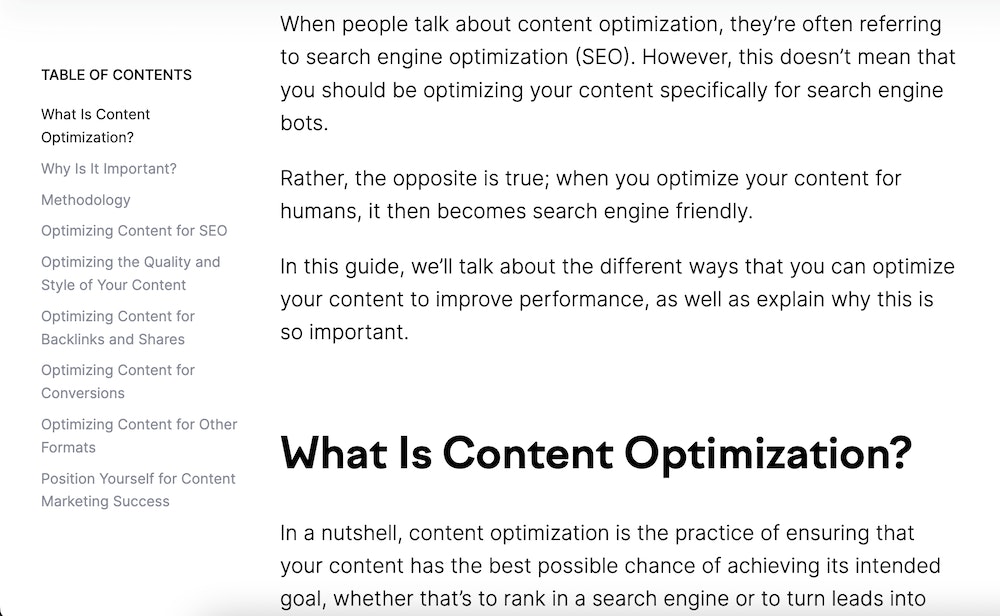
Additionally, use bullet points where possible and use bolding to highlight key points.
5. Write direct, to-the-point subheadings
Direct subheadings help visitors see at a glance if your content answers their questions. They also improve readability. And, if you frontload main points within your paragraphs, they can help you snag featured snippets on Google.
6. Write keyword-enriched meta descriptions
Write inviting meta descriptions that give readers a reason to click to read your content from the search results. Mention what aspects of a topic your content covers and how the information is beneficial. Also, use action verbs such as “learn,” “dig in,” and “read” to encourage searchers to read.
💡 Tip: Get four conversion copywriting tips to help you write meta descriptions that drive clicks.
Also, include your focus keyword as close to the front of the meta description as possible, along with other relevant terms. To illustrate, Semrush uses the main keyword immediately while also highlighting the importance of optimization. Then, while using other related keywords, it sets the expectation for what readers will learn and encourages them to read the content.

7. Add alt text to all images
Make sure all your images include alt text explaining what’s in the image. These short descriptions make content accessible to a wider range of readers. They also make it easy for Google to understand and rank.
8. Create compelling page titles
Include your target keyword in the page title tag. This will give search engines another cue as to what your content is about, helping them rank it properly in search results.

It’s also important that your headline entices people to read. Answering what’s in it for them can help with this. For example, can you spot the promise in Semrush’s case? It's that the content will be in-depth (since it’s an ultimate guide and includes an infographic).
9. Break text up with visuals
A large part of writing content for SEO involves creating visuals. Why is this so important? Images and other visuals help with readability and ranking. Explanatory visuals such as concept maps further readers’ understanding of a topic.
They break up text, support learning, and keep visitors on-site longer. Plus, other sites may feature your images and link back to your content. More backlinks can boost your search engine rankings.
10. Write short URLs
Keep your URLs simple and as short as possible. Rather than using your whole headline, use your focus keyword as the URL slug.
But it’s worth mentioning that, if your target keyword includes words like “the” or “a,” you can remove them. And, in some cases, you can also add words as needed. For example, Semrush’s URL adds the word “guide” even though the main keyword is just “content optimization.”

11. Add transcripts to all video content
Do you produce video content? Add transcripts to the videos as you upload them. They tell search engines like Google what was said in your video. This can help the content rank for relevant search queries.
12. Add internal links to your content
Linking to related pieces of content on your website has a couple of benefits. It:
- Helps and educates your audience, giving them the info they need. It also keeps them on-site longer and promotes engagement. All of this can be good for your SEO and help you earn your audience’s trust.
- Shows search engines the extent to which you cover relevant topics. The more thoroughly you cover industry topics (via high-quality SEO content), the more authoritative your website seems. In turn, the higher search engines may be willing to rank your pages.
Create SEO content that works
With that, we’ve reached the end. You now have the know-how to create a solid SEO content strategy and write content that ranks. All that’s left is to put that knowledge into action consistently.
On the consistency front, GatherContent is an invaluable tool. It can help with:
- Creating your publishing schedule and managing your content calendar
- Briefing in-house or freelance SEO content writers on individual content pieces
- Maintaining your standards for optimization and style thanks to content templates and embedded style guidelines
And those are just a few of the features loved by the more than 2,000 businesses that use our platform.
Want to see how easy it is to plan and manage SEO content in GatherContent? Try it for free for 14 days.
On-page SEO checklist
Use this checklist as a guide for tips and tricks you can apply to any piece of content to get some quick seo wins..

About the author
Related posts you might like, platform features.
- Content Hub
- Content Project Management
- Content Planning
- Content Templates
- Content Style Guides
- Content Management
- Content Workflow
- Content Calendar
- Content Creation & Collaboration
- Beta Features
- What's New
- Productivity
- Integrations
- What is ContentOps?
- Resources and Events
- Our Partners
- Customer Advisory Board
- Join our team
- Security & Backups
- Terms of Service Data Processing Agreement
- Terms of Website Use
- Global Privacy Policy
- Cookie Policy
- Help Centre
- API Documentation
Sign up to our weekly newsletter
Thanks for your message! We'll be in touch shortly.
What is SEO Content Writing? The Complete Guide to Writing For Search [Video + Infographic]
Search engine optimization is an $80 billion industry. Are you getting your money’s worth?
SEO writing requires analytics proficiency and high-quality copy skills. It’s the convergence of data science and art.
So how do you do it right? How do you please readers, search engines and your boss all in one go?
What is SEO Writing?
SEO writing is the implementation of keywords and key phrases within web content. The SEO content writer and marketers use SEO to increase their site’s organic visibility and SERP rankings. The best way to write for SEO is to pair high-quality copy with targeted search terms.
With traditional copywriting, the content writer is focused on other goals and not necessarily on having the product come up first as a search engine answer. These types of copy may reach the consumer in the form of a TV commercial or product label — but an SEO copywriter meets readers on a web page. With professional content writing, the goal may be broad enough to encompass both SEO results and traditional marketing outcomes.

Key SEO Terms, Defined
- Long-tail keywords: A string of keywords or phrases, often 3-6 words long. Long-tail terms are more specific and are queried less frequently relative to high-level, generic terms. Think “basketball shoes” vs. “2019 basketball shoes for sale Colorado.”
- SERPs : Search engine results pages. In other words, the Google page contains all the results users can click on after a query.
- SERP position : The exact ranking in Google analytics. For instance, Position 12 would refer to page 2 of Google, since only 10 listings typically appear on Page 1.
- Anchor text : The words or phrases that are hyperlinked, directing traffic to other web pages.
- Meta description : A short summary of a webpage that appears in SERPs — often 160 characters — that can entice searchers to click a result.
- Title tag: The title of a webpage that appears in Google SERPs and as the text on browser tabs.
- Search queries : Words that users type or say into search engines.
- Search volume : The number of times a term is queried per month.
- Click-through rate : Percentage of clicks for a SERP result relative to how many times searchers saw that search result.
- Conversion rate : Percentage of people who complete the desired action (a click, a purchase, etc.) divided by the total number of people who visited that page.
- Organic traffic : The number of users who found your site via a search engine of their own free will and not through paid ads or other sites.
- Structured data (schema) : How SEO elements like metadata, keywords and HTML are formatted on the page. Data that is structured makes it easier for search engines to crawl and index pages.
- Ranking factors : The general components that search engine algorithms consider when deciding which pages should rank higher than others.
- Backlink : A hyperlink that directs traffic to another page, either internally or externally.
- Page and Domain Authority : A score that measures how “authoritative” a page or site is on a scale of 1-100.
- Pageviews : Number of times a page is viewed.
- Pageviews per Session : Number of pages viewed in 1 session by each user, before leaving the site entirely.
- Organic keyword difficulty : A metric of how easy or difficult it will be to rank for a given keyword in organic search, on a scale of 1-100.
Subscribe to The Content Marketer
Get weekly insights, advice and opinions about all things digital marketing.
Thanks for subscribing! Keep an eye out for a Welcome email from us shortly. If you don’t see it come through, check your spam folder and mark the email as “not spam.”
Start With Your Goals
The foundation for any SEO content strategy is to know what you hope to achieve. Set measurable goals before you begin, so that the SEO copywriter, marketing managers and other stakeholders are all working toward the same KPIs.
Here are common metrics to measure:
- Click-through rate: This is the number of clicks that the copy and product acquire divided by the number of times it is shown on a search engine results page (SERP).
- Conversion rate : The number that results from dividing conversions by the number of total interactions that can be tracked to a conversion during the same time period.
- Organic traffic : Readers and consumers who visit a web page through unpaid means.
- Backlinks : Links from one website to a page on another.
- SERP position : The positions a website has in organic search.
- Dwell time : The length of time a person spends looking at a webpage.
- Page and Domain Authority : Search engine ranking score.
- Organic keyword opportunity/difficulty : A score that tells you how challenging it would be for the website to rank high on a SERP for a certain keyword.
- Pageviews per Session : The website’s total page views are divided by the number of sessions that have happened.
The SEO writer should be given the data they need to succeed so that each new page that’s created is tied back to a core business goal.
Know Your SERP Presentation
There are a growing number of ways search engines present your webpages to the public, known as featured snippets. This means not every piece of content is presented to the searchers in the same way.
Even if two companies write an SEO article about the same topic, if one of those pages ranks highly in SERPs, it could earn a featured snippet. So while company A is presented as a generic blue link, company B is presented with additional images, bolded text and more.

To stand out from competitors, understand how your quality content is going to appear in Google SERPs — then optimize for that specific format. Here are the featured snippets you’re most likely to encounter as an SEO article writer.

- Image carousel.
- Local 3-Pack.
- Knowledge Graph.
- People also ask.
- Top stories.
Think in Terms of Ranking Factors
In line with your company’s own commercial objectives, there are also Google’s preferences to keep in mind. The search engine’s primary algorithm, RankBrain, helps process web pages and determine where they should rank in SERPs.
So content writing isn’t just pleasing your readers; it’s about pleasing Google too. That’s why it’s important to know the specific SERP rankings factors Google looks at. There are more than 200, but 10 of the most prominent are:
- Content quality : Is your SEO article writing accurate, relevant and user-friendly?
- Backlinks : Do other sites link to your content?
- HTTPS : Is your site secure?
- User experience : Is your content visually and informationally valuable and easy to engage with?
- Mobile-first : Is your site optimized for mobile screens?
- Page speed : Does your page load in 2 seconds or less?
- Direct traffic : Do users come directly to your site, or do they have to Google you first?
- Content depth : Is your content more comprehensive than similar pages on the web?
- Behavioral signals : Do people share, comment and mention your content?
- Schema : Is your content easily understood by search engines?

Strategic, Not Stuffy: How To Use Keywords
The SEO service has always been an evolving discipline. In the earliest iterations of the internet, the content was ranked and served to users based on repeating the same keywords as many times as possible. This was referred to as keyword density.
Write for the end user, not a magic number of keywords.
However, in the last five years, Google’s algorithms have gotten smarter, and they know that keyword stuffing is spammy and not useful to readers. So, copywriters have had to shift their approach: Write for the end-user, not a magic number of keywords.
What this means in practice is that each page should be built around a single keyword. You can use the keyword research tool to find what keyword to target based on the difficulty score and search volume metrics mentioned above. Writers should cover every angle and aspect of that topic and its associated subtopics. Think ahead: What follow-up questions might a reader have after reading your piece? Include the answers to those questions in your writing right from the start.
The intent is to be the single best resource for a topic, providing maximum value to readers. Don’t worry about using keywords in every other sentence. If you’re doing your job correctly, the keywords will naturally flow in the article.
Top SEO Copy Tips
- You are not your reader. Don’t write for yourself — write for your target audience .
- Mimic the language and voice of your audience , whether that’s third-person formal or second-person conversational.
- Include keywords where they will have the most impact : metadata, header tags, page title and anchor text.
- Use short paragraphs of only a few sentences.
- Strategically leave white space so readers can scan content at a glance.
- Externally link only to reputable, authoritative sites with high Domain Authority scores.
- Internally link only where relevant — not to every single related blog post or possible CTA.
- Include as much dat a as possible to support your claims.
- Embed relevant imagery so visuals can complement your narrative.
- Think of search queries as article titles.
- Write for as long as it takes to comprehensively cover the topic (that is, don’t aim for an arbitrary word count).
- Write with featured snippets in mind.
Optimize the Fine Print: Title Tags, Meta Descriptions and Alt Text
SEO writing is part prose, part process. There are defined steps writers should take to ensure they’re thinking about each piece of content holistically, both on and off the page.
One of the most important elements of SEO copywriting is nailing metadata.
Metadata is a cue to search engines: It helps tell the story of what your content is about and how it should be presented in SERPs.
Optimizing title tags, meta descriptions and image alt text may take only 75 words in total, but those 75 words are vastly more important than the rest of the copy that appears on the page.
Here is some guidance:
For the character limits listed below you can use a free AI-powered character counter to help optimize each of your metadata elements.
Optimize Title Tags
- Use only 1 header tag per page and try to include a targeted, primary keyword.
- Keep it to 70 characters or less.
- Each page should have a unique title tag — no duplicates.
Optimize Meta Descriptions
- Keep it to ~160 characters so that it doesn’t get cut off by Google.
- Use clickworthy phrasing and don’t regurgitate copy already on the page.
Optimize Alt Text
- Use descriptive language that closely matches the image.
- Include keywords where relevant.
- Keep it to 125 characters or less, with tags separated by commas.
Structure Matters: Headers, Subheaders and Sub-Subheaders
Think of header (HTML) tags as the skeleton of your content.
Structurally, headers keep your copy organized and provide readers with a general outline of what your topic entails (without them having to read every single word).
In the eyes of search engines, though, headers are also key elements of code that signal what the article is about. Proper header tags allow search crawlers to quickly analyze your page and correctly index it in SERPs.
Headers are simple because they follow a descending order:

- H1: The title of your page (only use one).
- H2: Core points or topics within your article (can be used as many times as needed).
- H3: Subtopics that fit underneath H2s.
- H4+: Anything beyond H4 is rarely used, however most text editors will go up to H7.
According to UppercutSEO , including keywords in your headers is a key SEO tactic as well, so frame your article structure around which keywords and topics are most relevant and useful to the reader.
On-Page Optimization and Re-Optimization
Technical SEO dictates that every piece of content has the chance to outperform another at any given time. While you’re writing an article, someone else could be writing the same article — just better.
It can quickly become a rat race.
Often referred to as the skyscraper technique, look for ways to continually optimize your existing pages over time. If an article is ranking in position 3, how can you leapfrog to position 1?
One of the easiest ways to drive more traffic and improve search engine rankings is to start with existing content that already performs reasonably well. You can use content writing SEO tools to spot opportunities and make minor tweaks, such as adding a few more paragraphs of in-depth copy or restructuring header tags to be more clear.
Re-optimizing content takes less time to reap greater rewards than from-scratch pages. Create a re-optimization schedule (say, every three to six months) and adjust your pages accordingly to maintain and enhance SERP share.
Tips for Incorporating SEO Writing Into Your Content Marketing Strategy
The entire process may seem a bit daunting at first, but there are some simple steps you can use to incorporate SEO writing into your content marketing strategy. While it may be helpful to completely revamp your entire work of copy, your team can start by adding important keywords to existing pieces.
As you begin to work toward more SEO-friendly content, be sure to keep your web pages up to date. SEO is a dynamic process and reoptimization is a key component of any strategy. Start by analyzing where your current content stands and then break it down into a specific plan of action, whether that be creating new copy or adding important keywords. Use the data you collect to create a more concrete content marketing strategy , and you will be well on your way to boosting your business through SEO writing.
How Long Does It Take to Work?
Based on various industry studies and several of our own experiments, it takes about 100 days at minimum for content to mature. “Mature” in this instance refers to how long it will take Google to definitively rank your page in SERPs. Prior to those 100 days, your ranking will fluctuate a lot, sometimes appearing on Page 1, other days dropping to Page 2.
Behind the scenes, Google is testing if your content has staying power — if it’s valuable enough to keep on Page 1. If after 100 days or so your content ranks highly, it will likely stay there (until a competitor writes a better piece of content and outranks yours).
Don’t base all of your judgments or KPIs on immediate SEO performance. Positive metrics accrue over time, so ensure your commitment to SEO and content marketing is a long-term one.
Editor’s Note: Updated May 2022.

By Michael O'Neill
You're subscribed! Look out for a Welcome email from us shortly. If you don’t see it, check your spam folder and mark the email as “not spam."
Recommended Reading
How to write a testimonial in 5 steps + 5 examples (infographic).
What is a customer testimonial, how do you benefit from it and how can you write one? Here’s everything you need to know!
How To Write Like a Journalist (And Why It Matters in Marketing) [Infographic]
Learn more about how to write like a journalist and why journalism skills are essential to content marketing.

No nonsense. Just really good marketing insights.
Sign up to get free weekly resources.

Thanks for subscribing!
Keep an eye out for a welcome email from us shortly. If you don't see it come through, check your spam folder and mark the mail as "not spam."

SEO Writing: How To Write SEO Content (12 Easy Tips)
Learn how to create SEO-Optimized content. Follow our tips to write SEO-friendly content that users love to read.
- Academy Login
- Online Courses
- Get Free eBooks
What Is SEO Writing?
Why is seo writing important, how to write seo content, key learnings, learn more about seo writing.
Writing for SEO is an art. The job of an SEO writer is to write content for search engines and users. To do that successfully, you must know how to apply basic SEO content principles in practice.
In this guide, you’ll learn everything you need about SEO writing. I will explain what SEO writing is and give you 12 SEO content writing tips to ensure that each content you write is search-engine friendly.
SEO writing is the process of writing content to rank high in search engines like Google, for related keywords. This is done by doing keyword research and writing SEO-optimized and helpful content relevant to the user’s search intent.
SEO writing is also known as SEO copywriting or search engine optimization writing.
SEO writing is important because if you want your content to get traffic from search engines, it needs to appear in the top positions of the SERPs. According to studies, the majority of search engine traffic goes to the top 5 positions.
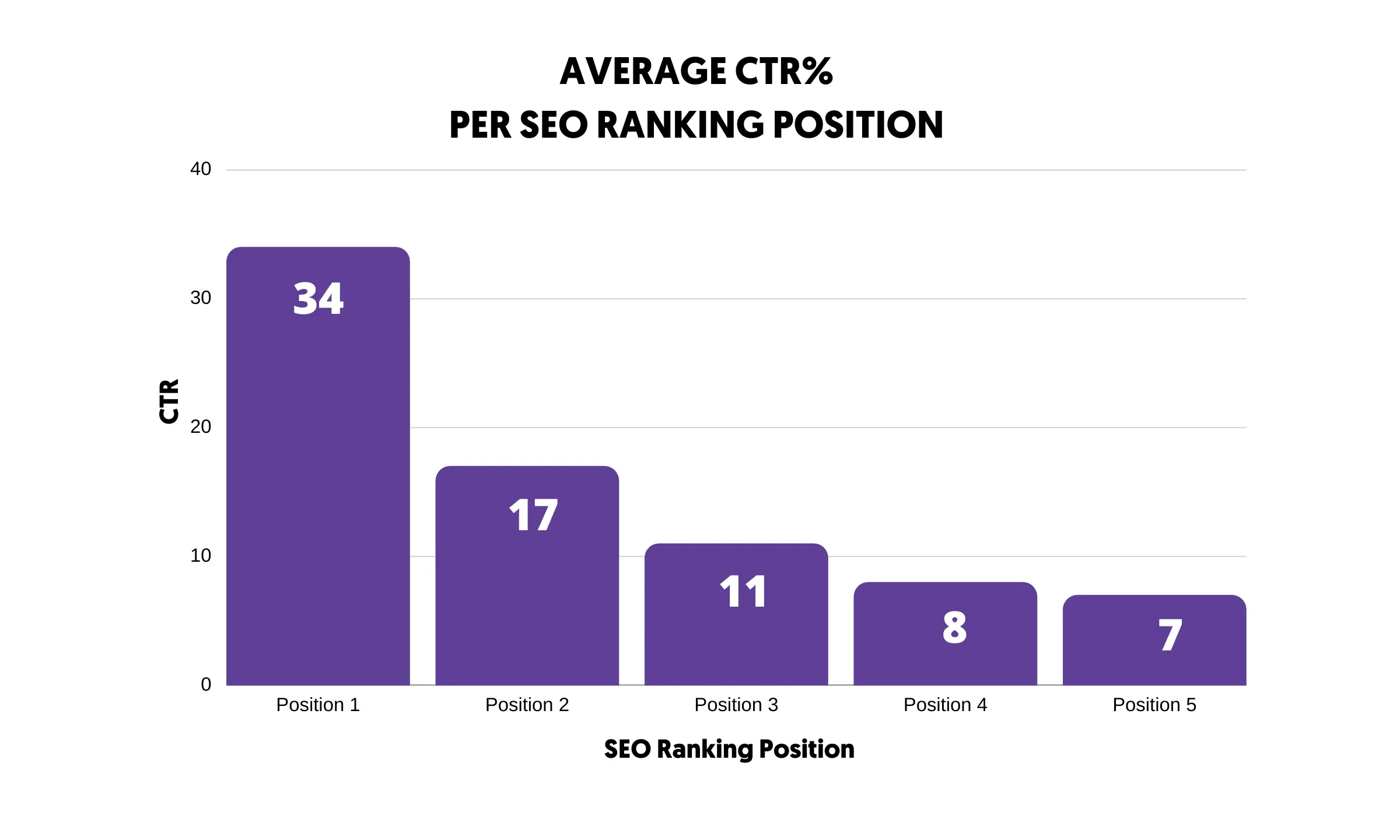
Another reason is growth. If you consistently write content that keeps users and search engines happy, it will have a positive effect on your Google trust and you’ll be able to rank for more keywords.
Over time, you’ll experience a steady growth of organic traffic with numerous other benefits for your business.
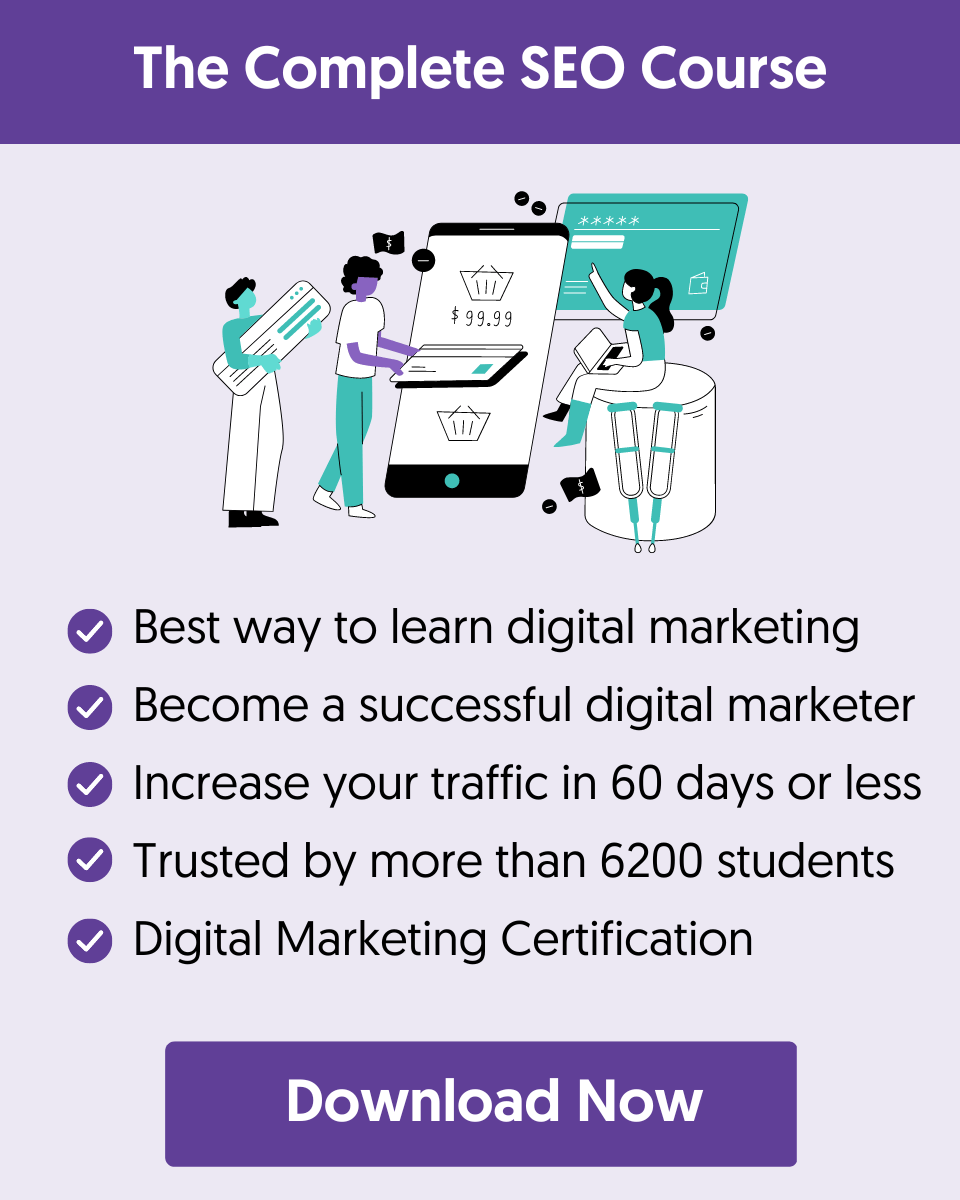
Follow these rules to start creating optimized SEO content.
- Find Your Primary And Secondary Keywords
- Craft Your Page Title And Meta Description
- Create An SEO Friendly URL
- Satisfy Search Intent
- Create Helpful, Unique Content
- Use Keywords In Your Content
- Create Meaningful Subheadings
- Add Internal Links With Relevant Anchor Text
- Optimize Content For E-E-A-T
- Optimize Content For Featured Snippets
- Add And Optimize Images
- Make Your Content Easy To Read On Mobiles
1. Find Your Primary And Secondary Keywords
The first step before writing new content is to decide which keywords to target.
This process is known as keyword research, and it’s very important for a simple reason. You need to write content around topics that people search for and keyword research will tell you that.
When you do your keyword research, the outcome will be a set of SEO keywords both head (or primary keywords) and long tail keywords that people type in search engines.
The easiest way to do this is to:
- Go to Google and search for your chosen topic (general).
- Visit the top 5 pages and analyze the type of content they provide.
- Take each URL and, using Semrush or other tools (Ahrefs, Ubersuggest, etc), find out for which keywords those pages are ranking and the traffic they get.
- Then, depending on the results, decide which main keywords you will target in your content.
- Take those keywords again and, using a tool, find out the associated long-tail keywords and related keywords.
Here is an example of how I followed the above steps when writing this post:
I did a general search on Google using “write for SEO”.
I analyzed the first results using Semrush and found out that the keyword that has a high volume for my chosen topic is “SEO writing.”
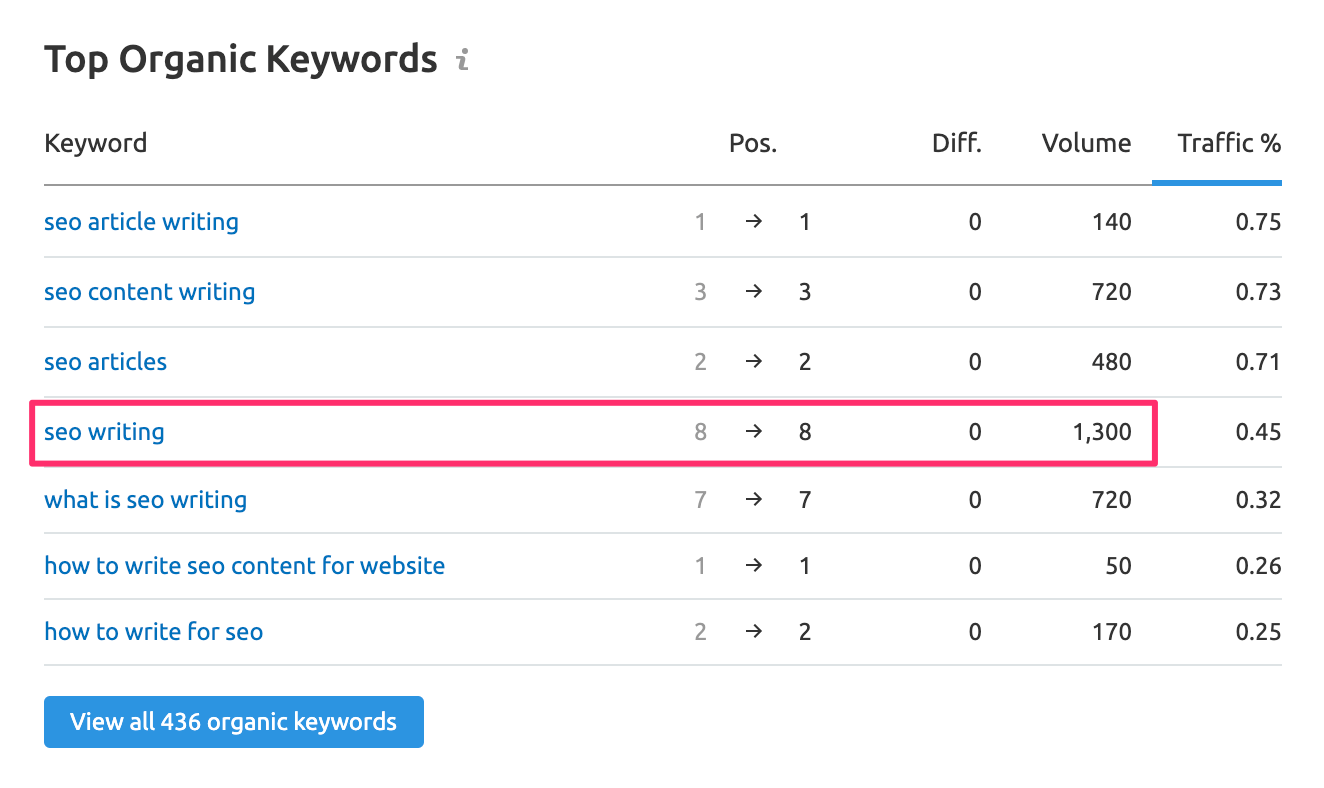
I then used the Keyword Magic tool (utilizing the advanced filters feature) of SEMRUSH to find other related long-tail keywords.
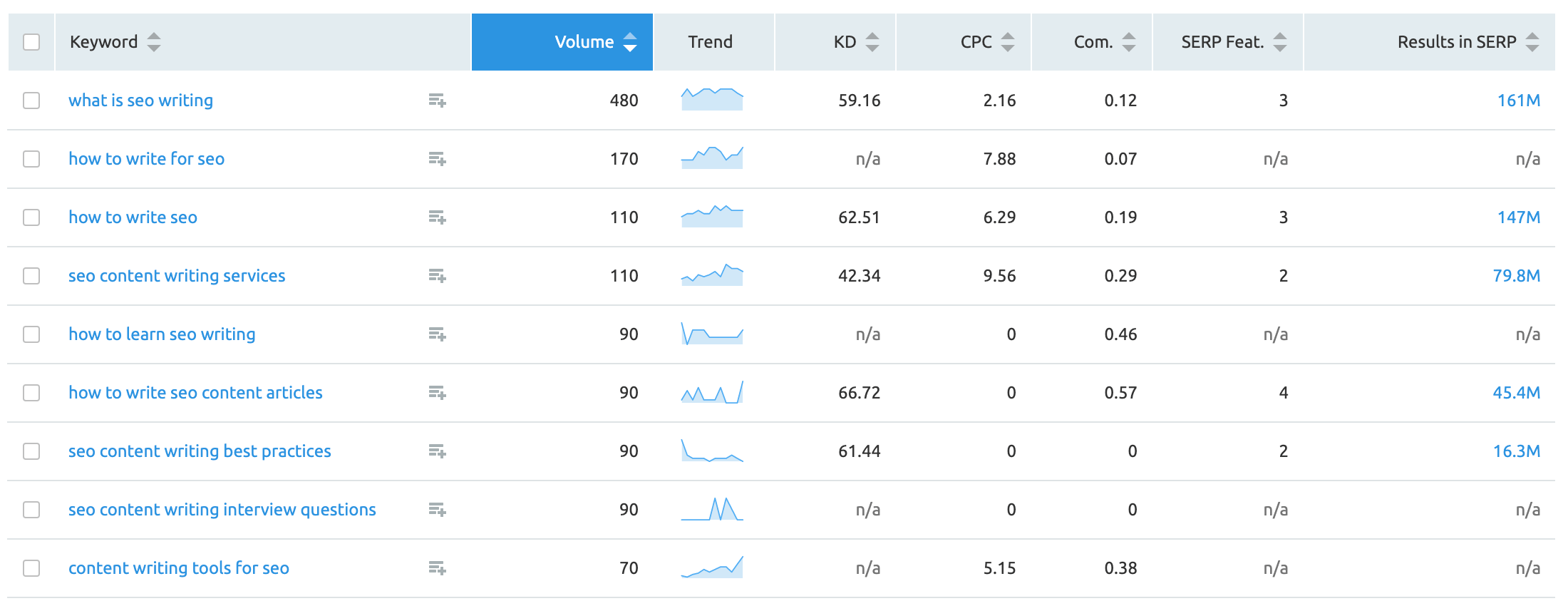
If you take a closer look at the content, you’ll see that these keywords are used in different places throughout the article.
By following this process every time you write new content, you help search engines understand your content better, and if your content satisfies what users want, this will eventually translate to higher rankings, social media shares, and more incoming links.
2. Craft Your Page Title And Meta Description
The next step is to start thinking about your page title. Choosing a good page title is critical for the success of your content, so allocate the necessary time to come up with a title that:
- Includes your target keyword
- It’s unique for your website
- It’s interesting for users to click
- It’s around 60 characters
- It’s not the same as the existing titles on the first page of Google.
Don’t omit any of the steps, especially the last one. Before deciding on your title, go to Google, type your target keyword, and analyze the first 10 titles.
Your goal is to create a title that is unique. Otherwise, you limit your chances of getting a top-10 position. Google rarely shows pages with the same title in the first 10 results.
Do the same when crafting your meta description . Make it unique, and try to describe your content in 160 characters or less. Include keywords so that users can know if the content matches their intent.
For example, look at the title and meta description below and notice how the keyword ‘learn digital marketing’ is used naturally in both.
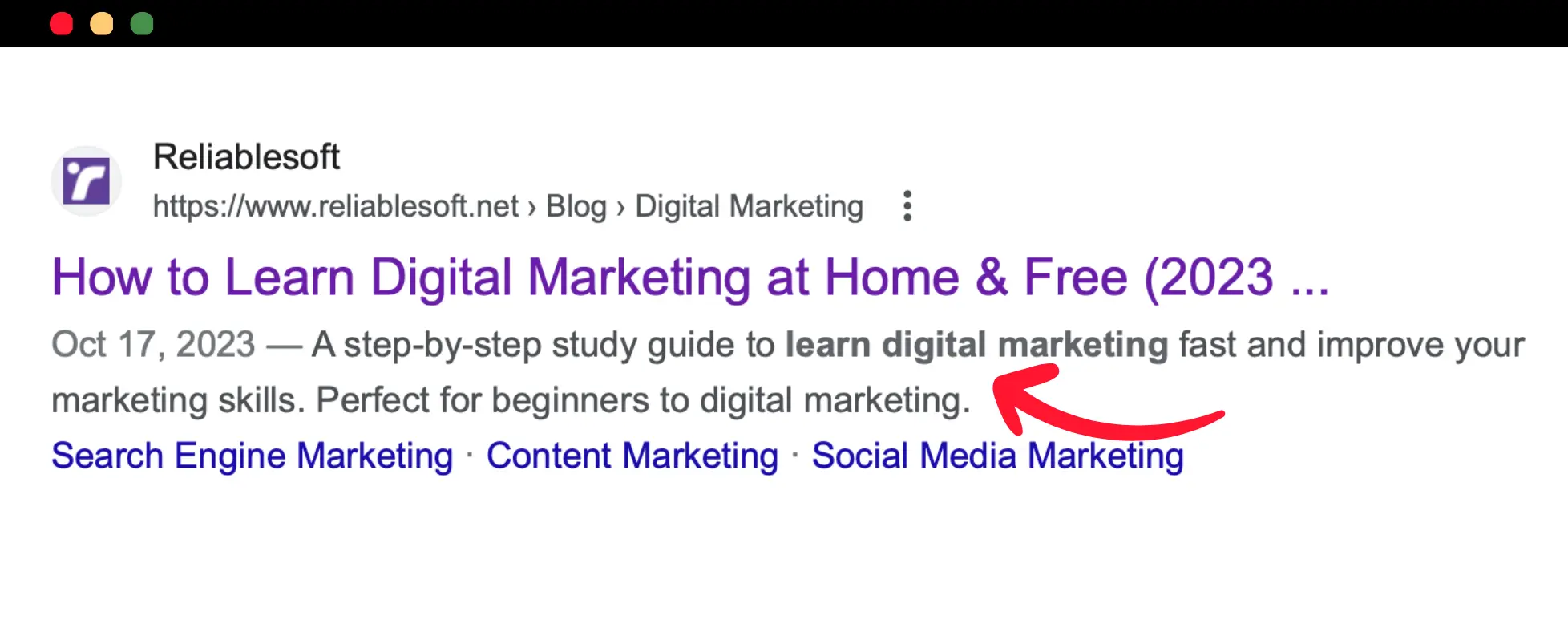
3. Create An SEO Friendly URL
The next step is very easy to implement. When creating the permalink of your post, ensure it includes your target keywords and eliminates any unnecessary words.
Look, for example, at the URL of this post. By default, it was the same as the page title, i.e.
https://www.reliablesoft.net/seo-writing-how-to-write-for-seo-12-easy-tips/
But I have shortened it down to:
https://www.reliablesoft.net/seo-writing
Aim for having exact match URLs where possible. Read our guide on SEO-Friendly URLs for more details.
4. Satify Search Intent
After finding your target keywords, the next step before writing the content is to examine what kind of content users like to consume for the particular keywords. In other words, you need to find the search intent behind each keyword.
To do this successfully, search for your target keywords on Google and examine the top-ranking pages. What kind of content is ranking in the top positions? Are they short-form articles, long-form articles, or listicles? What is the average content length? How are the pages structured?
Also, look at the ‘People Also Ask’ section, which shows users’ common questions about a particular topic.
For example, let’s say you’re writing a post on “blogging tips”.
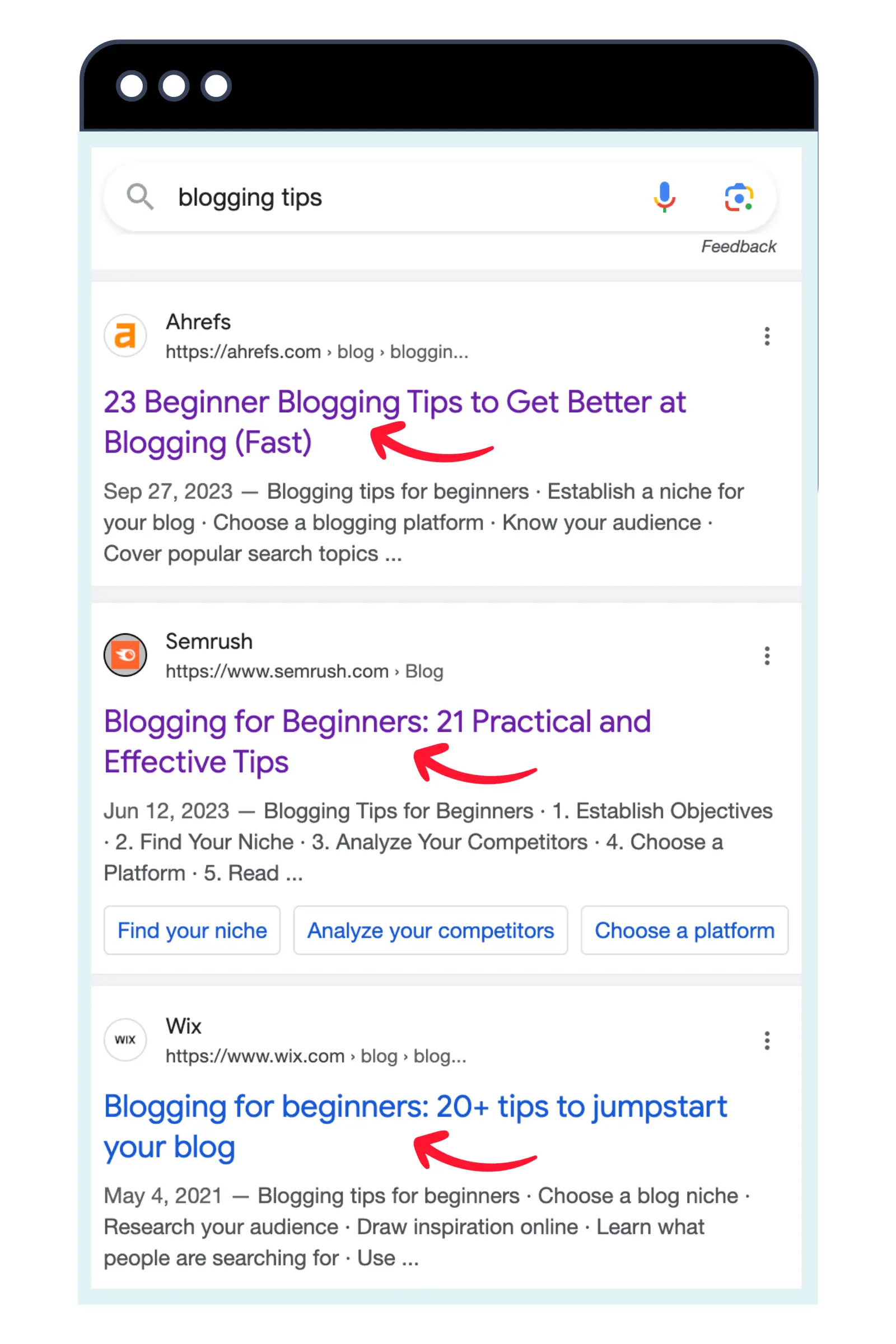
If you perform a search on Google, you can easily make these assumptions:
- Most articles have a list of tips, so the appropriate format for this keyword is listicles .
- For each tip, they give a summary and links to learn more.
- The average article length is 3000 words.
- Top-ranking articles have many custom-made visuals.
If you follow the above guidelines and provide content that is unique and useful, you’ll have more chances of achieving a high ranking.
Another example. If you are writing an article about ‘SEO tools,’ you will notice that almost all results are about lists with ‘Free Tools.’
This means that Google has found out that when users search for tools, although they don’t include the word ‘Free’, they intend to browse lists of Free tools.
This also means that if you target this keyword, you must adjust your title and content accordingly. Otherwise, you minimize your chances of rankings for that term.
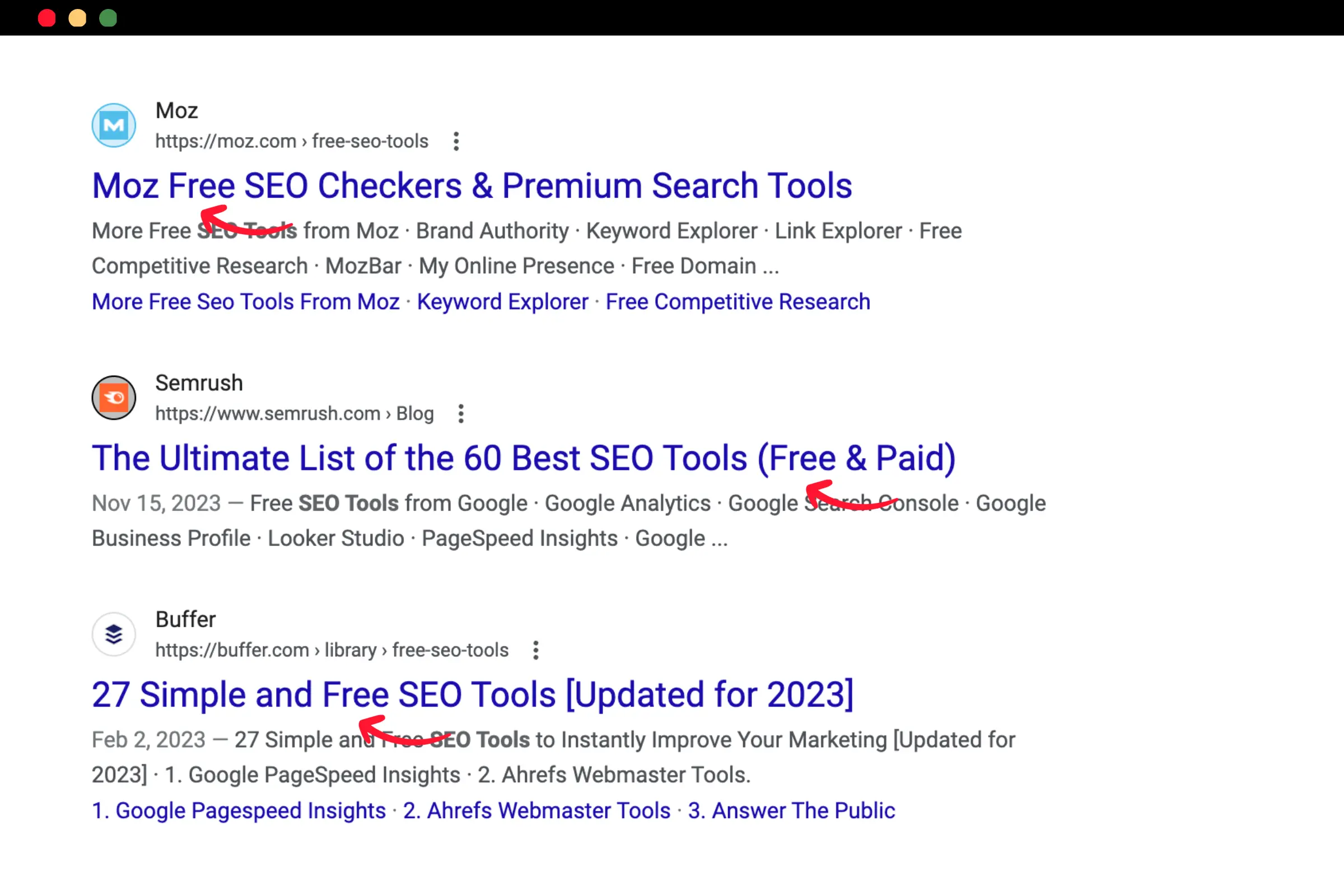
Pro Tip: Make sure you research on both desktop and mobile, as the results are presented differently.
5. Create Helpful, Unique Content
Now it’s time to get your hands dirty and get into content writing .
You already know what your competitors have published, you have your title, and you know which keywords to include in your content. What else do you need?
You need content that has the following characteristics:
- People-first – content produced to provide value to people and not search engines.
- Original – content that is not a copy of existing content.
- Unbiased – content that is not biased but presents both sides of a story.
- Complete – content that provides a comprehensive description of a topic.
- Better – content doesn’t have to be perfect, but it has to be better than what is already published.
Follow the checklist below, every time you start creating content.

What is the ideal length of content?
I’ve mentioned above that you must make your content comprehensive enough so that users can get accurate and in-depth information about the topic.
Despite what you might have read, there is no magic number when it comes to word length.
It all depends on the topic and keywords. For some topics, you might need to write articles that are over 2000 words. For other topics, you can provide a comprehensive answer in 800 words.
Content length alone is NOT a ranking factor. What matters is the quality of the content and how well it can satisfy the user’s real intent.
To avoid any confusion, several studies have shown that the ideal article length for SEO is around 1800 words, and this is true for many cases.
Longer articles allow you to use more keywords (without keyword stuffing), and they tend to do better in social media.
But, this is a general guideline and not applicable to all cases. My recommendation is to find the average length of the first 10 results and try to provide a bit more content but better than what has already been published.
There is no reason to write a 3000-word article if you can have the same result as a 1500-word article.
6. Use Keywords In Your Content
Here is a nice tip that most SEO writers fail to follow. Once you are done with the first draft, you need to go back and revisit your post introduction.
Your goal is to make sure that your target keyword is included in your opening paragraph .
The reason is that Google always considers that content that is above the fold and high on a page is more important than content found down the page.
Adding your keywords in the first paragraph gives Google a big clue as to which keywords to associate this page with. It’s also good for the users since you can help them understand that they are on the right page.
With the introduction of machine learning to Google search algorithms (known as RankBrain), Google is trying to truly understand what the searcher wants by using natural language processing.

This means that for a given keyword, Google will look for the deeper meaning of the query and not just for exact match keywords.
For you as an SEO copywriter, it means that you need to add related keywords in your content to help them during this process.
Related keywords are keywords that have the same or similar meaning. You can find these keywords using tools like Semrush. Here is a screenshot of the related keywords for “SEO writing”.

So, you need to return to your copy and enrich it with these keywords naturally. You may have to rephrase some of your sentences, but it’s a step that can improve the relevance of your content.
7. Create Meaningful Subheadings
One of the characteristics of SEO-friendly content is that it’s easy to read by both search engines and users, and headings help in that direction.
Don’t be surprised but the majority of users won’t read your content, they will scan through it. Having meaningful headings helps them find the part they want faster.
Search engines follow the same pattern, especially for long-form content. They scan the page and look for certain elements to understand how it is structured and what topics or keywords the content covers.
To make their job easier, you can use predefined heading tags in your HTML, like the H1 tag , h2 tag, and h3.

Usually, a page has only one H1 tag, which is used for the title, and then the rest of the content has H2 for the main headings and H3 for the sub-headings.
To further improve the SEO friendliness of your copy, try to use some of your long-tail keywords in the headings. Take a closer look at the headings of this article and notice how I have added long-tail keywords in my headings.
8. Add Internal Links With Relevant Anchor Text
One of the SEO principles most SEO content writers tend to forget is internal linking . An internal link is a link that points to a page on the same website.
Why is it important?
When you publish a new page, it has to match your site’s topics. This improves relevancy and rankings. One of the ways to ‘tell’ Google that your content is relevant to the rest of the site, is to use internal links.
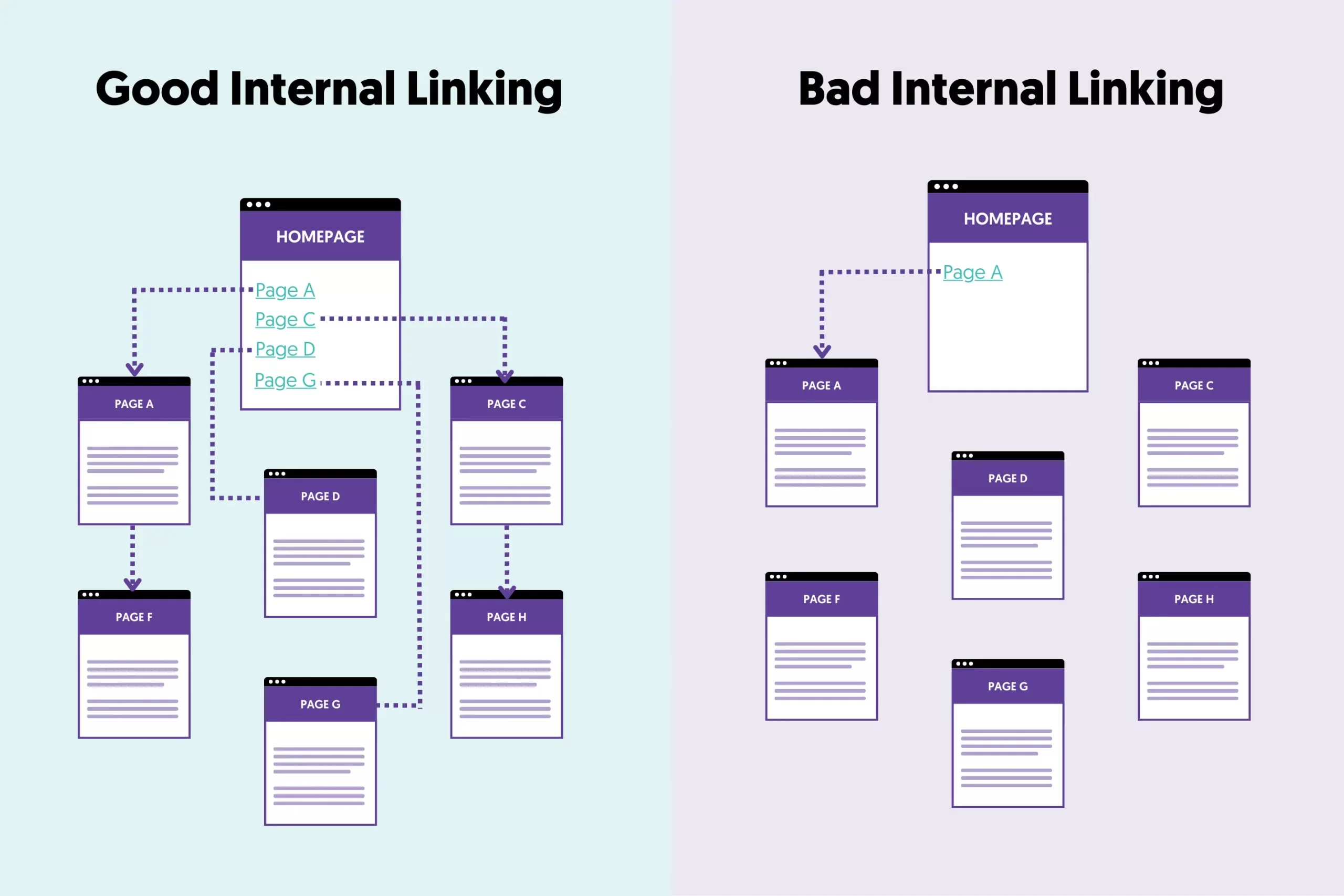
Although internal links are not as powerful as SEO backlinks, they are still used by Google to understand what the linked page is about, especially if the right anchor text is used in the link.
They also help users learn more about a topic (look at this article again and notice how I have used internal links to give users a way to find out more information about a topic).
Last but not least, internal links are followed by search engine crawlers, and this leads to better crawling and indexing of more site pages.
9. Optimize Content For E-E-A-T
A lot of content is published on the Internet, and to protect the quality of their search results, Google algorithms can detect which pages demonstrate Experience, Expertise, Authoritativeness, and Trustworthiness on a given topic.
In the SEO world, this is known as E-E-A-T and is a critical factor of SEO content and an indicator of content Quality.
Here is the relevant quote from Google’s guidelines on content quality.

How can you improve your SEO copy for E-E-A-T?
Follow these simple guidelines:
- Every page should have the author’s name and bio published (see how I use this on all my posts).
- A page should have outgoing links to trusted sources.
- A page and website, in general, should have incoming links from other trusted and related websites.
As an SEO copywriter, you cannot control the last guideline (incoming links) since this has to do more with the content promotion part, but you can control the first two.
So, revisit your content again and ensure that it links to other trusted websites and that the author bio is clearly shown on all pages.
10. Optimize Content For Featured Snippets
Another important tip for making your content more visible to search engines is optimizing for featured snippets .
A featured snippet appears on position ‘zero’ of the organic results and has a higher CTR compared to normal listings. Here is an example:
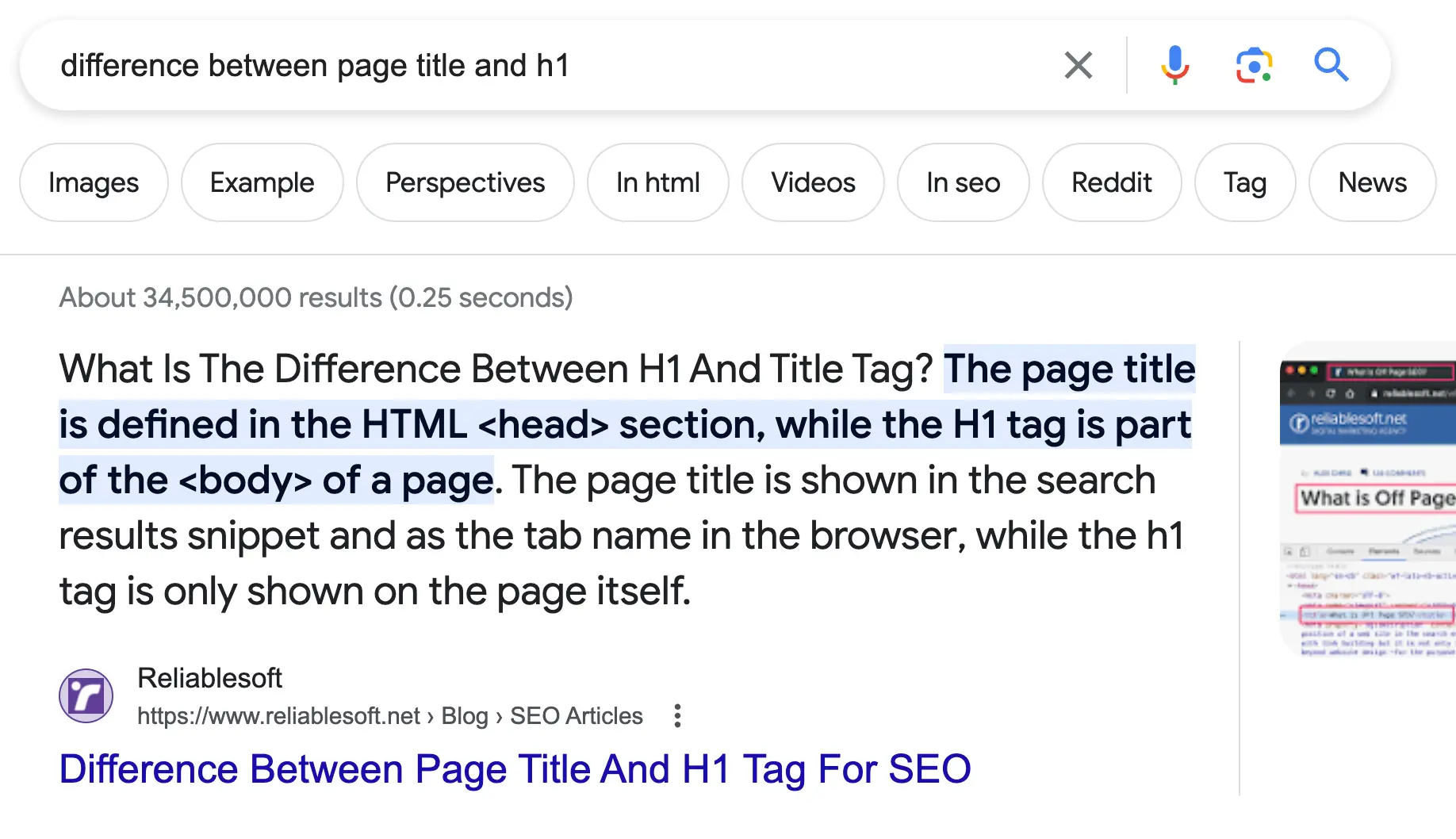
For every piece of content you publish, you should analyze the SERPs to find what kind of featured snippets Google shows for your target keywords and optimize your content accordingly. The most common types are paragraphs, lists, tables, and videos.
11. Add And Optimize Images
Before you hit the publish button, ensure your content includes optimized images.
Adding images to your content makes it more interesting and easier to read. While this is not directly related to SEO writing, it can help in many ways:
- Users are more likely to share content with high-quality images in their social media networks than content with no images.
- You can use the image alt text to give search engines more clues about your content.
- When you properly optimize your images , you have more chances of appearing in Google image search for your target (or related) keywords.
12. Make Your Content Easy To Read On Mobiles
When writing content, ensure it is optimized for reading on mobile devices. This means:
- Use a font that is big enough.
- Breaking the text into short paragraphs.
- Use lists where appropriate to make the information more digestible.
- Use responsive images that adapt to different screen sizes.
- Ensure that the main content is not confused with ads.
- The page loads fast and has no annoying popups.
Anyone can learn to write for SEO. It’s a skill that can be easily mastered through practice and by following some basic SEO principles.
If you work as a freelancer , you can apply for many SEO writing jobs. If you’re doing SEO for your website, learning how to write content for SEO will make your content get found on Google .
What you should not forget is always to put the user first. Your primary concern is providing content users want to read and then optimizing it for SEO.
This is why I have separated the process into several steps that involve writing the content naturally and then revising it for SEO.
- Best SEO Writing Courses
- SEO Certifications Guide
- The Complete SEO Course

Alex Chris is a digital marketing consultant, author, and instructor. He has more than 18 years of practical experience with SEO and digital marketing. Alex holds an MSc Degree in eCommerce and has consulted with Fortune 500 companies in different industries. He blogs regularly about SEO and Digital marketing, and his work has been referenced by leading marketing websites. Connect with Alex on Twitter and LinkedIn .

32 Comments
July 8, 2014 at 7:52 pm
this article is very useful. As iam a new learner so it helps me a lot. Thanks for all this information 🙂
November 6, 2014 at 7:19 am
Thanks for explaining in detail about SEO Friendly Content, this will be helpful.
January 10, 2015 at 2:37 pm
Great article for content writing and seo optimization..
May 25, 2016 at 8:30 am
Thanks for this wonderful post. SEO is an great part of blogging, and helps to get constant flow of traffic over long periods of time. Both on page and off page optimization are equally important, but I have been trying to learn more and more about on page optimization. Learned quite a few rocking tips on how to write SEO optimized posts.
Thanks bro.
May 25, 2016 at 10:47 am
Thanks for commenting. Glad you find my post useful. You can also check https://www.reliablesoft.net/ebook/wordpress-seo-guide/ for more actionable tips and advice about on-page and off-page SEO.
All the best Alex
January 29, 2017 at 7:19 am
Thanks i read it alreally. Really usefull for my site. Thank you so much bro.
July 15, 2016 at 8:46 am
Great little article! Giving the basics of SEO in an incredibly light and informative way. Very easy to read and understand thank you for your help!
July 16, 2016 at 10:49 am
well..informative blog..I am planning to rewrite content for one of my websites.I would like to ask about keyword density. please guide for the same..thanks in advance ..
July 21, 2016 at 8:01 am
Great article, many thanks.
July 22, 2016 at 6:23 pm
Great tips Alex! Writing for SEO without sounding like an SEO is easier these days. Ridiculous keyword stuffing is redundant and luckily Google is better penalizing for it. I’m generating ideas on my next piece of content with keyword tools. I like search suggestion tools like Answerthepublic.com or sg.serpstat.com but being organic in your writing isn’t something you can acquire with a tool)
January 19, 2017 at 4:31 pm
You are write Alex. If you wanna have frequently visited web/blog, you must have a well prepared showcase.
January 20, 2017 at 1:43 pm
Very well said! Prepare your content from the beginning so that it’s ready and in good shape once the traffic starts to flow in.
Thanks Alex
January 23, 2017 at 9:37 pm
Really amazing information with full detail but in point 5 you have a spelling mistake “big fun” instead of” big fan”. Thanks Alex
January 23, 2017 at 10:33 pm
Thanks for your comment. Spelling mistake corrected.
April 6, 2017 at 1:23 pm
This is my first comment here so I just wanted to give a quick shout out and tell you I genuinely enjoy reading through your posts. Can you recommend any other blogs/websites/forums that deal with the same subjects? Thanks a lot!
April 19, 2017 at 8:54 am
Thank you for your advice. I have a question for you: my blog is new, how to develop content the most effectively and get more traffic with content marketing.
April 20, 2017 at 1:40 pm
Take a look at these two posts: https://www.reliablesoft.net/how-to-write-content-that-actually-deserves-to-get-links/ and https://www.reliablesoft.net/seo-friendly-blog-posts/ . They describe the process I use to create new content and increase my traffic.
October 27, 2017 at 4:15 am
Hey Alex, your article is awesome. You start easy and basic and I think everyone can follow your step by step description. What do you think is the worst mistake one can make while writing friendly SEO content?
October 27, 2017 at 8:40 am
Keyword stuffing. SEO Friendly content has to be written naturally without exaggerating with the use of keywords.
December 20, 2017 at 9:24 am
Impressive article on SEO. Very easy to read and understand thank you for your help!
January 11, 2018 at 10:58 am
hey Alex, your post is excellent and so informative. it is really helpful for a beginner blogger like me. keep up the good work. i have a question, what would be the minimum word limit of the article??
June 7, 2018 at 7:05 pm
I am a beginner in the blogging industry. I really benefited by your super reach article. That helps me to write an SEO optimized post. Do I have some question, How to write a perfect SEO title and meta title? and how to find the best keyword? please help me, sir…..
November 6, 2018 at 2:04 pm
Can you please let me know that if I use an image for which I don’t have copyright like images from direct Google search.Then what will be the effect to my website?Are there any risk of penalized my website by Google.
March 26, 2019 at 10:55 am
You should always reference the source of the image by adding a link to your content. There is no Google penalty from using images from Google search.
Hope this helps Alex
October 10, 2019 at 4:18 pm
hi there, informative clear updated thanks for the detailed explanation with a presentation, it will be really helpful to enhance in-depth knowledge about Content Writing Skills.
November 23, 2022 at 3:28 pm
Thanks! Glad I could help.
November 1, 2019 at 3:29 pm
Best article for a beginner to kick start with basic SEO for a blog 2019. I am a beginner and it’s very helpful to me.
January 3, 2021 at 9:27 pm
Hey Alex, thanks a lot. This is a very informative post and you have written all the things about SEO in a very easy way. Thanks for sharing this kind of nice content.
Regards Mohit
May 25, 2021 at 2:23 pm
Writing a content with SEO tactics is not an easy task, but here you wrote a wonderful post which make easy to write SEO friendly content.
September 2, 2021 at 5:54 pm
Wow Very informative article Alex as usual. Thanks for sharing.
November 23, 2022 at 3:29 pm
Thanks a lot for commenting.
January 2, 2024 at 8:58 am
Thank you for this incredibly helpful guide on SEO writing! Your 12 easy tips provide a clear roadmap for creating SEO-friendly content. The breakdown makes it so much simpler to understand and implement these strategies. Grateful for the valuable insights that will surely improve content creation. Much appreciated!
Leave a Reply Cancel reply
Your email address will not be published. Required fields are marked *

About Reliablesoft
Online training.

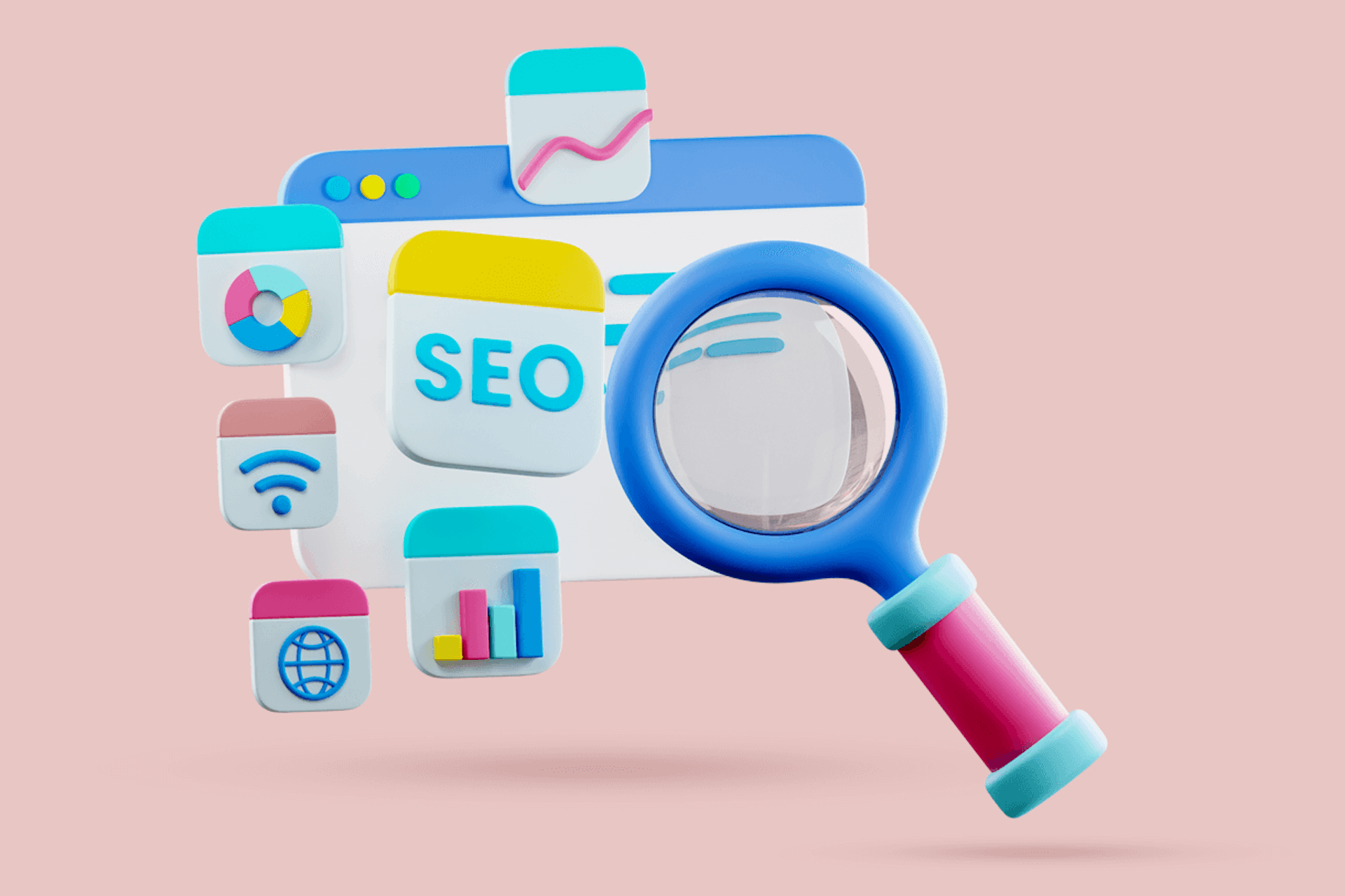
How to Write SEO Optimized Content
Sep 29, 2023
12 min. read
Let’s be honest: all that time, effort, and brainpower you put into content marketing for your brand are useless if no one sees it. Sure, you can always share your blogs on social media or with your email subscribers. But for many brands, the bread and butter of their business comes from search traffic. That’s where writing SEO optimized content plays a huge role.
Search engine optimization, or SEO , is the practice of making your content easily understood and discoverable by search engine algorithms. This way, when someone searches for something you offer, you stand a better chance of appearing higher in the search rankings.
Here’s a rapid-fire guide on how to write SEO-optimized content.
What Is Search Engine Optimization (SEO)?
Why is seo important in content writing, how to think about your seo content strategy.
7 SEO Content Writing Tips to Try Today
Tools to Help You with SEO Content Writing
SEO is the process of optimizing your web content to help increase your rankings placement in a search engine. Blog posts, landing pages, and even images can be SEO optimized to make them easier to find via search.
For example, let’s say your company offers a media intelligence platform 😏. In this case, you want anyone searching for keywords like “ reputation management ” or “ how to contact journalists ” or “ PR marketing strategy ” to find and click on you in search results. If you have SEO optimized content, you'll show up before, or close to your competitors, ideally "above the fold" on a search engine page.
SEO is an amalgamation of many moving parts, including:
- On-page SEO
- Off-page SEO
- Keyword research
- LSI keywords
- Anchor text
- Meta descriptions and title tags
- Internal links
- External links
- Bounce rate
This isn’t an exhaustive list, but these are some of the most important considerations when optimizing content for SEO.
- Earn organic traffic
- Reduce customer acquisition costs
- Rank higher in search engines
- Brand recognition
- Outrank competitors for industry searches
Google's algorithm favors high-quality content , plain and simple. Content quality is determined based on based on several factors, such as the presence of internal links and external links , keyword frequency and placement, content length, headings, and more.
Logically speaking, a search engine's role is to return the most relevant search results to its users . That’s why it looks for certain signals that indicate a good match between query and content .
The more high-quality content you write, the better chances you have of ranking for your desired keywords.
Ranking matters because it helps to drive more people to your brand . And the more people who discover your brand, the more authoritative you become. This means more reputable websites will link to you, which leads to more brand awareness on the part of the consumer. So when they search again for related keywords, they will recognize your name above others. Good SEO optimized content is a self fulfilling prophecy!
Every time someone clicks on your content on the Search Engine Results Page ( SERP ), it indicates to Google that they returned a good match to your search query .
SEO content helps you earn organic website traffic . Search engine optimization does a lot of the heavy lifting for you simply by positioning you in front of people actively searching for what you know, sell, or provide. In turn, this can help you lower customer acquisition costs, reduce ad spend, and increase brand awareness .
Simply checking the boxes on a list of SEO-focused suggestions isn’t enough to rank well. There’s a rhyme and reason behind SEO-friendly content .
Here’s how to approach an SEO content strategy:
Keyword Usage in SEO
Backlinks in seo, content ideas for seo.
Quality Content for SEO
Tip: Learn more about search engine optimization in one of the best SEO podcasts .

Keywords are what drive every SEO content strategy. A keyword is a term that someone types into a search engine, such as Google, with the goal of finding information, solutions, or a product.
Tip: A "keyword" can mean a single word, or a phrase
You can use data-driven SEO tools like AHREFS or SEMRush to find relevant keywords in your niche or industry. In most cases you will want to choose keywords that have a high search volume and low competition. There are times, however, when your strategy should take into consideration what are called "long tail keywords". These are keywords that may have far less search volume, but are also far less competitive. Meaning that you have a better chance of dominating those search results.
Where to place your keywords
Where you place keywords within your content matters.
Your main keyword should be included in the...
- Title (and title tag and meta description)
- First paragraph
- At least one H2 header within the content
- Sprinkled naturally throughout the rest of the content
Aim for a 1-2% keyword density , as using the keyword too many times can get you flagged for keyword stuffing.
Use LSI keywords
You should also include Latent Semantic Indexing (LSI) keywords , which are keywords that are related to your main keyword .
For example, if you’re writing about SEO, an LSI keyword could be “search engine optimization” or “SEO copywriting.” LSI keywords add context to your content and help the algorithms better understand what your content is about .
Consider search intent
Last but certainly not least, consider the intent behind the search . Keyword intent takes the user’s thought process into account. In other words, why would a user be searching for this keyword?
For example, if someone is searching for a “red blazer,” chances are they want to buy a red blazer. They’re likely not interested in how to make a red blazer or when blazers first entered the fashion industry.
The three most common search intent types are informational , transactional , and navigational . Using long-tail keywords can help you get more specific about the type of searches you want to attract.
Internal links and external links in your content are quality indicators . It’s an easy way to provide access to additional information or sources to support your own content, and it also signals that you're not trying to operate in an echo-chamber or only link to yourself.
Ideally, you have a link-building strategy in place to gain links from outside sources that point back to your own website, using descriptive and contextual anchor text . Inbound links demonstrate that other sources have deemed your content reliable and high-quality, and search algorithms pick up on this activity and reflect positively on you.

If you want to increase your rankings, and are looking for content ideas, a good place to start is to discover what people are already searching for in your wheelhouse, and then build content clusters around them.
Again, this circles back to good keyword research . When you can find high-volume keywords, you can potentially reach more people with your content.
Tip: If you aren't ready to dive into an in-depth keyword research exercise, you can use the " People also ask " and related searches that Google provides.
In this example, we used the keyword "How to garden". In "People also ask" Google has hinted at plenty of other ways we could expand on this search, to provide users with more relevant articles:

Quality content for SEO
Serving its users quality content is Google’s main goal . But since the term “quality” is subjective, how can you ensure your content is higher quality than other content that’s already ranking well?
There's more to well-optimized content than being well-written.
The best practice is to r esearch what’s already been said about the topics you want to write about. Pay attention to the sources they link to, the length of the content, and any missed opportunities for improvement (e.g. adding an image, infographic, etc.).
Also, consider the user intent and make sure you’re writing to address the why behind the search. Your target keyword and related keywords should be specific enough to reflect the intent of your audience.
For example, if everyone else is writing in-depth guides on a topic, chances are you can’t write a 500-word blog post on that same topic and expect to rank well.
7 Content Optimization Tips to Try Today
Now that you have a baseline understanding of the role SEO plays content marketing and business strategy, let’s put it into practice in your writing. Use these SEO content writing tips when fleshing out your strategy:
1. Write for humans first, algorithms second
2. don't discount the headline, 3. include a meta description, 4. illustrate with images, 5. write long-form content in short sentences.
6. Keep creating fresh content
7. Hire an SEO copywriter

While SEO copywriting should appeal to algorithms, it must also make your human readers happy . You’re catering to real people, after all, so don’t make your writing so formulaic and robotic that it loses any emotion or clarity . This investment could have a big impact on boosting your campaign performance through semantic SEO .
This is especially important if you are using content marketing as part of your PR strategy . PR is all about humanizing your brand and appealing to your target audience through emotional connections.
Your headline will be the first thing users see and help them decide if your content will meet their needs. Studies show that 70% of us only read the headlines before sharing an article.
If you want people to share your content and drive even more free website traffic, you need to spend time crafting a good headline that sets the right expectations.

The meta description is the small snippet of text that appears under the search result title . It’s a preview that shows the reader what the article is about, which can encourage them to click through.
If you do not specify a meta description, Google might create one for you based on your content. It’s best to choose how this meta description reads. You can usually make it more compelling than the search engines.
To optimize your meta description, include your main keyword and give a brief description of what your content is about.
Images help to break up long walls of text and make your content more attractive . Plus, images can help to illustrate your story or article and provide even more value to the reader (think charts, graphs, etc.).
Images can help keep your content engaging. A content marketing metric that Google also takes into account is bounce rate . If users leave your page shortly after arriving, this means your content wasn't relevant to them (so you may have had too click-baity of a meta title. Tsk tsk!). And this action can result in a penalty from search engines.
Google is starting to favor websites that provide better accessibility, so another positive reason to use imagery with descriptive alt text is to help the visually impaired .
Your content should be written to cater to the average reader. Using short sentences (~20 words or fewer) supports user-friendly content. Plus, it’s easier for algorithms to skim and comb your content, especially if it's a longer piece.
6. Keep Creating Fresh Content

Another quality signal is the age of your content . SEO content marketing isn’t a one-and-done activity, but rather an ongoing journey. Regularly creating fresh content helps you continue building authority and brand awareness .
You can also update existing content with new facts, links, stats, and images. Search engines take notice when content has been updated.
7. Hire an SEO Copywriter
If you’re not ready to dive into an SEO strategy yourself, hire someone who is already skilled in all things SEO. An SEO copywriter is like a secret superpower that helps you start leveraging all of these tips immediately.
As you’re beginning your SEO content marketing journey, there are plenty of tools to help you on your way. The right digital marketing tools can help you spot opportunities to discover topics to write about, improve optimization, and even track analytics and performance.
Here are our favorite tools for SEO, in no particular order:
UberSuggest
Hemingway app.

If you’re just getting started with keyword research, UberSuggest is a simple yet powerful keyword tool. It’s free to try and will give you a long list of relevant keywords, search volume, and difficulty.

For more advanced keyword research and backlink building, ahrefs is a tool used by larger agencies. It will track your backlink performance so you can monitor your brand authority. Plus, get insight into the keywords your competitors are ranking for so you can one-up them.

For help with SEO writing, there’s Hemingway App. This free online tool lets you copy and paste your content and “grades” it based on complexity. It highlights areas that you can simplify to make them more reader-friendly, helping you appeal to your target audience and search algorithms alike.
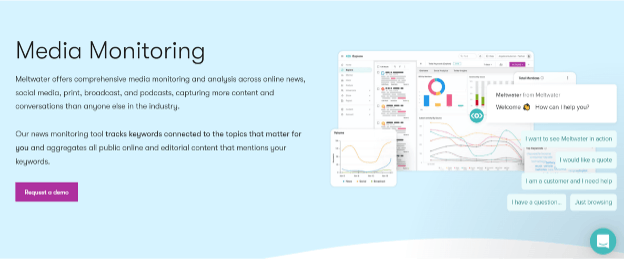
Just fill out the form below for a free tour!
Writing SEO content takes all the pieces of a very large puzzle into account. The good news: it gets easier the more you practice. You’ve got to start somewhere, so put this guide to SEO into practice today and watch your impact grow over time.
Continue Reading
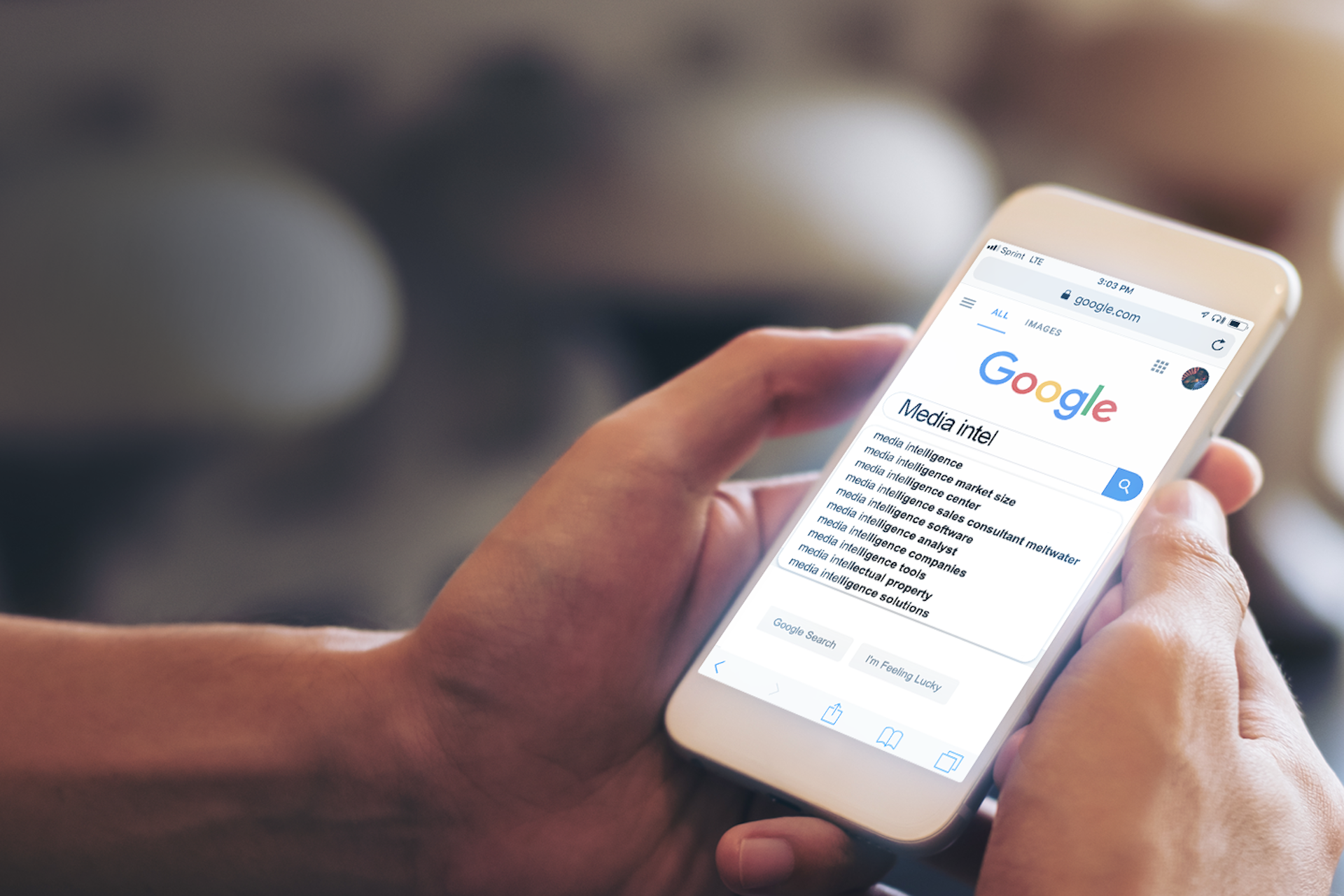
Harnessing PR to Drive SEO
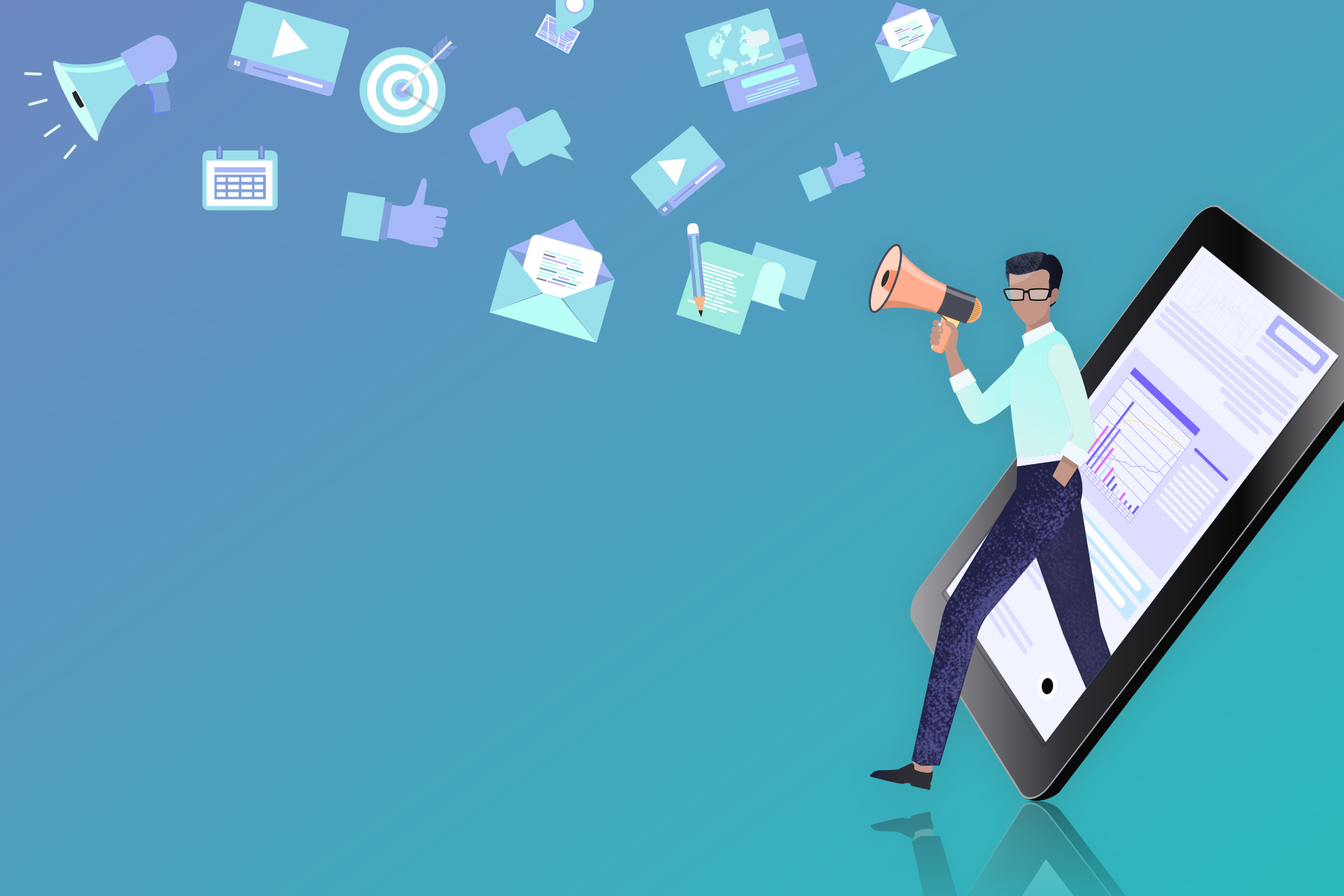
Content Marketing for Social Media Managers

8 Content Marketing Trends You Need to Know For 2024
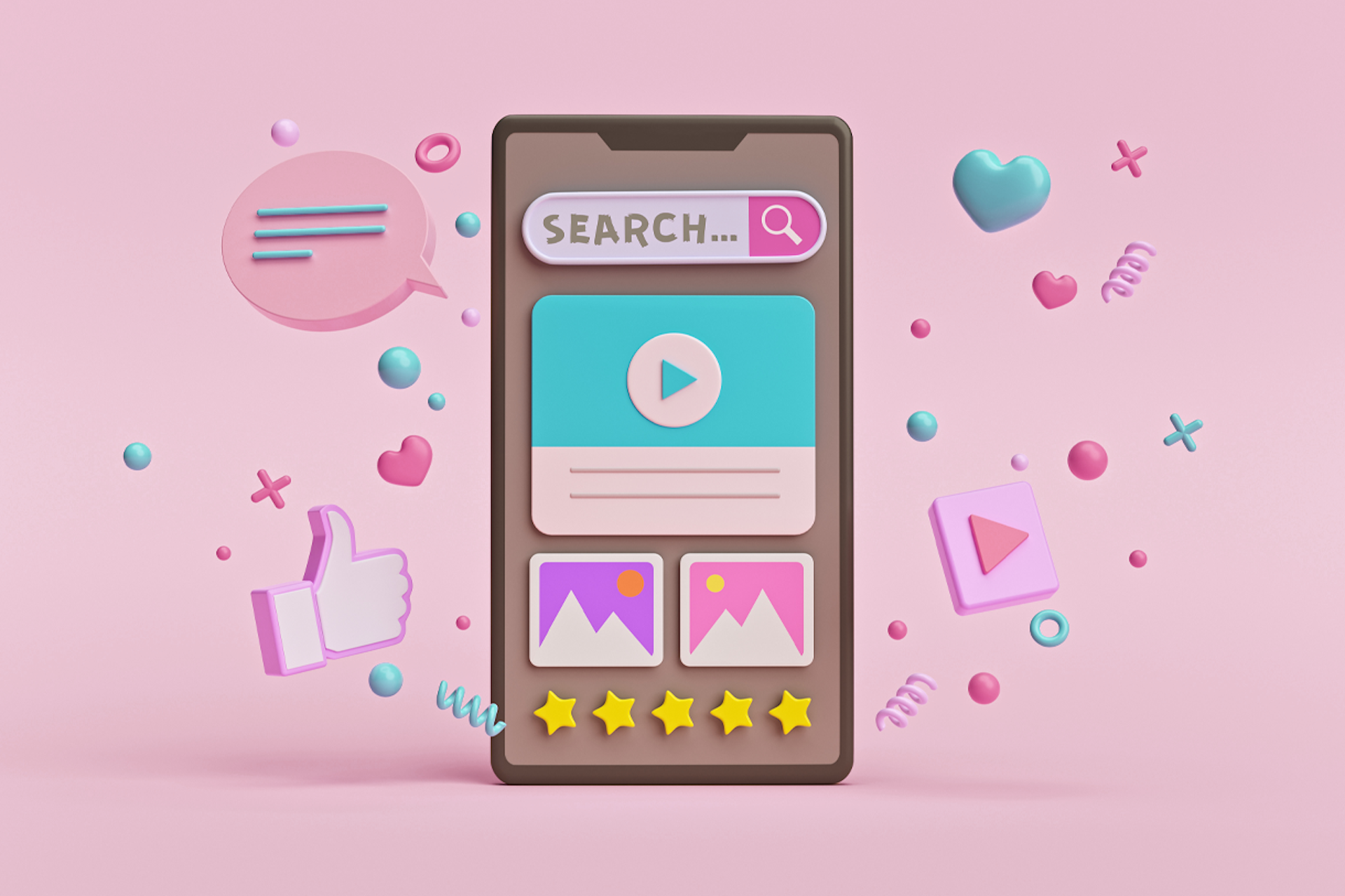
How to Succeed with Content Marketing: A Comprehensive Guide

How To Build an Effective Content Marketing Strategy [Content Calendar Template]

YouTube SEO Tips: How to Optimize Your Videos for Search

Your PR SEO Super Powers

The 14 Best SEO Podcasts 2024
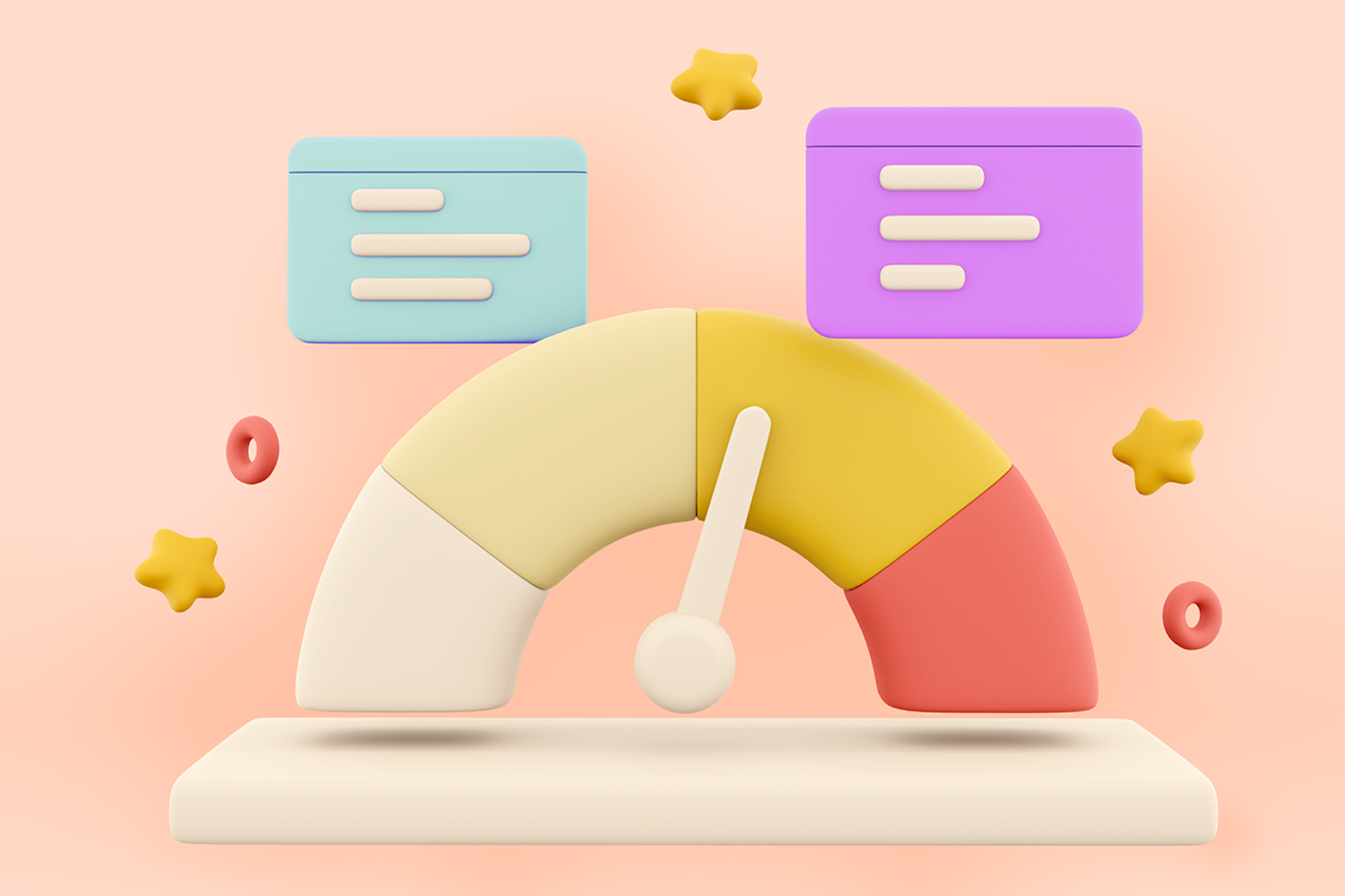
50 Content Marketing Metrics to Measure Your Campaign
- Google Search Central
- Español – América Latina
- Português – Brasil
- Tiếng Việt
- Documentation
- Search Central
Search Engine Optimization (SEO) Starter Guide
When you built your website, you likely created it with your users in mind, trying to make it easy for them to find and explore your content. One of those users is a search engine, which helps people discover your content. SEO—short for search engine optimization—is about helping search engines understand your content, and helping users find your site and make a decision about whether they should visit your site through a search engine.
The Search Essentials outline the most important elements of what makes your website eligible to appear on Google Search. While there's no guarantee that any particular site will be added to Google's index, sites that follow the Search Essentials are more likely to show up in Google's search results . SEO is about taking the next step and working on improving your site's presence in Search . This guide will walk you through some of the most common and effective improvements you can do on your site.
There are no secrets here that'll automatically rank your site first in Google (sorry!). In fact some of the suggestions might not even apply to your business, but following the best practices will hopefully make it easier for search engines (not just Google) to crawl, index, and understand your content.
How does Google Search work?
Google is a fully automated search engine that uses programs called crawlers to explore the web constantly, looking for pages to add to our index. You usually don't need to do anything except publish your site on the web. In fact, the vast majority of sites listed in our results are found and added automatically as we crawl the web. If you're hungry for more, we have documentation about how Google discovers, crawls, and serves web pages .
How long until I see impact in search results?
Every change you make will take some time to be reflected on Google's end. Some changes might take effect in a few hours, others could take several months. In general, you likely want to wait a few weeks to assess whether your work had beneficial effects in Google Search results. Keep in mind that not all changes you make to your website will result in noticeable impact in search results; if you're not satisfied with your results and your business strategies allow it, try iterating with the changes and see if they make a difference.
Help Google find your content
Before you actually do anything mentioned in this section, check if Google has already found your content (maybe you don't need to do anything!). Try searching on Google for your site with the site: search operator . If you see results pointing to your site, you're in the index. For example, a search for site:wikipedia.org returns these results . If you don't see your site, check out the technical requirements to make sure there's nothing technically preventing your site from showing in Google Search, and then come back here.
Google primarily finds pages through links from other pages it already crawled. In many cases, these are other websites that are linking to your pages. Other sites linking to you is something that happens naturally over time, and you can also encourage people to discover your content by promoting your site .
If you're open to a little technical challenge, you could also submit a sitemap —which is a file that contains all the URLs on your site that you care about. Some content management systems (CMS) may even do this automatically for you. However this isn't required, and you should first focus on making sure people know about your site .
Check if Google can see your page the same way a user does
When Google crawls a page, it should ideally see the page the same way an average user does . For this, Google needs to be able to access the same resources as the user's browser. If your site is hiding important components that make up your website (like CSS and JavaScript ), Google might not be able to understand your pages, which means they might not show up in search results or rank well for the terms you're targeting.
If your pages have different information depending on the user's physical location, make sure you're satisfied with the information that Google sees from its crawler's location, which is generally the US.
To check how Google sees your page, use the URL Inspection Tool in Search Console .
Don't want a page in Google's search results?
It might be important for you to opt out your site as a whole or sections of it from appearing in search results. For example, you might not want your posts about your new embarrassing haircut to show up in search results. Google supports various ways that lets you opt out of crawling and indexing of your URLs. If you need to block some files, directories, or even your whole site from Google Search, check out our guide about ways to prevent content from appearing in search results .
Organize your site
When you're setting up or redoing your site, it can be good to organize it in a logical way because it can help search engines and users understand how your pages relate to the rest of your site. Don't drop everything and start reorganizing your site right now though: while these suggestions can be helpful long term (especially if you're working on a larger website), search engines will likely understand your pages as they are right now, regardless of how your site is organized.
Use descriptive URLs
Parts of the URL can be displayed in search results as breadcrumbs, so users can also use the URLs to understand whether a result will be useful for them.
Google learns breadcrumbs automatically based on the words in the URL, but you can also influence them with structured data if you like a technical challenge. Try to include words in the URL that may be useful for users; for example:
https://www.example.com/pets/cats.html
A URL that only contains random identifiers is less helpful for users; for example:
https://www.example.com/2/6772756D707920636174
Group topically similar pages in directories

If you have more than a few thousand URLs on your site, how you organize your content may have effects on how Google crawls and indexes your site. Specifically, using directories (or folders) to group similar topics can help Google learn how often the URLs in individual directories change.
For example, consider the following URLs:
https://www.example.com/policies/return-policy.html
https://www.example.com/promotions/new-promos.html
The content in the policies directory seldomly changes, however the content in the promotions directory likely changes very often. Google can learn this information and crawl the different directories at different frequencies. To learn more about search-friendly site structures, check out our guide for ecommerce sites , for which a good URL structure is more important as they tend to be larger.
Reduce duplicate content
Some websites show the same content under different URLs, which is called duplicate content . Search engines choose a single URL (the canonical URL) to show users, per piece of content.
Having duplicate content on your site is not a violation of our spam policies, but it can be a bad user experience and search engines might waste crawling resources on URLs that you don't even care about. If you're feeling adventurous, it's worth figuring out if you can specify a canonical version for your pages. But if you don't canonicalize your URLs yourself, Google will try to automatically do it for you.
When working on canonicalization, try to ensure that each piece of content on your site is only accessible through one individual URL; having two pages that contain the same information about your promotions can be a confusing user experience (for example, people might wonder which is the right page, and whether there's a difference between the two).
If you have multiple pages that have the same information, try setting up a redirect from non-preferred URLs to a URL that best represents that information. If you can't redirect, use the rel="canonical" link element instead. But again, don't worry too much about this; search engines can generally figure this out for you on their own most of the time.
Make your site interesting and useful
Creating content that people find compelling and useful will likely influence your website's presence in search results more than any of the other suggestions in this guide. While "compelling and useful content" can mean different things to different people, content like this generally shares some common attributes, such as:
- The text is easy-to-read and well organized : Write content naturally and make sure the content is well written, easy to follow, and free of spelling and grammatical mistakes. Break up long content into paragraphs and sections, and provide headings to help users navigate your pages.
- The content is unique : When you're writing new content, don't copy others' content in part or in its entirety: create the content yourself based on what you know about the topic. Don't just rehash what others already published.
- The content is up-to-date : Check in on previously published content and update it as needed, or even delete it if it's not relevant anymore.
- The content is helpful, reliable, and people-first : Be sure that you're writing content that your readers will find helpful and reliable. For example, providing expert or experienced sources can help people understand your articles' expertise.
Expect your readers' search terms
Think about the words that a user might search for to find a piece of your content. Users who know a lot about the topic might use different keywords in their search queries than someone who is new to the topic. For example, some users might search for "charcuterie", while others might search for "cheese board". Anticipating these differences in search behavior and writing with your readers in mind could produce positive effects on how your site performs in search results.
However, don't worry if you don't anticipate every variation of how someone might seek your content. Google's language matching systems are sophisticated and can understand how your page relates to many queries, even if you don't explicitly use the exact terms in them.
Avoid distracting advertisements
While ads are a part of the internet and are meant to be seen by users, don't let them become overly distracting or prevent your users from reading your content. For example, advertisements, or interstitial pages (pages displayed before or after the content you're expecting) that make it difficult to use the website.
Link to relevant resources
Links are a great way to connect your users and search engines to other parts of your site, or relevant pages on other sites. In fact, the vast majority of the new pages Google finds every day are through links, making links a crucial resource you need to consider to help your pages be discovered by Google and potentially shown in search results. Additionally, links can also add value by connecting users (and Google) to another resource that corroborates what you're writing about.

Write good link text
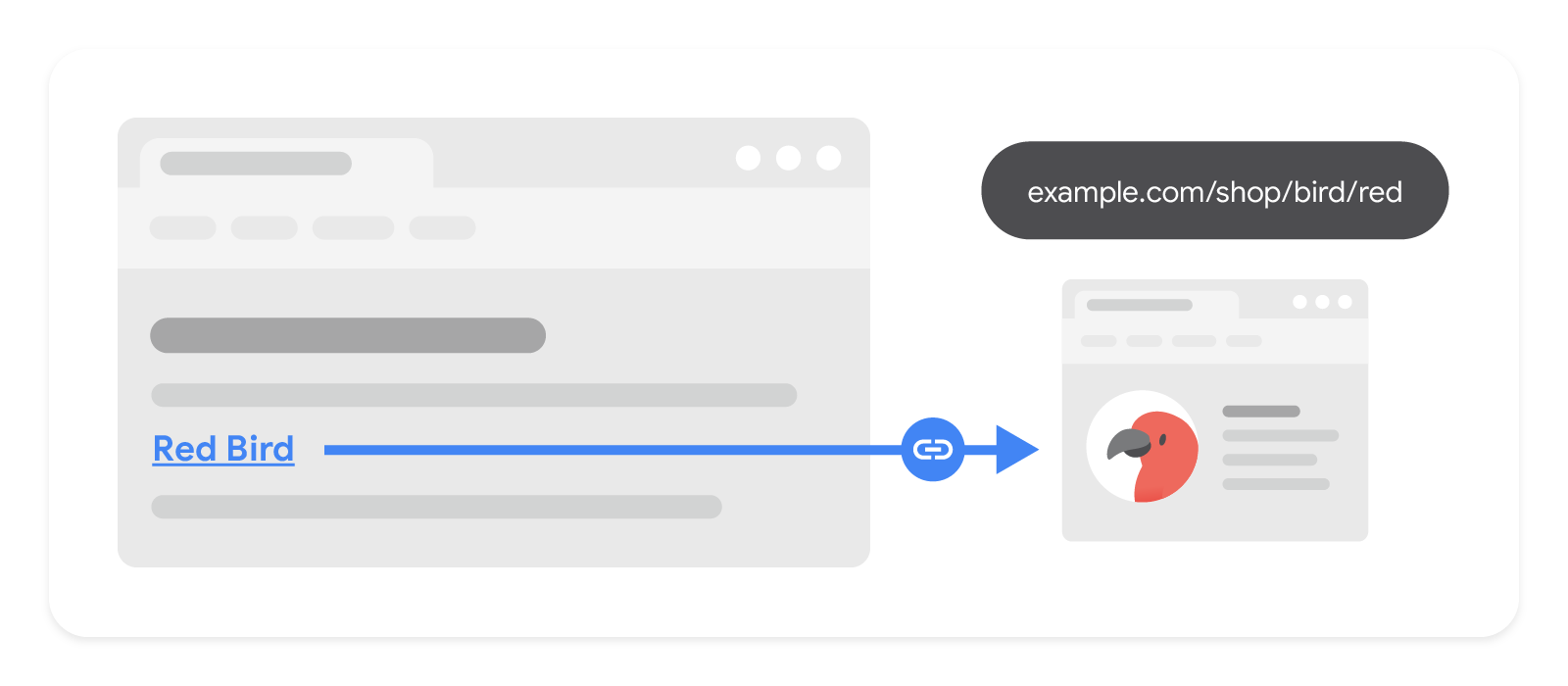
Link when you need to
Links can provide more context on a topic, both for users and search engines, which may help demonstrate your knowledge on a topic. However when you're linking to pages outside of your control, for example content on other sites, make sure you trust the resource you're linking to. If you can't trust the content and you still want to link to them, add a nofollow or similar annotation to the link to avoid search engines associating your site with the site you're linking to. This helps avoid potential negative consequences in your rankings in Google Search.
If you're accepting user-generated content on your site, such as forum posts or comments, make sure every link that's posted by users has a nofollow or similar annotation automatically added by your CMS. Since you're not creating the content in this case, you likely don't want your site to be blindly associated with the sites users are linking to. This can also help discourage spammers from abusing your website.
Influence how your site looks in Google Search
A typical Google Search results page consists of a few different visual elements that you can influence to help users decide whether they should visit your site through those search results. In this section, we're focusing on the title link and the snippet because these are the more visually significant elements.
Influence your title links
How to make your own chili oil
The title link is the headline part of the search result and it can help people decide which search result to click. There are a few sources that Google uses to generate this title link, including the words inside the <title> element (also called the title text) and other headings on the page. This title text can also be used for the title that's shown in browsers and bookmarks.

You can influence the title links in Search by writing good titles: a good title is unique to the page, clear and concise, and accurately describes the contents of the page. For example, your title could include the name of your website or business, other bits of important information like the physical location of the business, and maybe some information about what the particular page has to offer for users. Our documentation about title links has more tips about how to create good titles and how to influence your site's search results' title links.
Control your snippets
Below the title link, a search result typically has a description of the target page to help users decide whether they should click the search result. This is called a snippet .
Learn how to cook eggs with this complete guide in less than 5 minutes. We cover all the methods, including sunny side up, boiled, and poached.
The snippet is sourced from the actual content of the page the search result is linking to, thus you have complete control over the words that can be used to generate the snippet. Occasionally the snippet may be sourced from the contents of the meta description tag, which is typically a succinct, one- or two-sentence summary of the page. A good meta description is short, unique to one particular page, and includes the most relevant points of the page. Check out our tips for writing good meta descriptions for more inspiration.
Add images to your site, and optimize them
Many people search visually, and images can be how people find your website for the first time. For example, if you have a recipe blog, people might find your content by searching for "fruit tart recipes" and browsing photos of various types of fruit tarts.
As you add images to your site, make sure that people and search engines can find and understand them.
Add high-quality images near relevant text
When you use high quality images, you give users enough context and detail to decide which image best matches what they were looking for. For example, if people are looking for "daisies" and come across a rogue edelweiss in search results, a higher quality image would help them distinguish the type of flower.
Use images that are sharp and clear, and place them near text that's relevant to the image. The text that's near images can help Google better understand what the image is about and what it means in context to your page.
For example, if the page is reviewing yarn shops in London, then it would make sense to embed one of your photos of the yarn shop in the section that details the location, description, and review information for that yarn shop. This helps Google and users associate the image with text that provides more context to what the page is about.
Add descriptive alt text to the image
Alt text is a short, but descriptive piece of text that explains the relationship between the image and your content. It helps search engines understand what your image is about and the context of how your image relates to your page, so writing good alt text is quite important. You can add this to your HTML with the alt attribute of the img element, or your CMS may have an easy way to specify a description for an image when you're uploading it to your site. Learn more about how to write good alt text , and how to add it to your images.
Optimize your videos
If your website includes pages that are primarily about individual videos, people may also be able to discover your site through video results in Google Search. Many of the best practices for images and text also apply to videos:
- Create high-quality video content, and embed the video on a standalone page, near text that's relevant to that video.
- Write descriptive text in the titles and description fields of a video (the title of a video is still a title, and so you can apply the best practices for writing titles here too).
If your site is particularly video-focused, then continue reading about more things you can do to optimize your videos for search engines .
Promote your website
Effectively promoting your new content will lead to faster discovery by those who are interested in the same subject, and also by search engines. You can do this in many ways:
- Social media promotion
- Community engagement
- Advertisement, both offline and online
- Word of mouth, and many other methods
One of the most effective and lasting ways is word of mouth: that is, people familiar with your site tell their friends about it, who in turn visit your site. This can take time, and usually you need to invest some time and effort in other practices first, such as community engagement. Our friends over at Google for Creators have excellent resources about building and engaging your audience .
Putting effort into the offline promotion of your company or site can also be rewarding. For example, if you have a business site, make sure its URL is listed on your business cards, letterhead, posters, and other materials. With their permission, you could also send out recurring newsletters to your audience letting them know about new content on your website.
As with everything in life, you can overdo promoting your site and actually harm it: people may get fatigued of your promotions, and search engines may perceive some of the practices as manipulation of search results .
Things we believe you shouldn't focus on
As SEO has evolved, so have the ideas and practices (and at times, misconceptions) related to it. What was considered best practice or top priority in the past may no longer be relevant or effective due to the way search engines (and the internet) have developed over time.
To help you focus on the things that are actually important when it comes to SEO, we collected some of the most common and prominent topics we've seen circulating the internet. In general, our message on these topics is that you should do what's best for your business area; we will elaborate on a few specific points here:
- Get started with Search Console : Setting up a Search Console account helps you monitor and optimize how your website performs on Google Search. Learn how to set up your account and what reports to check out first .
- Maintain your website's SEO over time : Learn more about managing your site's presence in the long term , including more in-depth SEO tasks and scenarios, such as preparing for a site move, or managing a multi-lingual site.
- Enhance how your site looks in Google Search results : Valid structured data on your pages also makes your pages eligible for many special features in Google Search results, including review stars, carousels, and more. Explore the gallery of search result types that your page can be eligible for.
Stay informed and ask questions
As you embark on your SEO journey, here are some resources that can help you stay on top of changes and new resources we publish:
Except as otherwise noted, the content of this page is licensed under the Creative Commons Attribution 4.0 License , and code samples are licensed under the Apache 2.0 License . For details, see the Google Developers Site Policies . Java is a registered trademark of Oracle and/or its affiliates.
Last updated 2024-03-18 UTC.
- On-page SEO
- 13 min read
32 SEO Content Writing Tips (The Ultimate Guide)
- Published February 2, 2024
To excel in SEO content writing, create content that resonates with your audience while satisfying search engine algorithms. Craft each piece to rank factors in mind, ensuring it’s optimized for search engines.
Remember, breaking down your content into digestible sections and maintaining an active voice will enhance the readability and SEO-friendliness of the areas of your content. Embrace the ultimate guide to content creation by utilizing SEO strategies that align with engine algorithms and user expectations.
Incorporate content with subheadings to provide clear navigation for both users and search engines, facilitating better comprehension and engagement.
Understanding the Essentials of SEO Content Writing
SEO content writing intertwines with engine algorithms, catering to ranking factors by crafting content optimized for search engines. Using content with subheadings, breaking down your content into manageable chunks, and utilizing an active voice pave the way for a more engaging user experience and improved visibility in search results.

Defining SEO Writing for Clarity and Purpose
Avoid keyword stuffing and focus on integrating target keywords and long-tail keywords to optimize your content effectively. Utilize SEO tools for keyword optimization, ensuring you include relevant keywords and phrases that drive organic traffic to your site.
Optimizing your content for search engines is an integral part of digital marketing that cannot be overlooked if you wish to succeed.
The Significance of SEO in Digital Content Creation
SEO plays a pivotal role in digital content creation, shaping the strategy that ensures the right audience discovers your material. By optimizing content for search engines, you allow your brand to connect with potential customers, driving valuable organic traffic to your website.
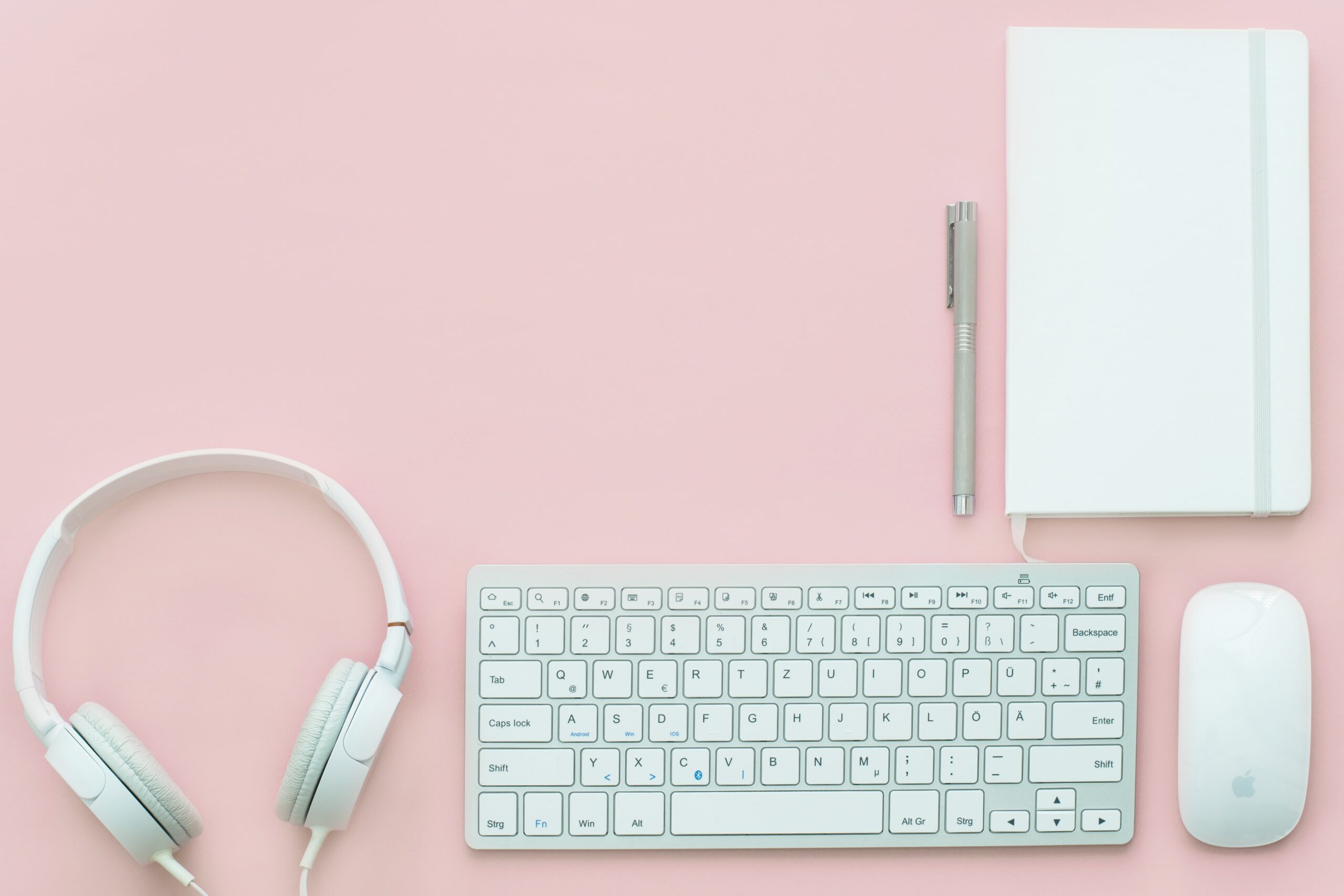
Laying the Groundwork for SEO Success
SEO writing is the process of crafting content to rank well in engines like Google. The journey begins with writing high-quality content that resonates with your audience and adheres to SEO best practices, laying a solid foundation for online visibility and success.
Starting With Solid Keyword Research
Conduct keyword research to understand what potential customers are searching for. Identify the right keyword to target, gather a list of keyword ideas to guide your content strategy, and ensure your material reaches the intended audience.
Identifying Primary and Secondary Keywords
Determine your primary keyword to target, then optimize your content around it. Additionally, select secondary keywords to enhance your SEO strategy, ensuring comprehensive coverage of topics relevant to your audience’s interests.
Aligning Content With User Search Intent
Align your content with the informational intent of your audience. Choose content formats and design landing pages that cater to user needs, increasing the chances of engine visibility.
Strategically place keywords in your content to meet the aspect of SEO that speaks directly to user search intent.
Join 800+ to receive a weekly SEO video from my YouTube channel, which I’ll share. And on top of that, an actionable SEO tip every week.
Conducting a Thorough Content Audit
Review your existing content to determine its effectiveness and identify opportunities for improvement. A thorough content audit helps ensure your website remains relevant and authoritative in your niche.
Crafting High-Quality, SEO-Friendly Content
Creating high-quality, SEO-friendly content involves understanding the balance between engaging human readers and optimizing your content for search engines. Writing for SEO does not mean sacrificing quality; instead, it’s about naturally integrating keywords into your content and prioritizing the user’s reading experience.
Prioritizing Readability and Engagement
When writing for SEO, prioritize readability and engagement to retain human readers. Optimizing your content for search engines should never come at the expense of user experience.
Focus on delivering value and clarity with every piece of content you produce.
Structuring Content With Clear Subheadings
Structure your content with clear subheadings to guide readers through your article. This organization benefits human readers and helps search engines understand the hierarchy and relevance of your content, contributing to better SEO performance.
Writing for Your Audience First and Foremost
While keyword stuffing is to be avoided, strategically incorporating target, long-tail, and relevant keywords and phrases throughout your content is crucial. Use SEO tools to refine your keyword optimization and ensure you’re addressing your audience’s pain points.
Remember, the primary goal is to drive organic traffic by creating content for search engines that also resonates with your audience.
Ensuring Content Originality and Depth
Originality and depth are essential in SEO copywriting to provide valuable content that stands out in a crowded digital landscape. Unique, in-depth content not only engages readers but also signals to search engines the quality and relevance of your website.
On-Page SEO Elements to Optimize
On-page SEO elements, such as title tags, headings, and meta descriptions, are critical for search engines to understand and rank your content effectively. Ensure these elements are well-optimized to enhance the SEO performance of your web pages.
Strategically Placing Keywords Throughout Your Content
Integrating keywords naturally into your content is a cornerstone of content optimization. To rank your content, consider tools like Google Trends and concepts such as latent semantic indexing to enhance relevance.
The placement of keywords should feel seamless, enriching the reader’s experience without disrupting the narrative flow.
Composing Meta Descriptions That Reflect Your Keywords
Meta descriptions are a brief preview that entices users to click through from search results. Employ strategies to boost visibility by including multiple keywords that align with user queries.
This succinct sales pitch for your page must resonate with potential visitors, reflecting the core message of your content.
Creating SEO-Optimized Title Tags for Maximum Impact
Title tags are crucial for search visibility and should encapsulate your primary keyword. An effective headline is brief, with a recommended span of 160 characters, including spaces.
This constraint challenges writers to convey the essence of their content compellingly and concisely.
Leveraging Power Words in Titles for Increased CTR
Using powerful words in titles can significantly enhance search results’ click-through rate (CTR). These emotionally charged triggers provoke curiosity and excitement, drawing readers into the content.
Using powerful words can be a game-changer in driving traffic to your site.
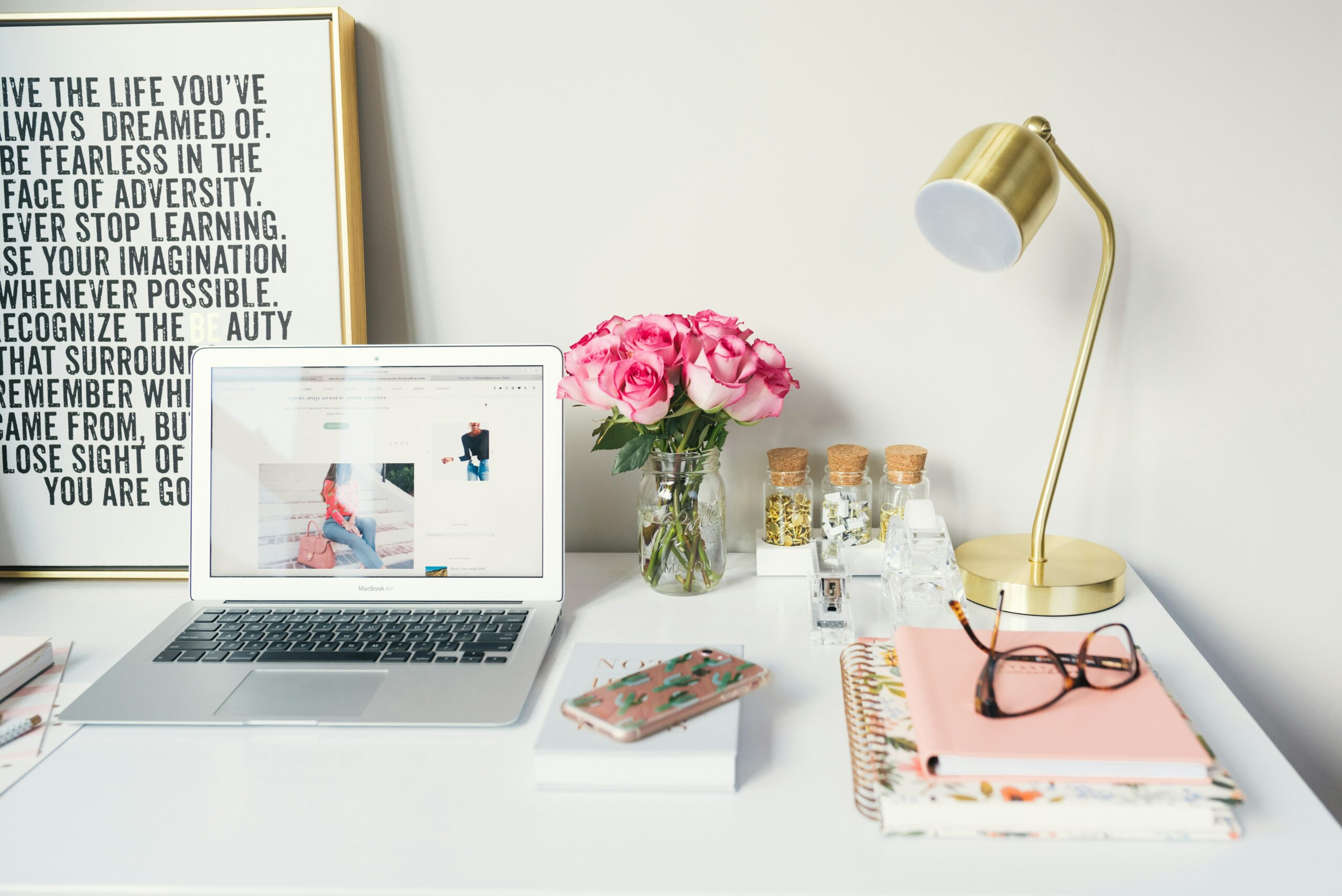
Visuals and Multimedia: Enhancing SEO Content
Visual elements captivate and help improve engine rankings by making content more shareable and engaging. Multimedia, such as images, infographics, and videos, can break up large blocks of text, making complex information easier to digest and understand for the audience.
Adding Alt Text to Images for Better Accessibility
Alt text is a critical component that provides a text alternative for images, aiding the visually impaired. This description helps screen readers interpret what is displayed, improving accessibility and enhancing the user experience for all website visitors.
Incorporating Visuals to Break up Text and Aid Comprehension
Interspersing relevant visuals throughout written content can significantly aid reader comprehension. This strategy caters to visual learners and enhances the overall aesthetic of your content, making it more appealing and easier to navigate.
Including Transcripts for Video and Audio Content
Search engines like Google rely on text to understand and index multimedia content. Providing transcripts for video and audio content ensures that these resources contribute to your site’s relevance for related search queries, thereby enhancing SEO.
Improving Site Performance and User Experience
Boosting your site’s performance can increase your chances of ranking higher on search engine results pages. A key aspect of performance is optimizing for readability, which includes using bullet points and short paragraphs to make content easily digestible for users.
Boosting Page Load Speed With Compressed Images
Page load speed is a vital factor in user experience and SEO. Compressing images without compromising quality can significantly reduce load time, leading to better user engagement and potentially lower bounce rates.
Making Your Content Easily Scannable
Content scannability is essential for keeping readers engaged. The ideal length of sections and the strategic use of headers can help readers quickly find the information they need, enhancing their experience on your site.
Designing a Mobile-Friendly Layout
With the increasing use of mobile devices for internet browsing, creating a mobile-friendly layout is imperative. A responsive design ensures that content is easily accessible and readable across various screen sizes, improving the user experience.
Building Authority With Strategic Linking
SEO copywriting isn’t just about creating content; it’s about weaving a network of links that establish your site’s authority. Strategic linking to reputable sources and relevant internal content can enhance your site’s credibility and authority in search engines’ and users’ eyes.
Linking to High-Authority External Websites
Linking out to high-authority external websites can show search engines that your content is well-researched and connected to reputable sources. This practice can lend credibility to your site and provide additional value to your readers.
Weaving Internal Links to Encourage Deeper Engagement
Internal linking is a powerful tool for keeping readers on your site. By using descriptive anchor text, you can guide visitors to other relevant content pieces, encouraging deeper engagement and providing additional context to your audience.
Crafting a Sustainable Link-Building Strategy
To build a link strategy that lasts, start by forging relationships with reputable sites that align with your content’s theme. Consistent outreach for guest posting and content collaboration can yield valuable backlinks.
Remember, it’s about quality, not just quantity. A portfolio of strong, relevant links will support your site’s authority and trustworthiness, which are essential for long-term SEO success.
Advanced SEO Content Strategies
Advancing your SEO strategy means going beyond the basics. Dive into detailed analytics to understand your content’s performance and adapt your approach accordingly.
Use A/B testing to refine your headlines and calls to action. Explore the potential of long-tail keywords and niche topics to capture highly targeted traffic, and never underestimate the power of updating old content to keep it relevant and ranking.
Optimizing Content for Featured Snippets
Structure your content to provide direct answers to common queries for a shot at the coveted featured snippets on Google. Use clear, concise language and bullet points to increase your chances of being featured.
These snippets often sit at the top of search results, offering significant visibility that can drive traffic to your site and establish your content’s authority.
Understanding and Utilizing Historical Optimization
Historical optimization breathes new life into your older content, ensuring it remains fresh and continues attracting organic traffic. By revisiting past articles, you can update them with current information, reflect changes in buyer personas, and improve their engine rankings.
This strategy keeps your content relevant and can lead to a resurgence in traffic and engagement. To keep your content fresh, regularly review and update your library, focusing on high-performing posts that can benefit from refreshed data and insights.
By aligning with current trends and user needs, historical optimization ensures that your content attracts the right audience and supports your overall SEO goals.
Creating an Editorial Calendar and Content Briefs
An editorial calendar is a roadmap for your content strategy, ensuring you cover diverse topics that resonate with your audience. Plan your topics and publishing schedule, and assign tasks to keep your content efforts organized.
Content briefs should outline the article’s goal, target keywords, including secondary keywords, and the intended audience, guiding writers to produce focused and effective content. Content briefs provide the foundation for each piece, detailing the tone, structure, and key messages.
Incorporating secondary keywords also caters to a broader range of search queries, enhancing your content’s visibility and reach. The editorial calendar and content briefs ensure a cohesive and strategic approach to your content creation efforts.
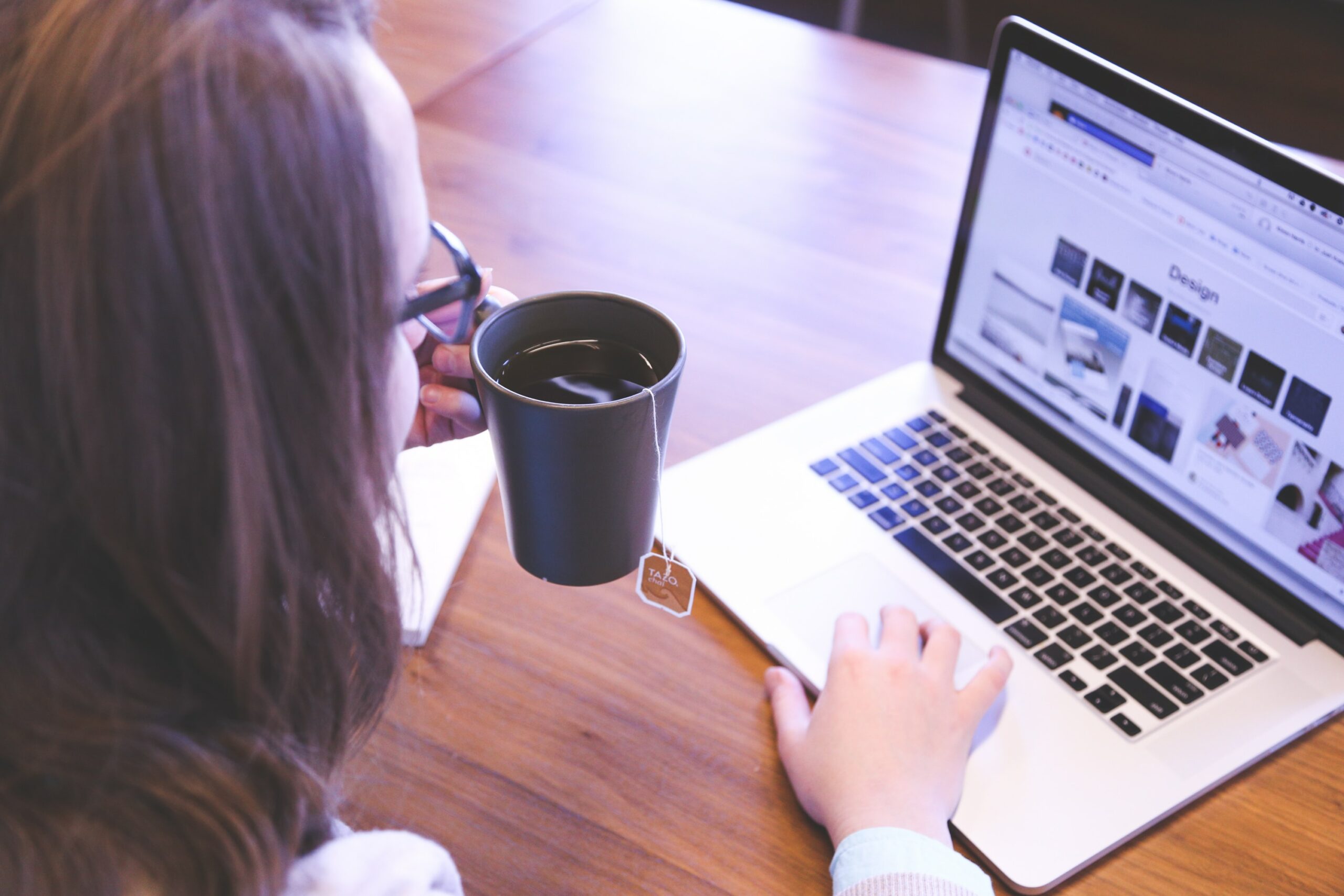
Measuring SEO Content Performance
Setting and identifying clear SEO goals is essential for measuring the success of your content. Whether you aim to increase organic traffic, improve engagement metrics, or boost conversions, having specific targets allows you to track progress and make data-driven decisions.
Use tools like Google Analytics to monitor these goals and understand how your content performs against them. Goals should be SMART: specific, measurable, achievable, relevant, and time-bound.
This approach ensures that you can accurately assess the impact of your SEO efforts and adjust your strategy as needed. Regular analysis of these goals will help refine your content approach and achieve better results.
Setting and Identifying SEO Goals for Content
To effectively measure content performance, start by setting specific SEO goals. These could range from increasing keyword rankings to boosting organic traffic.
Clearly defined goals help to focus your efforts and provide a benchmark for success. Employing tools like Google Analytics can help track these goals, offering insights into user behavior and content effectiveness.
Consider factors like your target audience, industry trends, and business objectives when identifying goals. This will help ensure that your SEO goals are aligned with your overall marketing strategy and contribute to your company’s growth.
Regularly review and update these goals to reflect market changes and consumer behavior shifts.
Publishing and Tracking Content Performance Metrics
Once content is published, tracking performance metrics to gauge its impact is crucial. Key indicators include page views, time on page, bounce rate, and conversion rates.
These metrics show how users interact with your content and what drives engagement. By closely monitoring these metrics, you can identify trends, uncover areas for improvement, and optimize future content.
Use tools like Google Analytics to gather data and track the performance of your content. This information is invaluable for understanding the effectiveness of your SEO strategy and making informed decisions.
Regularly reviewing these metrics allows you to adapt your approach, ensuring your content performs well and meets your SEO objectives.
Adjusting Strategies Based on Analytics Insights
Analytics insights offer a wealth of information that can inform your SEO strategy. By analyzing user behavior, traffic sources, and conversion data, you can identify what works and where there’s room for improvement.
Use this data to refine your content strategy, targeting more effective keywords, improving user experience, and aligning your content with audience interests. Adjustments based on analytics might include tweaking meta descriptions, altering the content structure, or revising internal linking strategies.
Making these changes can lead to better content performance and higher search rankings. It’s a cycle of continuous improvement driven by data and aimed at achieving the best possible results from your SEO efforts.
Continuous SEO Learning and Adaptation
SEO writing is the process of creating content that resonates with both users and search engines. The landscape of SEO is always changing, making it crucial to stay informed about the latest trends and algorithm updates.
This knowledge allows you to adapt your strategies and ensure your content continues to perform well in search engine rankings. Writing high-quality content is both an art and a science.
As you learn more about SEO best practices, you can refine your approach to content creation, ensuring that it not only engages readers but also meets the technical requirements of search engines. This continuous learning and adaptation are key to maintaining a strong online presence.
Staying Updated With SEO Trends and Algorithm Changes
SEO is an ever-evolving field, with Google’s algorithm updates constantly reshaping the digital landscape. Staying updated with these changes is vital to ensure your content strategies remain effective.
Subscribe to SEO news sources, follow thought leaders on social media, and participate in webinars or conferences to keep your knowledge current. Understanding algorithm changes helps predict shifts in content ranking factors, allowing you to adjust your strategies proactively.
This proactive approach can help maintain or improve your content’s visibility in search results, ensuring continued success in attracting and engaging your target audience.
Leveraging SEO Tools and Resources for Efficiency
SEO tools streamline the process of writing content to rank, offering insights into keyword performance, backlink profiles, and competitive analysis. Utilize these tools to conduct thorough research, track rankings, and identify opportunities for improvement.
They can significantly enhance your efficiency, helping you make data-driven decisions that impact your SEO success. Resources like keyword planners, analytics platforms, and content optimization software offer valuable support in crafting an effective SEO strategy.
By leveraging these tools, you can save time and resources, focusing your efforts on creating content that resonates with your audience and drives results.
Engaging With SEO Communities for Knowledge Sharing
Engaging with SEO communities provides a platform for knowledge sharing and support. Participate in forums, attend meetups, and join online groups where you can discuss strategies, exchange tips, and stay abreast of industry developments.
These communities offer a wealth of collective experience that can help you refine your SEO approach and avoid common pitfalls. By sharing your experiences and learning from others, you can gain new perspectives and insights to enhance your SEO content writing.
Collaboration and discussion within these communities can lead to innovative strategies and a deeper understanding of creating content that performs well in search engines.

Elevating Your Content With Proven SEO Writing Tips
Implementing these tips will help you create compelling, searchable content that drives traffic and engagement.
Summarizing Key Takeaways for Effective SEO Writing
Effective SEO writing avoids keyword stuffing and instead focuses on creating valuable content that naturally incorporates keywords. Utilizing SEO tools can help you identify the best keywords, analyze your competition, and track the performance of your content.
Remember, the goal is to serve your audience with informative and engaging content that also aligns with search engine requirements. Following these key takeaways can improve your content’s visibility and effectiveness.
Continuously learning and applying new SEO strategies will ensure that your content remains relevant and impactful, helping you achieve your digital marketing goals and drive success for your business.
Encouraging Ongoing SEO Education and Practice
Continuous education in the dynamic SEO world is vital to keep abreast of the latest trends and techniques. To maintain and improve SEO results, individuals should dedicate time to learning new skills and refining their strategies.
This includes staying informed about updates to search engine algorithms, which can affect page ranking on search engine results pages (SERPs). By committing to ongoing practice, they can test out theories, analyze outcomes, and refine their approach, ensuring their SEO knowledge remains current and effective.
Moreover, the commitment to ongoing education can simplify the process of adapting to changes within the industry. Regularly engaging with webinars, courses, and relevant literature can provide actionable insights and sharpen one’s skill set.
This proactive approach to learning helps SEO professionals not only react to the industry’s evolution but also anticipate future shifts, positioning themselves and their content for success.
Inviting Feedback and Discussions for Growth
Creating a feedback-rich environment is crucial for the growth of SEO expertise. By inviting comments and critiques from peers, clients, and the target audience, SEO practitioners can gain valuable perspectives on the effectiveness of their content.
Analyzing this feedback allows them to identify improvement areas and celebrate successes, which can inform future SEO strategies. Open discussions surrounding SEO practices also foster a collaborative atmosphere that encourages knowledge sharing and innovation.
Additionally, engaging in forums and professional groups can provide a wealth of knowledge from diverse experiences, further enhancing one’s understanding of SEO. These discussions can reveal insights into what drives SEO results and how various techniques perform across different industries.
Through this collaborative learning, individuals can discover new tactics to boost page ranking and refine their approach to SEO content writing, culminating in a more robust and effective online presence.
Writing SEO content requires a blend of creativity and technical skill. You can elevate your SEO game by applying proven tips and strategies, such as making your content more scannable and optimizing for multiple pages.
SEO content writers should focus on delivering value to readers while adhering to search engine guidelines to craft content that ranks well and resonates with audiences. Developing a robust SEO content strategy involves understanding the balance between internal and external links, using tools like Google Analytics for insights, and continually refining your approach.
Related Posts
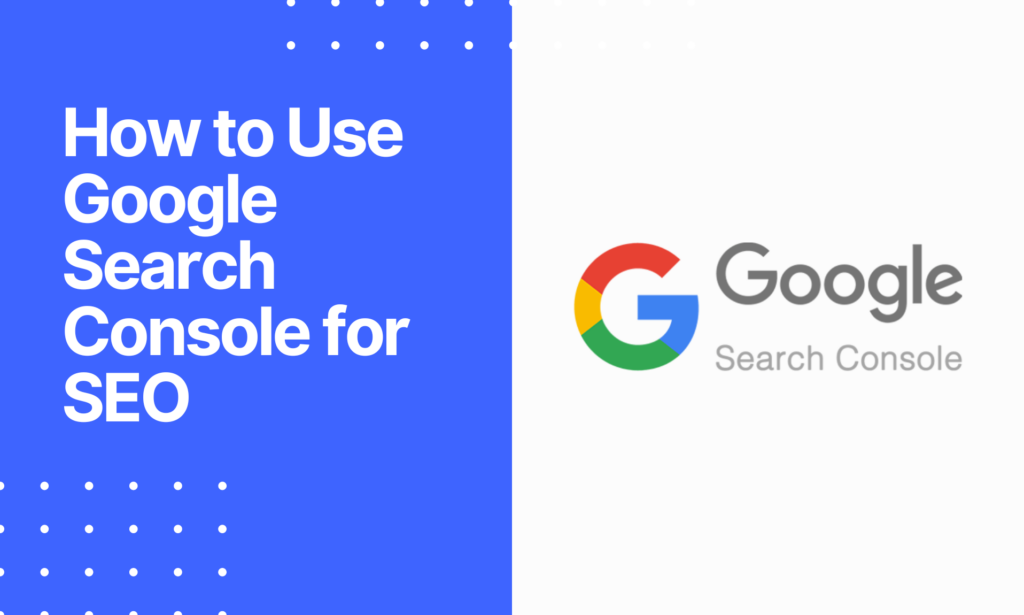
- April 2, 2024
- 19 min read
How to Use Google Search Console for SEO (+20 SEO Tips)
Ranktracker Review: Is it a Top Ranking SERP Tracker?
I’m an SEO Consultant passionate about SEO tools and how SEO can drive large amounts of traffic that drives conversions.
I started as a programmer and found the technical aspect of SEO super interesting. I then transitioned fully, working with all aspects of SEO, and that’s where I am today.
If you want to learn more, then check out my YouTube channel , where I review new and upcoming SEO tools and share SEO tips.
Read how I review SEO tools.
Follow me —
Let’s talk SEO
[email protected] +45 27627158
Ved Stigbordene 41, 3 th 2450 Copenhagen SV Denmark
Sign up for my SEO newsletter
Join 800+ other website owners and get an SEO video and an actionable SEO tip every week.
Privacy Policy | Cookie Policy | Sitemap | Disclaimer | Terms and Conditions
Download the blog post as a PDF
I’ve made all my blog posts as PDFs so you can easily download them and read them later or share them with a colleague or friend.
GET MY 25-STEP ON-PAGE SEO OPTIMIZATION checklist
🎉🎉 WIN A WEBSITE REVIEW FOR YOUR WEBSITE 🎉 🎉
Before you go, do you want more SEO tips?
I have an SEO-focused newsletter I send twice weekly with an SEO tool review and an actionable SEO tip you can implement in less than 5 minutes.

SEO Content Writing Tips (22 Best Practices & Guidelines)
This guide includes a list of SEO content writing tips.
Below, you’ll find the best SEO writing tips and techniques you can use to better optimize your articles for search engines like Google, Yahoo, and Bing. As a result of following these SEO content writing guidelines, you should experience higher keyword rankings and organic search traffic for your website.
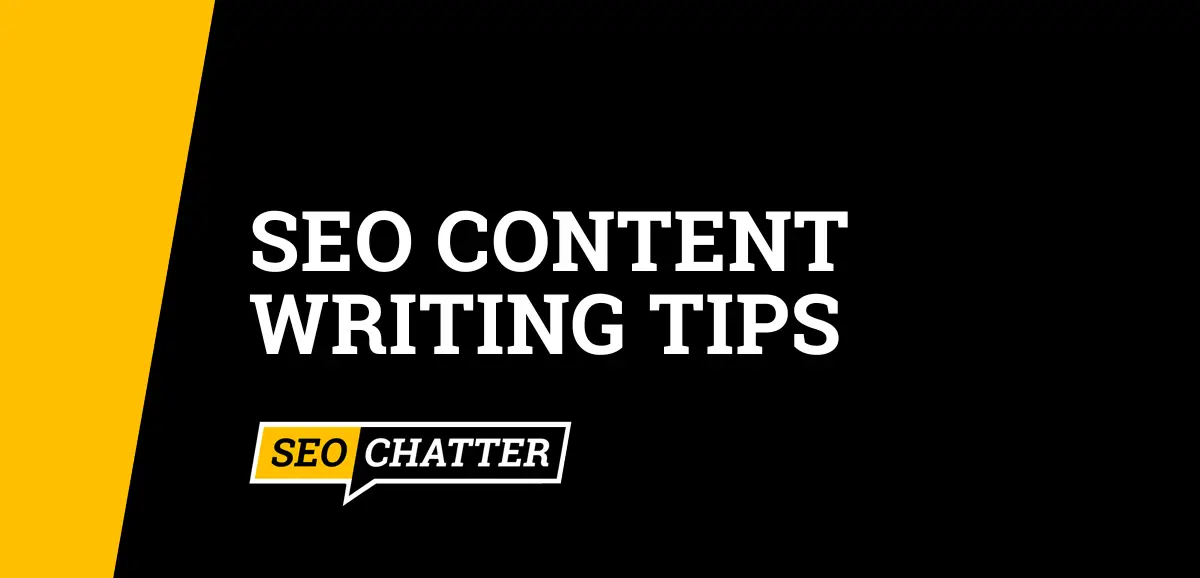
Table of Contents
SEO Content Writing Tips
1. write helpful seo content for humans, not search engines.
If you only follow one of these best practices for SEO content writing, this one should be it. And with each subsequent Google algorithm update, writing content for humans, not search engines, is becoming vastly more important for SEO.
Focusing all your efforts on achieving keyword rankings without regard to your actual users will often create the opposite result as Google prioritizes helpful, people-first content in search results .
In the screenshot below, you’ll see the search giant’s official explanation of what “people-first content” actually means:
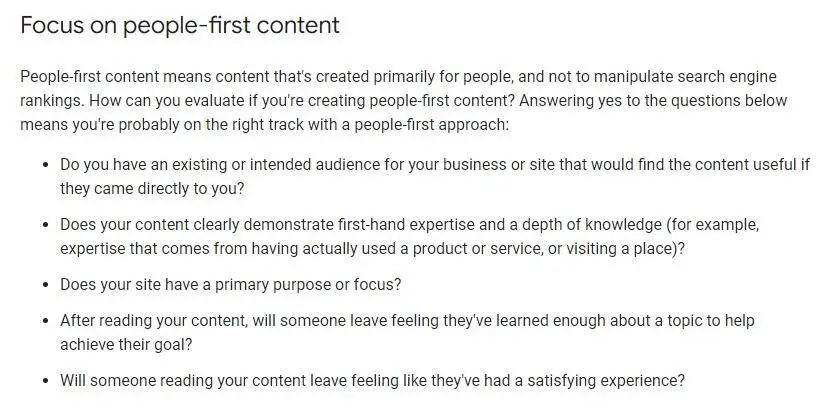
Here are two more tips for writing helpful, human-first content.
- Become Your Audience: Put yourself in the mindset of your target reader. What would you want to know? What would make the biggest difference in terms of finding the information you need? Then, focus your SEO content on satisfying those needs.
- Engage and Empathize: Basing your content on personal experiences not only helps to satisfy Google’s E-E-A-T requirements (more on this later) but also shows readers that you empathize with their situation, meaning they’re more likely to trust you to help them.
2. Focus Your Writing On 2-3 Keywords
Keywords are the foundation of SEO content writing, sending signals to search engines and search users about the subject of your content.
To use them effectively, focus on one primary keyword and two closely related secondary or supporting keywords. That way, your content is tightly focused on that cluster of keywords, which, ultimately, helps your web page rank higher for all of those terms and their variations.
3. Make Sure the Content Meets User Search Intent
Matching the user’s search intent should be a pivotal component of your SEO content strategy. This SEO writing tip means understanding the underlying motivation or purpose behind a specific search query. This critical factor will influence the type of content you create and how you create it.
For example, suppose your audience is looking for practical instructions on how to mow a lawn, which would include step-by-step instructions. In that case, you’d naturally create different content than if your readers wanted to research the best lawnmower to purchase, which would include a list of products along with your personal review of each one.

Consider the following best practices to ensure your content meets users’ search intent:
- Use SEO Tools: Platforms like Semrush allow you to check a specific keyword’s main search intent category (e.g., informational, navigational, transactional, and commercial). Use this to get a basic understanding of the type of content you’ll need to create so you match user search intent for SEO.
- Analyze Top Search Results: Run a Google search for your target keywords and check out the top-ranking results. These are the pages Google feels best to meet the user intent, making them invaluable for determining the most effective way to create and structure your SEO content.
4. Aim for a Competitive Word Count
Word count is one of the most misunderstood of all SEO writing best practices. Google doesn’t consider word count as a ranking factor but rather how informative and comprehensive the content is. See the image below for the official Google documentation on this matter.

For example, if you’ve sufficiently answered a search query in 1,000 words, adding an extra 1,000 of superfluous fluff won’t give you any extra benefits. And, in some cases, can dilute the topical relevance of the target keyword; making it harder to rank for that query.
A better strategy for content writing is to examine the length of existing top-ranking content on Google. This will allow you to more accurately determine how long your article needs to be to stand a good chance of a high ranking.
You can run those top-ranking URLs through a tool like Word Counter to get a good idea of how long your content should be to cover the subject and meet user intent fully.

As you can see in the image above, the word count for the example article is around 1,700 words. After conducting competitor analysis, we discovered that an article of that length would be sufficient to rank in the top 10 positions on Google for its target keyword phrase. Writing a 5,000-word guide on the topic was not necessary, and would mostly likely not be worth the extra time or effort for SEO rankings.
5. Keep Paragraphs Short and Concise
Large chunks of text make your content harder to follow and cause unnecessary challenges for users scanning your content to find a key piece of information.
For this reason, you’ll benefit from keeping your paragraphs short and concise. A best practice is to limit your paragraphs to a maximum of two or three sentences. Also, use bullet points when you can to make the content more scannable and digestible for the reader.
6. Optimize the Title Tag for the Top Keywords
Your page’s title tag should be written to send clear signals to search engines and users about the subject and context of your posts. Therefore, you should place your primary keyword at the beginning of your post title to ensure there’s no doubt about the main SEO topic of your content.
From there, incorporate secondary keywords or keyword variations towards the end of your title tag in a natural-sounding way that provides more context about the post’s contents.
For example, we are targeting the following keywords for this SEO writing guide:
- SEO content writing tips
- best practices for SEO content writing
- SEO content writing guidelines
As a result, we created this optimized title tag to cover all of the top keywords and their variations without repeating the same words over and over again (i.e., over-optimization): SEO Content Writing Tips (22 Best Practices & Guidelines)
7. Use Proper Heading Structure
Header tags (H1-H6) improve your page’s user-friendliness by organizing your content into easily-digestible sections. They also help search engine crawlers understand the main topic and subtopics of the content for proper indexing in the SERPs.
Your H1 tag should be the main title of your article, with each of the main topics separated by H2 tags. These H2 sections can then be broken down into subsections using H3 tags. H3 sections can be further divided into subsections with H4 tags, and so forth down the line with H5s under H4s and H6s under H5s.
For example, in a product review, you might have one main H2 section titled, “Key Features”, that you divide into three smaller H3 subsections; one for each feature. See the image below for an example of this SEO content writing tip in practice.
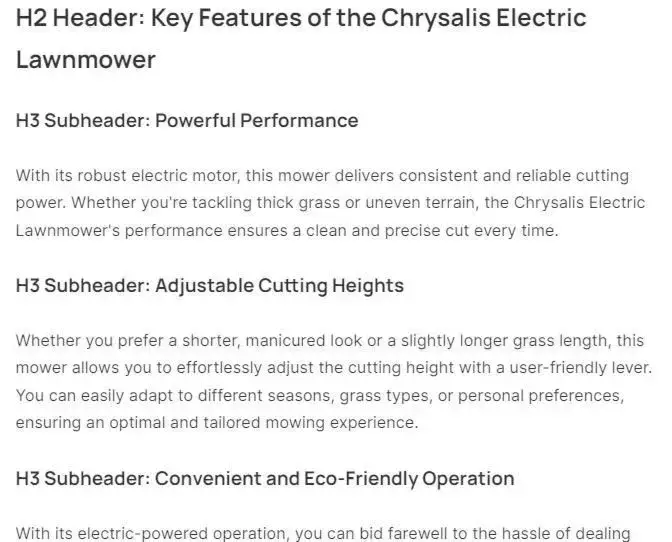
8. Ensure the H1 and Title Tag Are the Same
Your title tag is what users see in search results for your web page listing and ultimately click on to access your content. Therefore, it’s essential that your H1 tag matches your title tag, as this helps users feel confident that they’ve landed in the right place.
As a result of following this SEO writing tip, your users are more likely to stay on your page rather than hit the back button, which will negatively impact your bounce rates. Also, matching your title tag to the H1 tag improves the keyword relevancy for SEO (and rankings) because these two HTML elements confirm to the search engine crawlers what the target keywords are for on-page SEO.
9. Include Keywords In the H2 Subheadings
H2 tags give further signals to search engines about the topics covered within your content. To improve your chance of ranking well in the SERPs, it pays to ensure each H2 subheading incorporates one of your primary or secondary keywords.
In our experience, we’ve found that the best practice to follow for SEO content writing looks something like this:
- Primary Keyword: Include it in the first and last H2 subheadings on the page.
- Secondary Keywords: Include each supporting keyword one time in their own H2 tags on the page.
- Keyword Variations: If you’ve already used your primary and secondary keywords as above, include keyword variations in any remaining H2s. (If appropriate and natural.)
10. Boost Topical Relevance With H3 Subheadings
Topical relevance is a term used to describe how much the content aligns with and covers a specific topic comprehensively.
One way to boost your topical relevance is to incorporate any keyword variations you still need to use on the page into your H3 tags as well as any relevant semantic keywords. Together, this improves topical relevance for SEO rankings.
However, as with all keyword placements, what matters most here isn’t the keywords themselves but that they fit into your H3s in a way that has a natural flow for the reader.
11. Put Your Top Keywords In the Introduction
Your introduction is one of the first on-page elements search crawlers use to learn about your content. It’s also your last opportunity to convince your users to stick around by making it clear that you have what they’re looking for.
With that in mind, aim to add your primary keyword within the first 100 words of your post. Ideally, this should be within the first sentence or the first paragraph.
As you continue writing, seamlessly weave in supporting keywords throughout the introduction, further strengthening your message to readers that your content aligns with their search intent and improving keyword prominence for SEO.
12. Repeat All Keywords In the Body Content
Adding keywords in the body content is one of the easiest SEO writing techniques to get wrong.
Although you’ll benefit from repeating both your primary, secondary, and variation keyword types throughout your content, it pays to exercise caution, adding each keyword only when it fits seamlessly within the context of its surrounding paragraph.
As explained in our other post on how many keywords per page for SEO , the number of times you use a keyword in the body text depends on the length of the content.
For example, a 500-word blog post can easily be optimized for two or three keywords, but trying to fit five or six keywords into a short article like that will likely sound unnatural. However, focusing on five or six keywords in a 2,000-word blog post is a common practice and you can spread out the usage of those phrases so the content sounds natural.
A good rule of thumb for SEO content writing is to use 1-2 keywords for every 100 words of text. This results in a keyword density of around 1-2% which is considered to be a good percentage for on-page SEO without keyword stuffing.
13. Add Keywords to the Summary
Adding your primary and secondary keywords to the summary (or conclusion) of your article doesn’t just provide a sense of coherence and clarity for readers, it also plays a significant role in strengthening your topical relevance for SEO keywords.
Once you reach this stage of your post, a good SEO writing technique is to include your top three keywords one time each within the last 100 words on the page.
14. Include Long-Tail Keywords & Relevant Entities for Semantic SEO
Long-tail keywords are specific phrases and questions that target longer search queries (e.g., four or more words). Relevant entities, on the other hand, are mentions of people, places, or other specific terms relating to your subject.
Including both together on the page helps search engines understand the context and semantic meaning of your content in a way that can positively impact your keyword rankings.
This SEO writing guideline also helps you establish your expertise and authority on your chosen topic because you’re improving the overall semantic relevance and knowledge on the subject matter.
15. Optimize the Content for Featured Snippets
Featured Snippets are stand-out search results that feature prominently above regular, organic search listings, typically providing a short answer to a specific question.
Featured Snippets provide the benefits of enhanced website credibility and improved organic search visibility, which can increase your click-through rates.
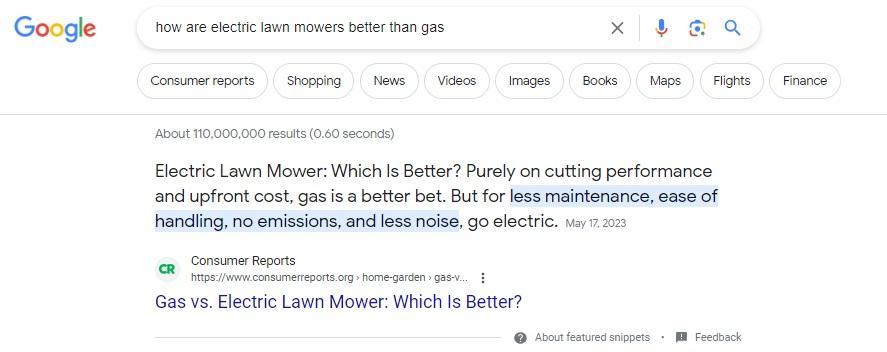
To earn these snippets, optimize your content by using an exact match keyword you want to target in an H2 subheading that is high up on the page. Underneath that heading, directly answer the question in 45-50 words, which is the most common snippet length.
Follow this SEO writing tip for as many relevant keywords that apply to the page and display a Featured Snippet. You can uncover more ideas by doing a Google search for your target keywords and copying the questions that appear inside the People Also Ask box. Put those questions in their own H2 tags followed by a short and concise answer.
16. Include E-E-A-T Signals
E-E-A-T stands for Experience, Expertise, Authoritativeness, and Trustworthiness, all of which are factors that Google’s human Quality Raters look for in content when evaluating search results.
The best ways to showcase these E-E-A-T factors for SEO writing include:
- Include an author byline with a link to the author’s bio page.
- Include an author bio box (optional; and a good substitute if a byline is not present).
- Include the published date and time (time is optional for evergreen content but essential for news-related content)
- Demonstrate expert knowledge and/or first-hand experience on the subject by sharing in-depth information, personal opinions, original photos, and self-produced videos.
- Referencing relevant credentials, qualifications, or industry affiliations.
- Make sure all information is accurate and up to date.
- Include 1-2 unique elements (minimum) not found in the top-ranking URLs (e.g., tables, charts, infographics, videos, more list items, industry expert quotes, FAQs).
For more tips like these visit our on-page SEO checklist which lists all of the top factors to focus on for on-page optimization signals.
17. Include At Least 3-5 Internal Links
These next two SEO content writing tips encompass other essential elements of on-page search engine optimization beyond the words on the page.
Internal links can enhance website navigation, improve user experience, and help spread link equity throughout your site, but only if you stick to the following recommended SEO content writing guidelines:
- Use no more than 3-5 internal links per post to prevent diluting link equity.
- Ensure links are highly relevant to the subject and provide additional value to your readers.
- Place links strategically within your content, using relevant anchor text in a way that fits naturally within the surrounding content.
18. Link Out to High-Quality Sites
External linking to reputable sources can significantly elevate your credibility, creating subtle associations between your site and respected, high-authority publications within your niche.
Use external links to provide evidence of your claims, provide greater context, or add value to your content by giving readers additional tools and information.
To make the most of external links in SEO writing:
- Link to sources with high Domain Authority (DA) and/or high Page Authority (PA) scores.
- Ensure links fit naturally within your content using relevant anchor text.
- Set links to open in a new tab or window to prevent users from leaving your page.
19. Add Keyword-Optimized Images
Images are crucial for breaking up large pages of text, making it easier to read, and illustrating specific key points. Images can also be optimized to improve the on-page SEO relevancy for your target keywords.
Additionally, some articles will require more images than others. For example, a page targeting “bathroom vanity ideas” would be image heavy because users want to see pictures of bathroom vanities to get a better idea of which style to use during a home renovation.
To achieve the most SEO gains from your images, ensure that the file name, ALT text, and captions are all optimized for your highest-priority keywords. Focus on one keyword per image while making sure it fits naturally with the picture.
20. Write a Compelling & Optimized Meta Description
Meta descriptions (the short blurbs beneath search listings that describe the content) are another good area to focus on for SEO content writing.

A good meta description includes your primary keyword and at least one secondary keyword (in that order). Google, for example, will bold those keywords when they match the user’s search query, which can improve click-through rates.
21. Write an SEO-Friendly URL
An SEO-friendly URL provides clear information about the content of the page. It also improves the chances of ranking higher in search results as it is one of the top-ranking factors for on-page SEO.
Many SEO experts agree that the URL is the third most important factor for SEO content writing. The other two factors are the title tag and the H1 heading.
A good SEO writing best practice is to keep your URL short (under 60 characters) and include your primary keyword as an exact match keyword phrase. For example, the URL for this guide is simply, /seo-content-writing-tips/ .
22. Add Relevant Schema Markup to the Content
The last of our SEO writing techniques involves using specific tags known as Schema Markup to help search engines learn more about the most appropriate search terms to rank your content for.

You can generate these tags easily without needing to know much technical SEO using any one of these free Schema Markup generators.
Learn More About SEO Content Writing
The links below explain more about SEO content writing. Use these resources to expand your knowledge on the subject.
- What Is SEO Writing?
- What Is SEO Content?
- SEO Content Writing Checklist
- SEO Checklist for Blog Posts
- SEO Writing for Beginners
- How to Write SEO Friendly Content
SEO Content Writing Tips & Guidelines Summary
We hope you enjoyed this list of SEO content writing tips.
As you discovered, these SEO writing tips and techniques allow you to better optimize your articles for search engines like Google, Yahoo, and Bing. The more you can incorporate these SEO content writing guidelines into your publishing process, the higher keyword rankings and organic search traffic you can achieve for your website.

The Editorial Staff at SEO Chatter is a team of search engine optimization and digital marketing experts led by Stephen Hockman with more than 15 years of experience in search engine marketing. We publish guides on the fundamentals of SEO for beginner marketers.
SEO Content Writing Guide for Beginners with QnA
April 9, 2023

Are you a beginner in the world of content writing and struggling to understand how to optimize your content for search engines?
Have you ever published an article or blog post but failed to get the traction you were expecting?
Don't worry; you're not alone!
Many beginners face challenges regarding SEO content writing, and it can be overwhelming to know where to start.
In this blog, we'll address the ten most common questions beginners have about SEO content writing and provide practical tips to help you get started.
We'll cover everything from understanding the basics of search engine optimization to how to conduct keyword research and tips for writing compelling and engaging content that both your readers and search engines will love.
Whether you're a blogger, content marketer, or just getting started with writing online, this guide will provide you with the information you need to take your content to the next level.
So, let's dive in and start with our top 10 common questions about SEO content writing for beginners.
1. What is SEO Content Writing?
SEO content writing is creating content optimized to rank well in search engine results pages (SERPs).
It involves using keywords in strategic locations throughout the content, optimizing meta descriptions and title tags, and ensuring that the content is high-quality and engaging for readers.
In addition to optimizing content for search engines, SEO content writing also involves understanding the target audience and creating content that meets their needs and interests.
This can include researching the topics that are most relevant to the audience, using language and tone that resonates with them, and providing valuable information or insights that they are likely to find useful.
Effective SEO content writing requires a balance between optimizing for search engines and creating valuable and engaging content for human readers.
2. Why is SEO Content Writing Important?
SEO content writing is essential because it helps websites rank higher in SERPs, driving more organic traffic to the site. This can lead to increased brand awareness, more leads and conversions, and ultimately, more revenue for the business.
In addition, SEO content writing can also improve the user experience on a website, making it more engaging and easier to navigate.
By creating high-quality, informative content optimized for search engines, businesses can establish themselves as thought leaders in their industry and build trust with their audience.
Moreover, SEO content writing is an ongoing process that requires regular updates and maintenance, which can help businesses stay relevant and competitive in today's digital marketplace.
With so much online competition, a strong SEO strategy is essential for any business looking to succeed in the long term.
3. What are Keywords, and How Do You Use Them in SEO Content Writing?
Keywords are the words and phrases that users type into search engines when looking for information.
In SEO content writing, keyword research identifies the keywords most relevant to your business and incorporates them strategically into your content.
The goal of keyword research is to increase your website's visibility and rank higher in search engine results pages (SERPs). By understanding what keywords your target audience is searching for, you can optimize your content accordingly and drive more traffic to your website.
However, it's important to note that keyword stuffing or overusing keywords to manipulate search rankings can harm your SEO efforts. Instead, focus on creating high-quality, valuable content that naturally incorporates relevant keywords.
Additionally, regularly updating and refreshing your content with new keywords can help keep your website ranking high and attracting new visitors.
4. What Are Meta Descriptions, and How Do You Use Them in SEO Content Writing?
Meta descriptions are the snippets of text that appear below the title tag on SERPs. They provide a summary of the content on the page and can impact click-through rates.
In SEO content writing, it's essential to create unique and compelling meta descriptions that accurately reflect the content on the page.
Meta descriptions are also an excellent opportunity to entice users to click through to your website by highlighting the unique value proposition of your content.
To make the most of your meta descriptions, keep them between 150-160 characters and include relevant keywords that match the searcher's intent.
Also, avoid using duplicate meta descriptions across multiple pages, which can confuse search engines and users. Remember, a well-crafted meta description can make all the difference in attracting visitors to your site!
5. What is the Ideal Length for an SEO Content Piece?
There is no definitive answer to the ideal length for an SEO content piece, as it can vary depending on the topic and the audience. However, studies have shown that longer content tends to perform better in SERPs and can provide more value to readers.
When writing SEO content, it is essential to remember that the piece's length should not be the only factor considered.
Quality and relevance of the content are equally important and can significantly impact how well the content performs in search engine rankings. It is also essential to consider the user experience, as readers are more likely to engage with content that is easy to read and provides valuable insights.
Therefore, writers should aim to strike a balance between length, quality, relevance, and user experience to create effective SEO content.
6. How Do You Conduct Keyword Research for SEO Content Writing?
Keyword research involves identifying the keywords most relevant to your business and audience.
Several tools can help you conduct keyword research, including Google Keyword Planner and SEMrush .
Choosing keywords with high search volume and low competition is essential.
Once you have identified the keywords most relevant to your business and audience, it's essential to incorporate them into your website content, blog posts, social media profiles, and other digital marketing efforts. This will help improve your search engine rankings and drive more traffic to your website.
However, using keywords naturally and organically is essential rather than stuffing them into your content unnaturally.
Remember also to consider long-tail keywords, which are longer and more specific phrases that can be easier to rank for and often have higher conversion rates.
7. Can Duplicate Content Hurt Your SEO Efforts?
Yes, duplicate content can hurt your SEO efforts.
Search engines prefer unique and original content, so if you have duplicate content on your site or across multiple sites, it can impact your rankings in SERPs.
In addition, having duplicate content can confuse search engines as they may not know which version of the content to index or display in search results. This can lead to lower visibility for your website and ultimately impact your organic traffic.
It's important to regularly audit your content, identify any instances of duplication, and take steps to remove or consolidate them.
By creating fresh and original content, you can improve your chances of ranking higher in search engine results pages and attracting more visitors to your site.
8. How Do You Optimize Images for SEO?
There are several ways to optimize images for SEO, including using descriptive file names and alt tags, compressing images for faster load times, and ensuring that images are relevant to the content on the page.
Another effective way to optimize images for SEO is by using the correct file format.
JPEG is the most commonly used image format and is ideal for photographs or images with many colors. On the other hand, PNG is best for images with fewer colors and transparency, while SVG is great for vector graphics such as logos and icons.
Choosing the correct file format can improve your website's load time and enhance the user experience, leading to better search engine rankings.
9. How Do You Track Results for SEO Content Writing?
Tracking results for SEO content writing involves measuring key metrics such as organic traffic, keyword rankings, and conversion rates.
There are several tools available that can help you track these metrics, including Google Analytics and Ahrefs.
Google Analytics is a free tool that provides insights into your website's traffic and user behavior. You can use Google Analytics to track the number of visitors to your website, the pages they visit, how long they stay on your site, and where they come from. This information can help you optimize your content for better user engagement and improve your website's overall performance.
Ahrefs, on the other hand, is a paid tool specializing in SEO analysis. It provides detailed data on your website's backlinks, keyword rankings, and competitor research. With Ahrefs, you can monitor your website's SEO performance and identify areas for improvement.
Both tools are essential for tracking your SEO content writing results and improving your website's search engine visibility.
10. How Often Should You Update Your SEO Content?
There's no set rule for how often you should update your SEO content, but it's a good idea to regularly review and refresh your content to ensure that it's up-to-date and relevant to your audience. This can help improve your rankings in SERPs and drive more organic traffic to your site.
One effective way to keep your content fresh is to conduct keyword research periodically. This will help you identify new keywords and topics relevant to your audience and industry.
Additionally, consider updating your existing content with new statistics, insights, and examples to make it more informative and engaging.
Another strategy is to incorporate multimedia elements like images, videos, and infographics to make your content more visually appealing and shareable. This can not only help improve your SEO but also increase engagement and social shares.
Remember that SEO is an ongoing process, and regularly updating and optimizing your content is crucial for staying ahead of the competition and maintaining your online visibility.
SEO content writing can seem daunting at first, but it's crucial to understand if you want to succeed in the digital world. By addressing these ten common questions about SEO content writing for beginners , we've provided you with practical tips and strategies to help you create compelling and optimized content that both your readers and search engines will love.
However, we understand that SEO content writing can be time-consuming, so we want to introduce you to LongShot AI , a powerful tool that can help you create high-quality content in a fraction of the time.
LongShot AI uses advanced algorithms and machine learning to generate unique, SEO-optimized content for your website or blog. It's the perfect tool for beginners who are just starting with SEO content writing or for anyone who wants to take their content to the next level.
So, what are you waiting for?
Give LongShot AI a try today and see the difference it can make in your content creation process.
Latest posts
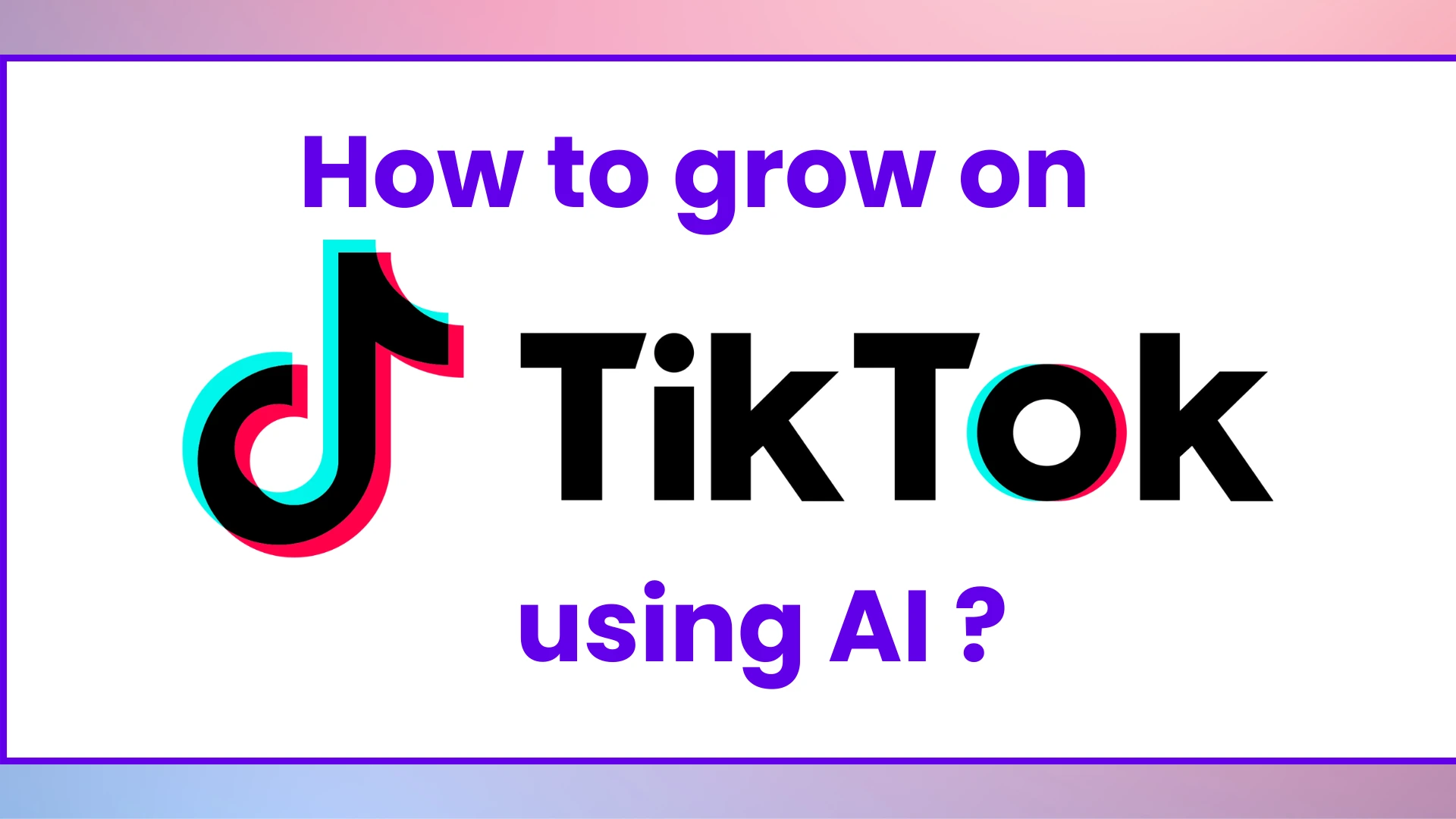
Revolutionize Your TikTok Content with AI

Accelerate Instagram Growth Using AI

Transform Strategy with AI-Generated YouTube Ideas & Scripts

Ultimate Content Writing Guide: How to Write for Online Readers
- Samuel Edwards
- February 12, 2021
It doesn’t matter what industry you’re in, who your customer is, or what type of marketing strategy you’re running, you need content.
In fact, it’s impossible to build a competitive brand that effectively engages customers without content.
The only question is, do you know how to create quality content that moves the needle for your brand?
Table of Contents
Why Content Writing?
Content can take on any number of shapes, sizes, and mediums. And while video, graphics, and even audio (such as a podcast) qualify as content, we’re specifically looking at content writing in this guide (along with our other ultimate guides ).
Content writing refers to the creation of content that’s developed for the expressed intent of connecting with an audience, engaging them, and pushing them further down the sales funnel until they become customers.
Some content writing is salesly in nature – like direct-response style copywriting – while other content writing is much more organic (like a blog post).
Either way, content writing (especially when starting a new blog ) plays a key role in helping your brand communicate ideas, build trust, and connect with your target audience.
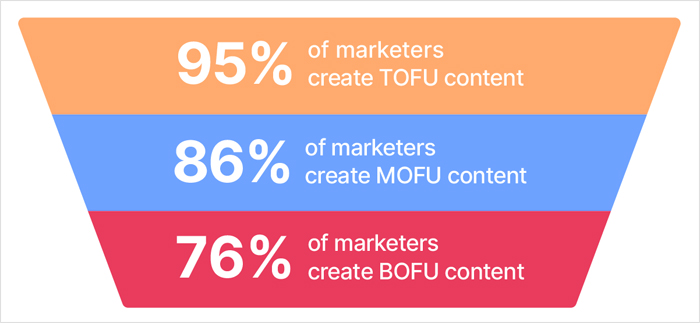
Research shows that 87 percent of marketers currently use content as a key piece in the buyer’s journey. Here are a few other curated data points that emphasize the importance of developing quality content:
- 72 percent of marketers believe content marketing increases engagement.
- 72 percent of marketers believe content marketing brings in more leads.
- 69 percent of consumers say they’ve purchased something because of a tweet.
- 94 percent of people plan to make a purchase from a business they follow on social.
- 95 percent of internet users only look at the first page of Google search results.
- Blog content creation is a top priority for 53 percent of marketers.
- 79 percent of B2B buyers share case studies with colleagues.
- Email marketing generates $40 of value for every $1 spent.
We could rattle off dozens of data points like this for every single content medium, but hopefully this sampling of statistics gives you an idea of just how important good written content is to your brand.
Types of Content Writing
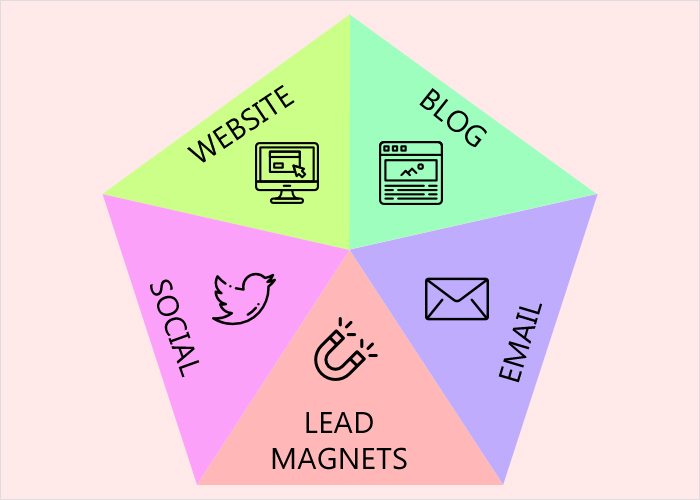
Content writing takes on any number of shapes and forms. And while your brand certainly doesn’t have to tackle every single type of content, it’s smart to at least be familiar with what’s out there. Here are some of the most common:
- Website. Every website has “static” copy that rests on its website for months or years at a time. Whether it’s your home page, about us page, or a service page, this copy brings your website to life and relays your message to visitors.
- Blog. If website copy is “static,” blog content is best described as “dynamic.” In other words, you’re constantly adding new and fresh blog content over time. And while older evergreen posts can certainly still add value, you’re constantly producing more in an effort to keep your audience engaged.
- Social. Most people are going to spend a ton of time on your website. But do you know where they are spending time? Social networking platforms like Facebook, Twitter, Instagram, etc. By including social in your content marketing strategy, you can connect with your audience in profound ways and dial up engagement a notch or two.
- Lead magnets. If you’re serious about creating a marketing funnel that moves people from awareness to action, you need some grease to help them slide down. Lead magnets are an excellent way to engage a prospect with a free offer and simultaneously add them to your email list. Lead magnets include things like ebooks, PDF downloads, white papers, etc.
- Email. Speaking of email lists, email is a highly effective content investment. As mentioned previously, research reveals that for every $1 a company spends on email, they generate an average of $40 in return. Not bad!
Quality is far more important than quantity. While there are large brands that are able to excel with each of these elements, they typically have entire teams dedicated to each medium. If you’re running a small business or solo practice, you won’t have those same internal resources available. In light of this, pick just one or two of these and go hard after them.
Content Writing Prep Work

Before you can actually go all-in on content writing, you need to do some prep work to ensure you have a strong foundation in place. Here are a few steps we recommend completing in advance:
- Target audience personas. Your content isn’t about you – it’s about your reader. Unfortunately, this is a concept that many brands don’t get. As a result, their content falls on deaf ears. If you want to develop content that moves people to action, it starts with clarifying who your target readers are and distilling these details into vivid personas that can be leveraged to develop crisp and engaging content.
- Value proposition. What makes your brand different? What is it that your brand is focused on above all else? What’s your mission and driving motivation? You must have a clear value proposition in order to develop authentic content that hits the mark.
- Style guide. Armed with audience personas and a clear value proposition, you’ll create a style guide that clarifies what your content will look like, how it’s written, and what your voice is. A good style guide includes elements like editorial standards (including grammar and punctuation), stylistic elements (colors and typography), tone of voice, etc.
- Content calendar. Finally, you need a plan of action. A content calendar is an excellent resource for planning out your content ahead of time so that you know precisely when content is being created, published, and shared. If this is your first time implementing a content strategy, avoid planning too far out. Start with one to three months and see how things go. Once you get into a groove, you plan farther ahead.
- Content Gap . Perform a content gap analysis to figure out where you are deficient compared to your competition and put a plan in place to bridge the content gap.
Most brands skip these all-important steps. (But then again, most companies have paper-thin content strategies that add little-to-no tangible value to their brands.) If you want your content strategy to generate a positive return on investment, take the prep work seriously.
Content Writing Tips and Tricks
With the proper foundation in place, you’re ready to write content. Here are some useful tips and techniques for effective content writing for each major content medium:
Website Copy Content Writing Tips
- Remember that website copy has a longer shelf life than almost any other content medium. Try sticking to evergreen topics and statements that will remain true indefinitely. (Unless you plan on regularly updating your website copy.)
- Avoid massive blocks of chunky text. Big paragraphs are a huge turn-off to readers. Try synthesizing your biggest value points and beliefs into punchy, salient points.
- Your website copy isn’t about you. It’s about the audience. Stop positioning yourself as their savior and make them the hero of their own story. You’re simply the guide who is there to help them along.
- While you should always write with the reader in mind, you can’t ignore the power of SEO . Perform keyword research and naturally integrate long-tail keywords into your pages to help Google understand what you’re all about.
Blog Posts Content Writing Tips
- Your headline is your sales pitch. If you don’t have a compelling headline, nobody will read your blog post. Learn how to write compelling headlines and you’ll see your traffic and conversions skyrocket. Good headlines use emotional language, evoke curiosity, and speak directly to your target reader.
- Break up your text! The days of long paragraphs are done. Attention spans are shorter than ever before, and it’s up to you to keep people engaged. You do this by using short paragraphs, subheadings, line breaks, bullet points, lists, and graphics.
- Every blog post should have a clear call-to-action. However, it’s important that you stick to just one. The human brain is easily distracted. If you ask someone to do more than one thing, you risk having them do nothing. It’s okay to include the same CTA multiple times in a post, but keep it focused!
Social Media Content Writing Tips
- The biggest mistake brands make with social media is treating it as a one-way street. They imagine they’re standing on a pedestal with a megaphone and thousands of people are waiting to hear what they have to say. But in reality, social media is like a crowded conference room. You have to engage in conversation, mingle, and build trust before expecting people to care about what you have to say.
- It’s okay to let your guard down a notch or two on social media, but avoid getting lazy. Far too many brands have crossed the line because of a lack of conscientiousness. It’s always good to have at least two people reviewing social media posts before they go out.
- Quality is better than quantity . It’s better to have one high-quality post per week – meaning lots of engagement and interaction – than a dozen posts that get no traction.
Lead Magnets Content Writing Tips
- A good lead magnet is something that people perceive as being valuable. And while the goal is to get them to take the lead, it doesn’t stop there. If you fail to deliver value after they opt-in, they’ll never turn into a loyal follower or customer. Give away your best stuff! (They’ll come back for more.)
- When developing lead magnet content, you must be strategic with your CTAs . Remember, the lead magnet was free! It’s now your job to monetize the prospect. Add value. And then when you think you’ve added enough value, add a little more.
Email Content Writing Tips
- Email can be the most effective content medium. But it’s also the one that takes the most work and effort to perfect. To develop effective copy, you have to make it personal. Write in the second person, address recipients by their name, and don’t generalize.
- Getting someone to open an email is 75 percent of the battle. This makes the subject line the most important part of the email. You have to evoke enough curiosity to get someone to open the email. But it’s equally important that you follow through on whatever you say in the subject line. If you make a promise or tease a particular point, it must be discussed in the body of the email – otherwise you lose trust.
- The purpose of the subject line is to get the reader to open the email. The purpose of the first line of the email is to get the person to read the second line. The purpose of the second line is to get the individual to read the third line, etc. In other words, don’t save your best stuff for last. Lead with it!
Where to Find Content Writers
Knowing content is important and understanding what good content looks like is just the start. At the end of the day, it comes down to execution. This means actually writing the content. Here are a few sources for hiring good content writers :
- Yourself. If you’re a good writer and have more time than money, perhaps you could write your own copy. There’s absolutely nothing wrong with this approach. (In fact, it’ll help you produce authentic content that perfectly embodies your brand values.) However, this is not a scalable option. You can only write so much content before other areas of your business are neglected.
- In-house. Do you have a marketing team or copywriter on staff? Or maybe you have someone who works on the sales side of things but also happens to be a good writer? Using in-house resources can be cost-effective in some situations. (And you’ll benefit from having writers who are intimately familiar with your brand’s story and values.)
- Freelancer. Working with freelance writers is one of the most popular options. You can find freelance writers on LinkedIn, Upwork, Fiverr, or through your own personal and professional networks.
- Content partner. While freelance writers are easily accessible and cost-effective, they aren’t always scalable. Every time your content needs increase, you have to go out and find a good copywriter. And this can be a time-consuming process. By hiring a content partner – meaning a scalable content agency – you don’t have to worry about capacity. As your needs increase, they’ll be met. Content agencies have stables full of high-quality, pre-vetted content writers who are waiting in the wings. Whether you need one blog post a month or tens of thousands of words a week, you’ll be taken care of.
Content writing is important, but it’s also time-consuming. By understanding your options, you can architect an intentional strategy that empowers you to develop high-quality content without spending time or money you don’t have. The hope is that this article gives you a good starting point to do just that.
Work With SEO.co
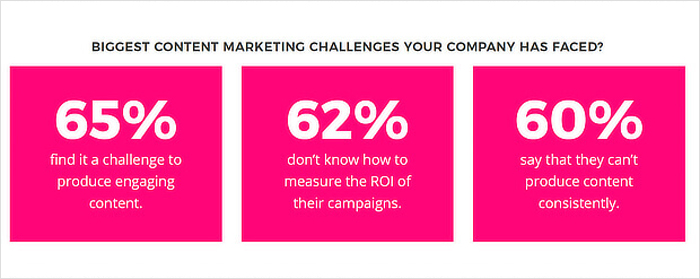
There are any number of ways to find content writers and create quality content. But if you’re looking for the most cost-effective and time-efficient approach to scaling organic traffic , generating high-quality content, and producing high-authority links that establish credibility and ultimately turn visitors into paying customers…well, you’re in the right place!
At SEO.co, we believe in quality over quantity. In other words, we don’t try to be all things to all people. Unlike a lot of agencies that dabble in every single aspect of marketing, we know what we’re good at – and we stick the landing every single time! Our focus is high-quality content creation and stellar SEO link building services .
Join thousands of other successful clients, including small startups and Fortune 500 companies, and find out what SEO.co can do for you! Contact us today for a free site assessment.
- Recent Posts
- 7 Most Important Keyword Metrics to Track in SEO - April 2, 2024
- Niche Edits: A Guide for Niche Edits in SEO Link Building - February 5, 2024
- What is a Link Wheel? Do Link Wheels Still Work for SEO in 2024? - February 1, 2024

- SEO Services
- On-Page SEO
- Content Writing Services
- PPC Management
- Link Building Services
- White Label SEO
- Brand Mentions
- Public Relations
- SEO Audit Service
The SEO Company
- Our Results
- Markets Served
- Locations Served
Email: [email protected] Call: +1 (877) 545-4769 Address: 1425 Broadway Suite 22689, Seattle, WA 98112
Outwrite. Outrank.

- Titan SEO®: Advanced SEO Strategies
- Google & Bing PPC
- Facebook & Instagram Marketing
- LinkedIn Business Marketing
- Amazon Marketing
- Case Studies
- Profit Calculator
- Buyer’s Guide
- Meet Team Titan
Capitalize On Content – 10 Tips & Techniques For SEO Content Writing
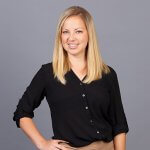
Discover SEO Content Writing Tips & Techniques
Are you a content writer improve your content writing for seo with these 10 tips from titan growth..
It’s no secret that SEO and content go hand-in-hand.
After all, without SEO your content may be lost somewhere on page 50 of the search results; and we all know traffic on those pages is less than satisfactory. Likewise, your first-page ranking can only do so much if your content post-click is crummy. That’s why a good relationship between SEO and great content is essential! Here are 10 tips on how to write SEO content to make your content go further and enhance your SEO efforts at the same time.
SEO Writing Tips & Guidelines to Make Your Content Go Further
1. Write for your audience first
This SEO content writing tip is number one for a reason. It seems easy enough, yet so many companies make content for all the wrong reasons. Write content that appeals to the interests of your target market or answers their questions. Not all posts need to be about your product or service, but they all should be industry related. Assert yourself and your company as an effective expert in your industry by writing SEO-friendly content that is interesting and informative, and do it better than your competition.
2. Keep it all under the same roof
Get the credit and traffic your website deserves by keeping your original content under your own domain name. That means if you have a blog opt out of hosting with WordPress or Blogger and host the blog in a subfolder on your own domain (ie: www.example.com/blog ). Any time you have an opportunity to showcase other forms of original content like videos, infographics or whitepapers, make sure to also embed them onto your website as well and share from there.
3. Make headlines that pack a punch
You have a very short amount of text to make a very big impression. So don’t underestimate the power of an effective headline on SEO! Write headlines that are clear, interesting and make use of rich keywords. In addition to a great headline, also make sure your meta descriptions are interesting and further elaborate on the topic of your article. Keep in mind that your title and meta description are what show up in the search results, so make them count!
4. Use keyword-rich phrases
Use relevant, keyword rich phrases in your headlines as well as throughout your content to let both your readers and the search engines know what your post is about. But beware, too many keywords will not only turn off your readers but can result in search engine penalties for keyword stuffing. Use keywords thoughtfully and sparingly, sticking to a more natural feel. In addition to using keywords throughout the body of your post, take advantage blog tags by tagging a few relevant keywords for each post; most general blogs have tagging capabilities already built in.
5. Structure your posts
The contents of your post may be great but can be easily lost in an unorganized, inefficient format. Breaking your content up into smaller paragraphs with headlines makes for an easy read that will keep your readers engaged. For the search engines, back-end organization is key too. Using proper tag hierarchy when tagging headlines (H1 for titles, H2 for subtitles) is important to maintain a well-structured article.
6. Incorporate imagery
Make your posts pop with images! People are visual. Adding an image along with your blog post can make a big impression. Have a Pinterest account? In addition to promoting your blogs across your other social media channels, posts with images can also be pinned, adding another avenue for traffic to your website.
7. Propel content with social media
Social media is a powerful tool that can help increase the reach of your content and promote sharing. Post each new article on social media sites and in forums, using engaging descriptions and a call-to-action. Since the power of social media lies in sharing, it’s also important to have share buttons on each of your blog posts. If you want more control of how your links appear when they’re shared, implementing Twitter Cards for Twitter or Open Graph for Facebook (technical) can give your shared links a boost, and may help your click-through rates.
8. Implement Google Authorship
Google Authorship is a quick and easy way to tie content to a certain author, all you need is a Google+ account. As a result, your articles come up as rich snippets in the search results featuring the author’s photo along with the article title. Google Authorship is great for personal promotion, but can also increase the click through rate to your articles. If you’re an author, learn how to set up Authorship for your website.
9. Promote natural link building
Link building has come a long way since the days of link buying and link farms, but links are still an important ranking factor for SEO. Linking to your own articles or website in your post ensures a link back to your website if your article is picked up by another site. If you get creative with other types of content like infographics and videos, adding an embed code on your site helps to promote content sharing and also adds a link back to the original source. Creating great SEO content helps increase the shareability and the likelihood that other websites will link to it, so aim for quality!
10. Monitor your activity
Stay on top of your SEO friendly content by monitoring your efforts. Google Analytics is an easy and free way to track your page views and the average time spent on a page. Check things like your bounce rate and time on site to get an idea of how users interact with your website after landing on your content. If you see a high drop off in addition to a low average time spent on the page, that’s an indication that your content wasn’t relevant to what they were looking for, or worse, wasn’t interesting. Also, take a look at the number of social interactions (shares, likes, etc ) to get an idea of the virality of your post. Just looking at these simple metrics can give you a good idea of which content pieces are well-received and liked so that you can replicate that type of content down the road.
Both SEO and content writing are important pieces to the puzzle, so it’s important to use quality techniques for both to ensure higher traffic and engagement on your website. If you have any questions about SEO, content or how they work together, feel free to contact us for more SEO content writing tips!
Submitted by Erica Machin, Titan Growth
More From Titan Growth
5 ways to gain market share during a downturn, marketing spend & recession outcome: the science behind spending your way to success, recession or opportunity.
SEO and Content Marketing: Complete Guide
This guide will show you how to combine content marketing and SEO to get LOTS of traffic.
We used these strategies here at Backlinko to grow our site’s traffic to 288,452 monthly visitors.
Here’s how to combine SEO and content marketing for more traffic.
Create Content Specifically For Backlinks
Are backlinks still important for SEO?
An industry study that we did revealed the fact that backlinks remain a key Google ranking factor .
Question is:
How do you get other sites to link to you?
A lot of so-called “SEO experts” will tell you that all you need to do is publish high-quality content.
And while high-quality content is a start, it’s not enough.
WordPress reports that 2.3 million new blog posts get published every day .
2.3 million!
Which means that “high-quality content” isn’t enough to stand out, get noticed (and most important of all) get linked to.
Instead, you need to create content specifically engineered to get links.
In fact, I recently teamed up with BuzzSumo to analyze 900M articles .

And we found that certain TYPES of content tends to get linked to more often than others.
We also found that, in general, longer content tends to get significantly more backlinks than short posts.
The takeaway here is that, if you’re serious about getting backlinks, then you need to publish super high-quality, long-form content. Ideally, content that’s in the form of an infographic, a what post, or a why post.
As it turns out, there’s another category of content that’s PERFECT for getting links: industry studies and surveys .
Studies are great because you give bloggers and journalists what they crave: data that they can cite in their articles.
For example, check out this voice search study we did about a year ago.

Compared to a list post, this post was A LOT of work to put together. But considering that this post has picked up 1,500 backlinks so far, I’d say it was well worth it:

Optimize Around New Keywords
If you’ve been in the SEO game for a while, you’ve probably noticed the same thing I have:
Google’s first page is more competitive than ever before.
For example, take a keyword like “SEO tips”. According to Ahrefs, that keyword gets 3.5k searches per month. With a CPC of $7.

Not a bad keyword. But not amazing either.
Well, here’s the kicker:
That keyword has a Keyword Difficulty score of 60!

I’m seeing this kind of thing more and more.
Every company on the planet is starting to invest in SEO and content marketing. Which means that every single keyword now has some level of competition (even long-tail keywords ).
What’s the solution? Focus on new, trending keywords .
The best tool for finding new keywords is Google Trends .

This tool will show you whether or not search demand for that keyword is growing.

If you see a keyword on the rise, it’s probably worth creating a piece of content around that keyword. Even if the search volume isn’t great today, it’s only going to go up over time.
Strategically Promote Your Content
Here’s the truth:
If you want your content to rank, you need to promote it.
And yes, “promote it” does include sharing your content on social media.
But for your content to get maximum reach, you also want to promote your content using email outreach.
According to a recent industry study , these types of outreach emails tend to have the highest rates of success:
Use personalized subject lines
Personalize the body of their message
Use an email signature that links to social media profiles
Are part of a follow-up sequence
Optimize Content For Search Intent
Creating high-quality content is important.
But for your content to rank for specific keywords, your content also needs to be a 1:1 match for that keyword’s Search Intent .
I’ll explain what I mean with an example.
When I first started Backlinko I published an article optimized around the term: “backlinks”
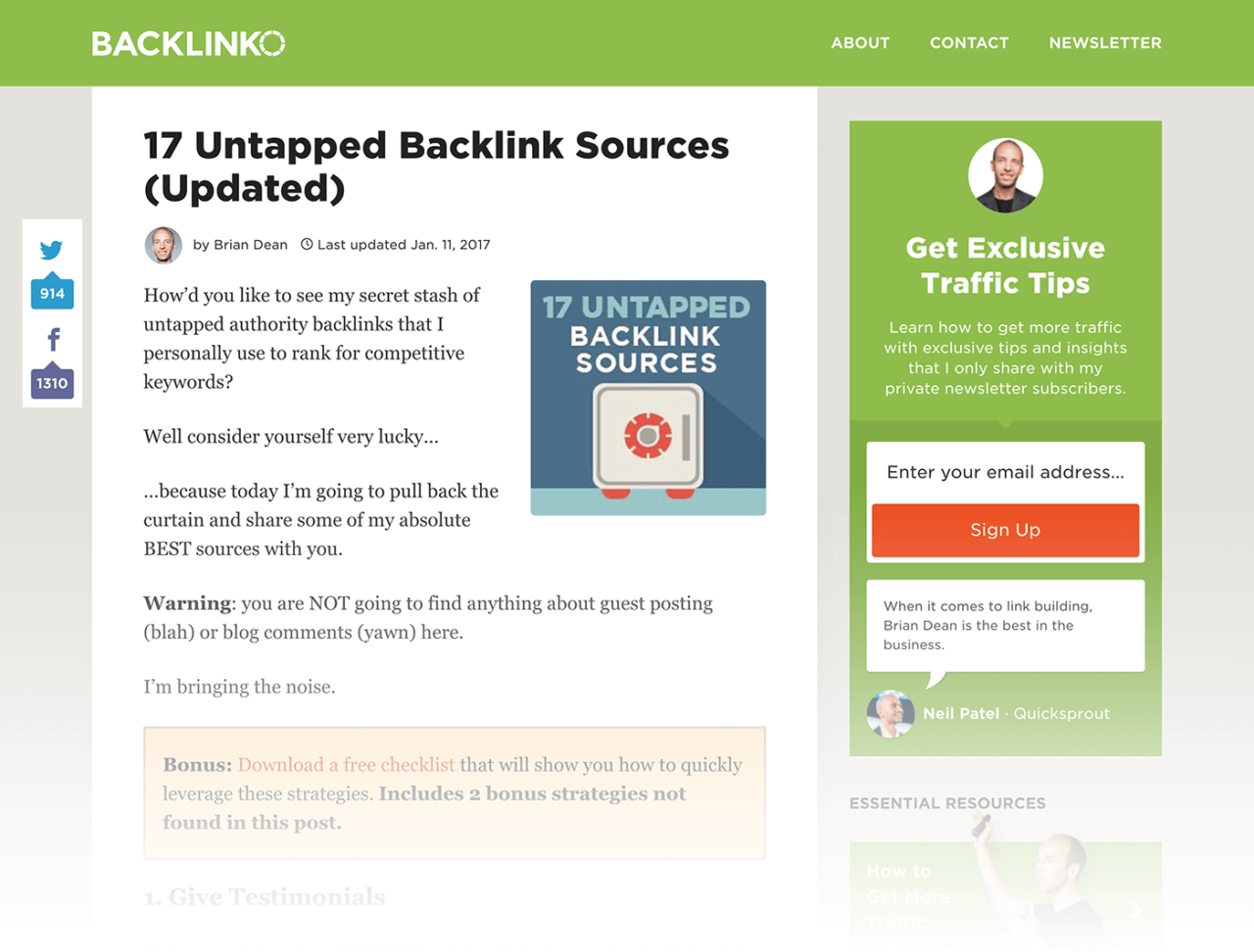
And while it snuck onto the first page for a while, the rankings never stuck.
On the surface, this didn’t make any sense. The content was optimized for that exact keyword. And my page had quite a few really good backlinks too.
But it wouldn’t rank.
Well, as it turns out, that page wouldn’t rank because it didn’t meet Search Intent.
People searching for a broad keyword like “backlinks” aren’t looking for 17 strategies.
Instead, the Search Intent for that keyword is: “I just learned about backlinks and I want to figure out what they are and how they work”.
So I decided to rewrite that post to better match Search Intent.

Today, thanks to my content being a good fit for Search Intent, it now ranks in the top 5 for my target keyword.

Update and Re-Optimize Old Blog Posts
Updating old content is great for users AND search engines.
It’s great for users because 100% of the content on your site is relevant.
(Even posts that you published years ago).
It’s great for search engines because they see that you’re consistently updating and upgrading the content on your site.
For example, every year my team and I update every single post on the site.

It’s a ton of work. But in the end, updating those older posts wind up generating more organic traffic than publishing lots of new stuff.

SEO and Content Marketing Blog Posts

Free SEO and Content Marketing Resources
- Link Building Case Study: How I Increased My Search Traffic by 110% in 14 Days
- How to Write a Blog Post: The Definitive Guide
- SEO Content: The Complete Guide
- How to Build Links With Content Marketing
- We Analyzed 912 Million Blog Posts. Here’s What We Learned About Content Marketing
- The 9-Step SEO Strategy
- Copywriting: The Definitive Guide
Common Questions
Is seo still relevant.
In a word: YES.
The team at SparkToro recently analyzed the web’s top traffic sources for websites .
And they found that Google generated 57.8% of all website traffic (compared to 5.2% for Facebook and 3.4% for Reddit).
So if you’re serious about getting traffic to your website, SEO is key.
How do you write SEO content?
To write SEO content today:
- Each page should be optimized around a single keyword.
- Your content should contain your keyword in your title, description and on your page.
- Your content should be aligned with User Intent.
- Format your content for readability and UX.
- Publish content that provides something different or better than what’s out there.
- Your page should load quickly.
- Mobile users should be able to easily access and read your content.
What are the best SEO strategies?
Here are the best SEO strategies for higher Google rankings :
Find high-volume, low-competition keywords
Implement on-page SEO best practices .
Publish content that meets Search Intent.
Build high-quality backlinks to your website.
Improve your page speed.
Make sure that your site is optimized for mobile SEO .
Optimize your title tag and meta description for CTR.
Use Google Analytics to monitor your results.
How can I improve my SEO?
Here are 10 ways to improve your SEO rankings :
Make sure that your technical SEO is set up correctly.
Find and delete duplicate content from your website.
Publish long-form content using The Skyscraper Technique model.
Use email outreach to build white hat backlinks.
Structure your content to rank in Featured Snippets .
Use a sitemap to help search engines index the pages on your site.
Set up the Google Search Console to monitor indexing and rankings.
Use internal links to send authority to key pages.
Optimize image filenames and alt text.
Implement Schema markup to get Rich Snippets .
It’s a pretty nice type of content. Something fresh and new.
Two questions:
1. Content length of this type of article is much less than what you usually create. Don’t you think it will heart rankings?
2. Or this is the kind of test, where you absolutely satisfy user intent but with less content and answer his question much faster? If yes, it’s going to be interesting.
And thanks for such tests, as always you bring something new. Seriously.
Thanks Vlad. Exactly: this is more of a test to learn from. We’ll see how it goes.
Leave a Comment
Get Backlinks , Website traffic and more... in Google Sheets ? Find out how.. →
SEO Content Editor 4.8
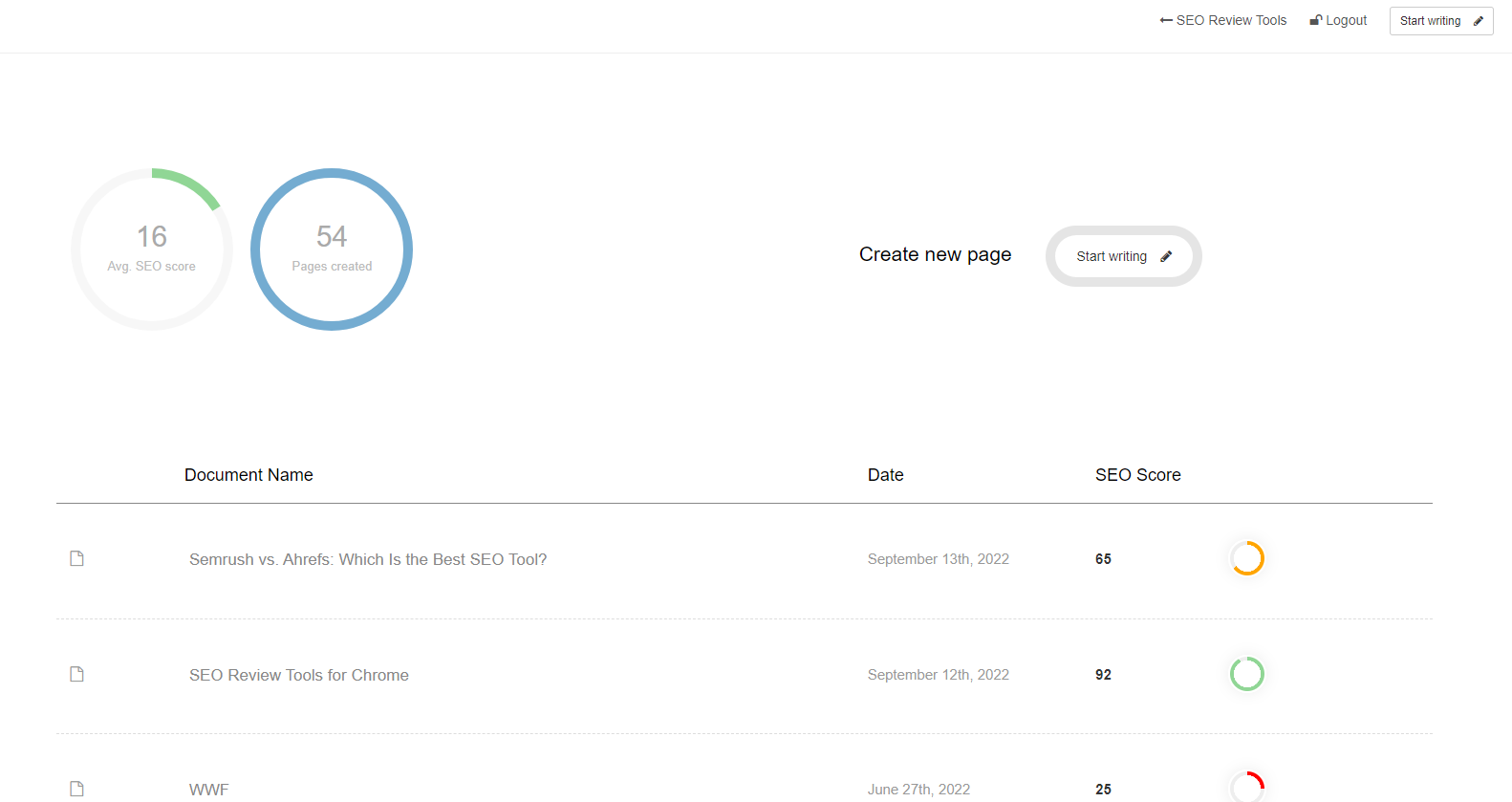
Start Writing content →
The free AI powered writing Assistant
Update : The latest version of the SEO content Assistant comes with an integrated Meta Description generator. Discover more →
The SEO Content Editor is a writing assistant designed to help you optimize content for the web. You can just focus on writing GREAT content while the tool will calculate your SEO score and provides you with valuable feedback on how to improve your content Keyword focus, Page Titles, Meta Descriptions and a lot more… Use the editor to add text, images and YouTube video to write appealing content and when you’re done simply copy / past the result to your CMS of choice.
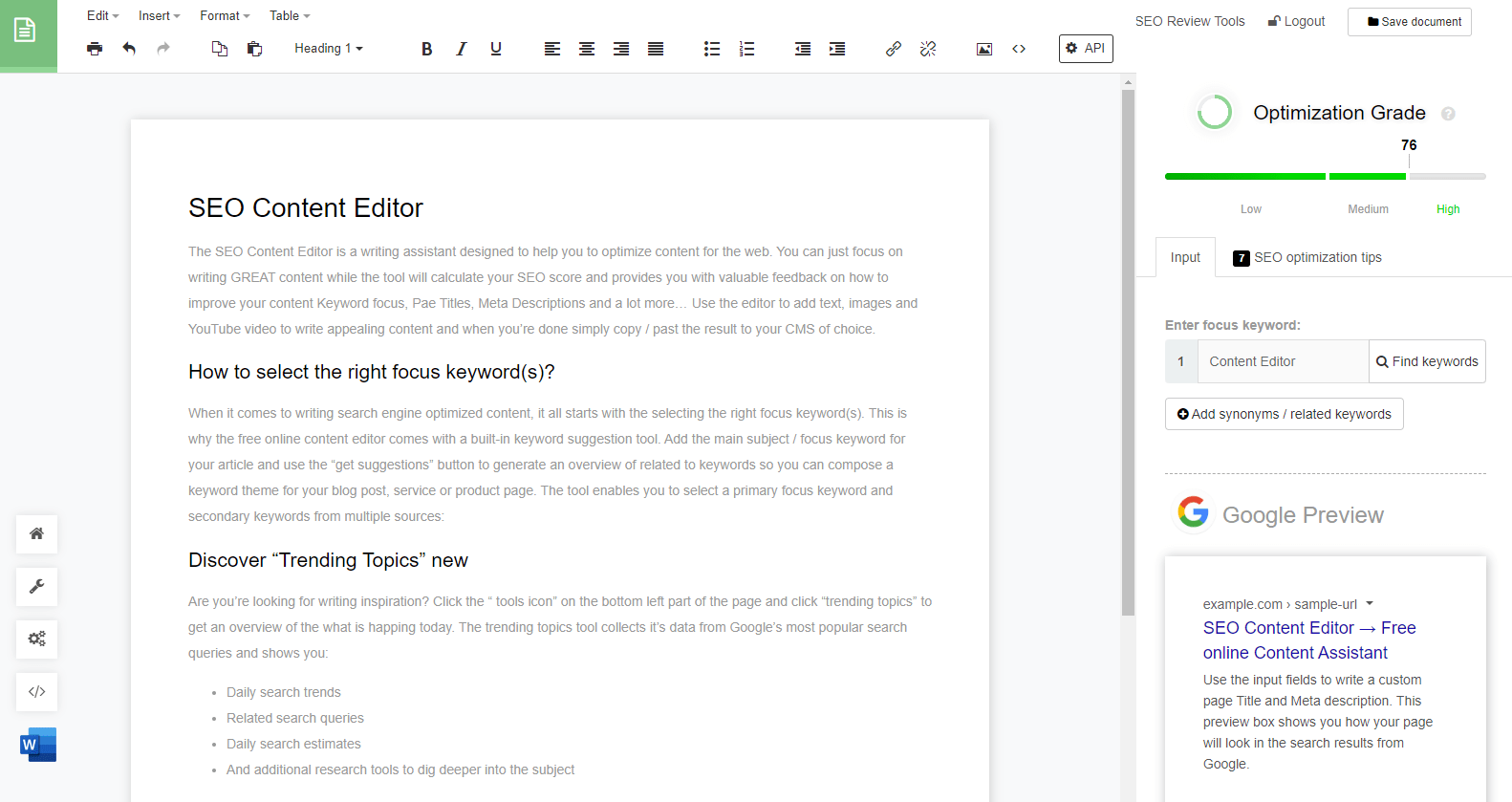
How to select the right focus keyword(s)?
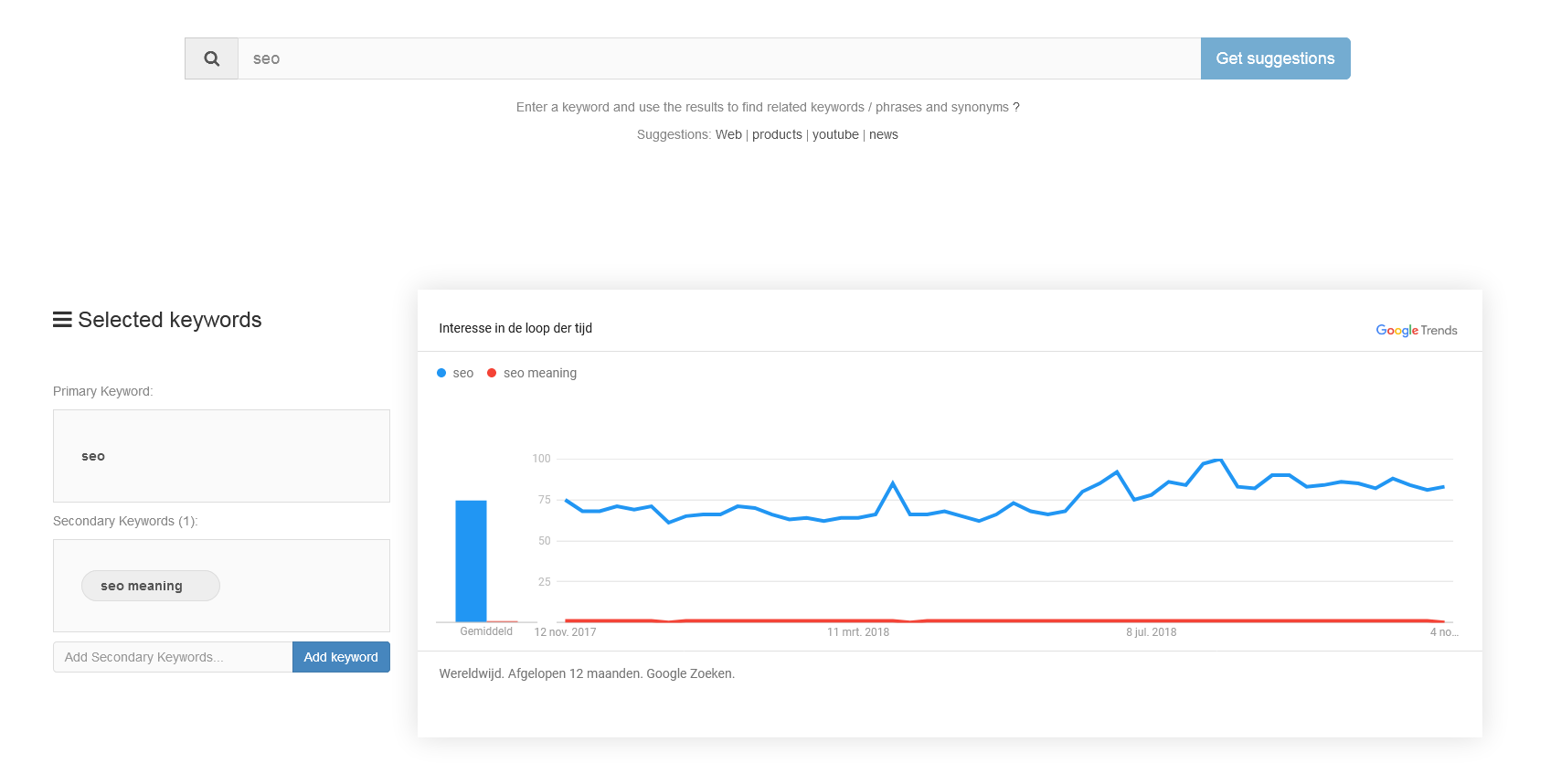
When it comes to writing search engine optimized content, it all starts with the selecting the right focus keyword(s). This is why the free online content editor comes with a built-in keyword suggestion tool. Add the main subject / focus keyword for your article and use the “get suggestions” button to generate an overview of related to keywords so you can compose a keyword theme for your blog post, service or product page. The tool enables you to select a primary focus keyword and secondary keywords from multiple sources:
- Web keyword search suggestions
- Commercial / Shopping keyword suggestions
- YouTube keyword suggestions
- News keyword suggestions
And to give you an indication of the search popularity (measured over time) the tool will render a graph for the selected keyword.
AI writing assistant
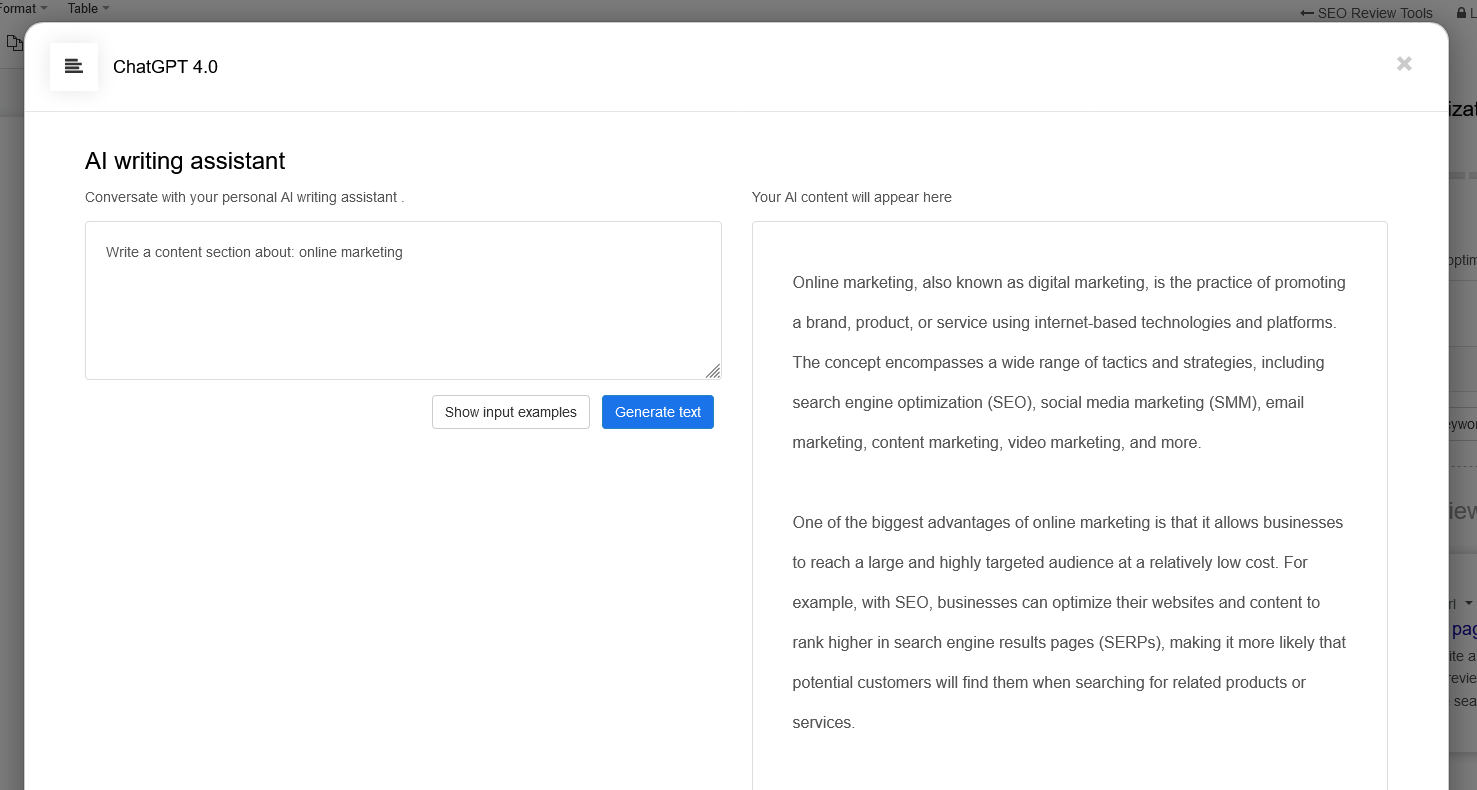
Use the AI writer integration as your personal writing assistant to become more creative and effective. The AI content writer tool includes a list of example commands to automatically generate headlines, blog title suggestions, keyword research, content creation, content completion, content rephrasing and more..
Utilize the power of AI →
Here are some SEO Prompt examples that you can use directly from the interface to connect with AI.
- Suggest 5 blog post title ideas for: [keyword]
- Create a blog outline for: [subject]
- Generate a list of semantic keywords for: [subject]
- Complete: [sentence]
- Rewrite: [content]
- And much more …
While using the benefits of automated content creation you should also be aware of its limitations including the fact that information can be outdated, factually incorrect and the generated content is not always unique.
Start Writing Content →
Content Brief Generator

Use the integrated Content Brief Generator to create a comprehensive content briefing that will guide your content creation process and ensure that you meet your goals and objectives.
How to use the Content Brief generator?
- Enter your topic.
- Select the writing style
- Enter related keywords to use
- Describe your target audience
- Add additioanl commands / instructions
- Use the creativity slider to give the AI some freedom
- Hit the “Create content brief” and let AI perform it’s magic.
Content Brief example The content briefing includes:
- Clear formulated content goal.
- 5 SEO optimized Title suggestions
- A list of directly related keywords
- Statistics related to your subject, crucial for making informed decisions and drawing accurate conclusions.
- Common questions that can help you to optimize for featured snippets in Google search.
Generate a content briefing →
Content Rewriter

The integrated content rewriting tool is designed to quickly rewrite, translate or improve a content section. Navigate to the advanced settings tab to gain even more control over the output by specifying the target audience, language, writing style, and other parameters.
When to use the Content rewriting tool? The content rewriting tool can assist you in various situations to optimize your workflow, here are some examples.
- Rewrite product descriptions to make them unique and to prevent duplicate content
- Create multiple unique versions of a press release customized for your specific target audience.
- Make your content more attractive by changing the writing style
- Detect and correct grammar and spelling errors.
- Effortlessly translate content by selecting the desired output language from a range of 27 supported languages.
Rewrite your content →
FAQ Generator

Generate 5 Q&A’s in just a couple of seconds with AI.
How to use FAQs for SEO?
FAQ stands for frequently asked questions and they can be used to target search queries that your audience is using to find more information about your industry, products, or services. By expanding existing content or by creating new pages that answer these specific questions you’re able to attract more visitors from search.
How to use the FAQ generator?
- Hit the “Generate FAQs” button
- And select the FAQ that are relevant for your article and audience.
Generate FAQs →
How to create FAQs for SEO?
- Create a list of the most common questions your audience is asking or searching for.
- Provide complete and comprehensive answers for these questions.
- Use FAQ schema to markup your questions and answers to make it easier for search engines to show them directly in the SERP.
Why are FAQs important for SEO?
- Optimize for featured snippets in Google and Bing.
- Expand the content of category pages with relevant questions and answers.
- Optimize for the “People also ask” section in Google search.
AI Headline Generator

Use AI to generate 25 different headline suggestions for your article with just a single click. Spark your creativity and write headlines that both capture your reader’s attention and are optimize for search.
How to use the headline generator?
- Enter / describe your topic.
- Hit the “Get headline suggestions” button
- And select the headline that work for your article and audience.
Generate 25 Headline suggestions →
Discover “Trending Topics”

Are you’re looking for writing inspiration? Click the ” tools icon” on the bottom left part of the page and click “trending topics” to get an overview of the what is happing today. The trending topics tool collects it’s data from Google’s most popular search queries and shows you:
- Daily search trends
- Related search queries
- Daily search estimates
- And additional research tools to dig deeper into the subject
The trending topics tool is designed to help you discover emerging search trends so you can be the first one to cover a subject.
Featured snippet generator

Optimize your content for Featured snippets using the question generator. Enter your keyword and the tool will automatically generate up to 50 questions directly related to your subject.
Google displays featured snippets to directly answer a question in search. Featured snippets most commonly contain a small paragraph of text or a list of items that Google extracts from a webpage. Because featured snippets appear above the “regular” search results they can potentially generate more awareness for your brand and earn you more traffic.
AI Content Completion

The “Complete content” function is available when you click on your right mouse button. It allows you to generate suggestions or completions for the current heading or paragraph / text section that you’re writing. This helps you to write faster utilizing the power of generative AI, which performs best when asked to create short form content. The content completion function is an invaluable tool as it not only generates content based on your writing but also replicates your unique writing style and tone of voice.
The benifits
- Content is created based on your unique writing style and brand voice.
- Easy accessible, it just takes a single click to put AI to work.
- Have your personal writing assistant that learns from your input and previous writing.
Write faster →
Title tag generator →
Create 15 Title tag suggestions to optimize your content for search and to attract attention. A well optimized title should ideally →
- Be descriptive
- Contain your focus keyword
- Be less than 60 characters (including spaces and punctuation).
- Capture attention
Start creating Titles →
Meta Description generator → new

Create 15 Meta description suggestions to choose from and to make your search snippet stand out a on the search engine results page (SERP). Write effective meta descriptions →
- That are descriptive and highly relevant for the specific page
- Stand out on the SERP
- Contain ~ 50 and 160 characters (including spaces and punctuation).
Start generating Meta Descriptions →
What others say..

I have been working with the SEO Content Editor of SEO Review Tools for a couple of months now, and I couldn’t be happier that I found it. Jasja chose a very efficient approach when he implemented his tools: Keep it simple! You have a great overview of your content, it is very intuitive, and it reminds you that you need to save your files before closing the tab, which saved my life a couple of times.
Andreas Inama — Founder ai.linguistic solutions
Related APIs
- SEO Content Analysis API →
- Readability score API →
- Keyword Research APIs →
- Text Rewriting API →
Feature list
SEO content checklist:
- Text (keyword density)
- Image alt tag
- Word count / Content length
- Content link count (internal and external)
- Page title length and keyword focus
- Meta description length and keyword focus
Warnings: (Warnings are triggered when over-optimization is detected)
- High keyword density aka Keyword stuffing
- Abnormal link count
Keyword research:
- Web search, Shopping, YouTube and News suggestions
- Google Trends / keyword search popularity
Document export options:
- Export your content including images to Word
- Copy the full document HTML source code
Related Content tools & Resources
- Featured Snippet Tool , Quickly identify featured snippet opportunities related to your main subject / keyword.
- Content idea Generator , Looking for inspiration before you start writing a new blog post? Get up to a 100 content ideas in just a matter of seconds.
- Keyword suggestion tool , Find related keywords and synonyms.
- Rank checker , See how well your content is ranking for multiple keywords.
- SEO Content Score checker , Check the SEO score for any public webpage.
- Keyword frequency checker , See how often keywords are used within the content of an URL or piece of text.
- Yoast API alternative , short introduction to the content analysis API
45 thoughts on “ SEO Content Editor 4.8 ”
Updates The latest version of the SEO content Assistant comes with..
- AI Content rewriter, to rewrite, translate or improve your article.
- AI FAQ generator, to optimized for featured snippets.
- The latest version of the SEO content Assistant comes with an integrated Content brief generator
- The integrated AI content completion tool is now powered by GPT-4
- Updates to the integrated Keyword research tool make it easier to discover related keywords
This one is pretty big ;-)) I’ve integrated ChatGPT into the SEO content editor’s interface. This means you can interact with ChatGPT to get; keyword suggestions, content ideas, translate content and much more… Here is a list of example prompts to help you on your way.
- Write a content section about: [keyword]
- Translate: [content]
- Create content brief for: [topic]
- Generate a list of related questions for: [topic]
- Get related statistics for: [topic] and add the source (URL)
- Add a list of 5 external resources for [subject] including an URL
- To make it easier to optimize your content for featured snippets, the SEO content editor now comes equipped with an integrated question generator.
- Improved copy to HTML option, this button lets you copy your content including HTML markup so you can copy paste the content from the editor to your CMS.
- New language specific keywords and trends settings. Now supporting these countries: United States, Canada, United Kingdom, Netherlands, Belgium (FR), Belgium (NL), Austria, Switzerland, Germany, France, Denmark, Sweden, Norway, Ireland, Italy, Spain, Portugal, Greece, Turkey, Ukraine, Russia, India, China, Thailand, Australia, New Zealand (EN)
- Numerous UX improvements
- Improved visualisation SEO content score and progress visualisation
- Improved UX for the keyword input and research tools (you can now use comma separated values and simply hit the enter button to submit keywords), making the tool much more intuitive.
- Additional code improvements to make the tool quicker and more efficient.
- Fixed a HTML formatting issue that was causing a incorrect keyword density score (under very specific conditions).
Thank you Aldo for reporting this problem.
I love the app very much, but it will be more convenient if you could let user add secondary keyword not one by one, but with coma separated. For example, in the current state, if I would add secondary keywords “wp theme”, “fast wp theme”, I need to add it one by one. It would be better if I just type them directly with coma, like ( wp theme, fast wp theme ) and when I hit enter, all secondary keywords I type in would be there in the box.
Thank you very much
Great suggestion, it’s now on the to-do-list.
Thanks for the valuable feedback!!!
How to view saved documents?
Please click the home icon, located at the left bottom of the page or go to: https://www.seoreviewtools.com/content-dashboard/ (make sure you’re logged in the see all your previously saved documents).
- When performing keyword research you can now enter your focus keyword into the content idea generator and get fresh content ideas
- You can now quickly access the Content analysis API
- You can now export your document to Word, or
- Copy the full HTML source of your document, and quickly past it to your favourite CMS (WordPress, Magento..) without having to redo your markup.
Thanks so much for all the hard work you’ve put into these tools over the past few years, much, much appreciated!
You’re welcome Greg ;-)) And thank you for the support!!
- Just did a major design update to make the content editor more user friendly
- Solved an issue with secondary keyword recognition
- Did some small tweaks to the scoring algorithm (won’t affect the score for well optimized content, but sets a threshold for low quality content)
How to see the document that I’ve already saved?
Hi Erna, to see the documents that you’ve created and saved, please go to “Dashboard” and make sure you’re logged-in (otherwise you won’t have access).
- Keyword tool functionality update – Quickly analyse the keyword suggestions and generate / discover new keyword opportunities.
- Design update – Improved UX to make the keyword tool more effective.
- Solved a caching problem with the dashboard page for registered members.
- Just did a small design update to the editor.
- You can now also incorporate the Content Analysis score into your own custom CMS using the API: https://www.seoreviewtools.com/seo-content-analysis-api/
- Updated meta description maximum length advice. This number is now to back to a maximum recommended length of 160characters based on this advice by Danny Sullivan @Google: https://twitter.com/dannysullivan/status/996065145443893249
- Added an notification to prevent data loss when closing your document.
- Extended meta description maximum length advice to 320 characters
- Now supporting the new Google Trends Graph
These free tools are simply great guys, keep it up!
How do I check the authority of content I have written on my blog? I write long post from scratch but still goes to back pages of google search result. Thanks in advance
Hi Waqas, try the website authority checker: http://www.seoreviewtools.com/website-authority-checker/ to see your backlinks Domain Authority, Page Authority and social share count to get a nice indication how well you’re website is doing authority wise.
Great tool, to make a page SEO friendly!
Great tool!
But I have issues with umlauts like ä. Tested Keyword: “Oberflächentechnik”
The keyword density doesn’t work for this (always 0%). And the “first paragraph” list item never work for me (always no keyword in first paragraph; tested 4 times with different sites / keywords).
Thanks for mentioning this issue. I’ll have a closer look, to figure out a solution.
How do you load images? When I try insert image it doesn’t select anything
Hi charles,
You can use the “Insert/edit image” button and then past the image URL. You can’t upload an image, but you can use images that are already published online.
Hi, is it possible to delete some old posts?
Hi karibusana, at this moment you’re not able to delete old posts, because I simply haven’t had the time to build this functionality. But you can change: the keyword, title and content of an older post to keep using the tool.
Please keep in mind that the old post will removed from the dashboard overview.
Can I save more than 25 documents ?
Hi Ibnuhibban,
I’ve set 25 documents as a temporary limit for now. But you can reuse your current document by simply choosing a new keyword and add the corresponding text to get a relevant SEO Content score for your article.
Hey Jasja…
Thanks !! Following your advice as I am completely new to SEO but learning slowly.
Very nice tools.
Can you please let us upload an logo and customise for a report?
Thanks for the feedback. This will probably be a feature for the payed version. And to be realistic this will take me at least a couple of months.
Update 06/01/2016 :
- You can now save 25 documents
Update 05/23/2016 :
- Reset the Meta Description (back to 160 characters) and Title (back to 60 characters).
- You can now check the status of the meta Description and Title in real-time when writing or adjusting. The feedback will let you know if you need to do modifications for a better SEO Content score.
- Save your documents and go to the dashboard to get an general overview of your average SEO Content score for the number of pages you have created.
- You can login and access the dashboard using your free SEO Review Tools account.
Update 05/09/2016
- Added a special characters box to make your meta description and HTML Title stand out from the crowd ➊ ➋ ➌✔
- The Google search preview is now shown by default.
- Improved ending (…) Meta description and HTML Titles
- Faster SEO score update when adding new elements (Title, keywords, etc.)
- Highlight secondary keyword matches
- Save button always available on screen (UX improvement)
- Made it easier to save a document by launching Title modal when empty page title.
- Fixed some minor scoring issues
Update 04/13/2016 :
- Save your content / optimized pages
- Improved design
how to make h1 on the post title ?
Just select the text you’d like to transform into a H1 and use the “Paragraph” dropdown and select “Heading 1”.
Leave a Reply Cancel reply
Your email address will not be published. Required fields are marked *

Numbers and stats
Registered Members
Avg. tool rating
Monthly visitors
Returning visitors


VIDEO
COMMENTS
SEO writing (also known as "writing for SEO") is the process of planning, creating, and optimizing content with the primary goal of ranking in search engines like Google. It includes taking steps like keyword research, crafting top-notch content aligned with user intent, and organizing content under headers to allow for page crawling.
SEO content writing is the process of creating high-quality content for websites that is relevant to readers and helps websites get found more easily by search engines. The term "content" refers to any words, images, audio, or other elements you include on a webpage. SEO content writing specifically deals with the words that are published ...
1. Find a winning keyword. If no one is searching for the topic you're writing about, you won't get search traffic no matter how high you rank. So, the first step to creating SEO content is to do keyword research. Here's how to get started: Go to Keywords Explorer. Enter a broad term from your niche.
Crafting SEO content is about giving searchers what they want and making it "sticky.". If you can share unique insights and expertise on top of that, even better. Let's go through the process in more detail. 1. Choose a proven topic. You should already have a proven topic if you've done keyword research.
2. Add keywords strategically in your SEO content. We mentioned the importance of using keywords naturally and you should. Yet, if at all possible, aim to include them at least once in each of the following: Using keywords strategically helps search engines confirm the topic and depth of your content.
Content SEO refers to creating content that helps your web pages to rank high in the search engines. It includes everything, from writing to structuring the content on your website. There are three major elements you need to consider that will make your website rank well: keyword strategy, site structure and copywriting.
Make sure your text is readable. A few ways to improve your writing style. Take a break now and then. Phase 3 of the SEO copywriting process: Editing your text. Step 1: Read slowly (and out loud) Step 2: Focus on sentences. Step 3: Focus on paragraphs. Step 4: Check the text structure. Step 5: Ask for feedback.
Tips for Incorporating SEO Writing Into Your Content Marketing Strategy. The entire process may seem a bit daunting at first, but there are some simple steps you can use to incorporate SEO writing into your content marketing strategy. While it may be helpful to completely revamp your entire work of copy, your team can start by adding important ...
SEO writing is the process of writing content to rank high in search engines like Google, for related keywords. This is done by doing keyword research and writing SEO-optimized and helpful content relevant to the user's search intent. ... Thank you for this incredibly helpful guide on SEO writing! Your 12 easy tips provide a clear roadmap for ...
Search engines, social trends, and SEO techniques are constantly changing and evolving, so good SEO writing does the same. Always be aware of the most recent changes to Google's algorithm and current web user tastes when it comes to their content. Update your go-to approach to SEO writing accordingly. 4.
SEO content is content created to help your site's pages rank higher in search results. Creating content for SEO involves keyword research, content writing, and more. When it comes to dynamic duos in digital marketing, you can't beat search engine optimization (SEO) and content marketing.
7 Content Optimization Tips to Try Today. Now that you have a baseline understanding of the role SEO plays content marketing and business strategy, let's put it into practice in your writing. Use these SEO content writing tips when fleshing out your strategy: 1. Write for humans first, algorithms second. 2.
Search Engine Optimization (SEO) Starter Guide. When you built your website, you likely created it with your users in mind, trying to make it easy for them to find and explore your content. One of those users is a search engine, which helps people discover your content. SEO—short for search engine optimization—is about helping search ...
Laying the Groundwork for SEO Success. SEO writing is the process of crafting content to rank well in engines like Google. The journey begins with writing high-quality content that resonates with your audience and adheres to SEO best practices, laying a solid foundation for online visibility and success.
Types of SEO content. SEO content can include any of the following: Product pages - These are the bread and butter of any retail e-commerce site. A good product page can serve as both SEO content and a PPC landing page.; Blog posts - A blog is one of the easiest ways to create a regular stream of effective SEO content.In general, blog posts are more engaging and more likely to attract ...
A good SEO writing best practice is to keep your URL short (under 60 characters) and include your primary keyword as an exact match keyword phrase. For example, the URL for this guide is simply, /seo-content-writing-tips/. 22. Add Relevant Schema Markup to the Content.
SEO content writing is essential because it helps websites rank higher in SERPs, driving more organic traffic to the site. This can lead to increased brand awareness, more leads and conversions, and ultimately, more revenue for the business. In addition, SEO content writing can also improve the user experience on a website, making it more ...
Website Copy Content Writing Tips. Remember that website copy has a longer shelf life than almost any other content medium. Try sticking to evergreen topics and statements that will remain true indefinitely. (Unless you plan on regularly updating your website copy.) Avoid massive blocks of chunky text.
SEO Writing Tips & Guidelines to Make Your Content Go Further. 1. Write for your audience first. This SEO content writing tip is number one for a reason. It seems easy enough, yet so many companies make content for all the wrong reasons. Write content that appeals to the interests of your target market or answers their questions.
Content Marketing. Content Writing 101 Tips, strategies and advanced techniques. Copywriting Discover best practices, get insights; Blog SEO Learn how to optimize your blog for search engines. SEO Content Techniques to rank #1 in Google; Best Tools. Best SEO Tools We have tested and reviewed 177+ free and paid tools.
Search Engine Land is your source for SEO news and content. You'll find a variety of up-to-date and authoritative resources, including the latest news, tactic-rich tutorials, and the latest data ...
Start Writing content → . The free AI powered writing Assistant. Update: The latest version of the SEO content Assistant comes with an integrated Meta Description generator.Discover more →. The SEO Content Editor is a writing assistant designed to help you optimize content for the web. You can just focus on writing GREAT content while the tool will calculate your SEO score and provides you ...
29 likes, 17 comments - rahmathulsajitha on April 1, 2024: "Free Blog Guide !!!! [content writing, content marketing, copywriting, marketing, social media, networking ...